Paul van Yperen's Blog, page 93
March 17, 2023
Julia Roberts
American actress Julia Roberts (1967) won more than 30 other acting awards including an Academy Award for her leading role in Erin Brockovich (2000) plus Oscar nominations for Steel Magnolias (1989), Pretty Woman (1990) and August: Osage County (2013). Her films have grossed more than $3.9 billion globally, making her one of the most bankable film stars of all time.
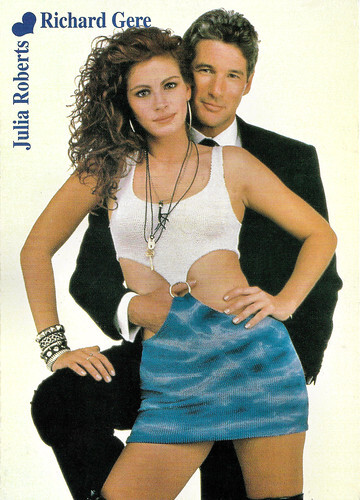
Italian postcard in the Solo Belli series by Edizioni Eden, Milano, no. 1. Julia Roberts and Richard Gere in Pretty Woman (Garry Marshall, 1990).

French postcard, no. C 186.

Italian postcard by Citrus Promotion, no. 0424. Photo: Universal / Working Title. Julia Roberts in Notting Hill (Richard Curtis, 1999).
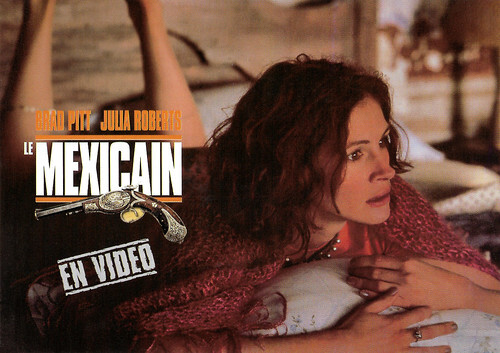
French postcard by Dreamworks L.L.C. and Pistolero Productions. Photo: Dreamworks L.L.C. Julia Roberts in The Mexican (Gore Verbinski, 2001).
An ill-fated would-be mother
Julia Fiona Roberts was born in Smyrna, Georgia, a suburb of Atlanta, in 1967. Julia is the youngest of three children of Walter Grady Roberts and Betty Lou Bredemus, one-time actors and playwrights. Her parents were close friends with Martin Luther King and Coretta Scott King. Walter and Betty Lou Roberts ran the Actors and Writers Workshop, then the only integrated drama school in Atlanta, which the Kings' eldest daughter Yolanda King attended. The Kings paid the hospital bill for Julia's birth.
When Roberts was four years old., her parents divorced. Her brother Eric stayed with his father and Julia and her sister Lisa continued to live with their mother in Atlanta. When Roberts was nine, her father died of cancer. As a child, due to her love of animals, Julia originally wanted to be a veterinarian, but later studied journalism. Her parents were in the drama club, so acting was soon in the cards.
Her brother Eric Roberts was originally seen as the great acting promise of the family but ended up producing more quantity than quality in the eyes of critics. Sister Lisa is not actually a professional actress but has since appeared in twenty-four films in small supporting roles, mostly in titles by her younger sister. While at school, Roberts worked as a waitress in a pizzeria and spent some time behind the cash register in a supermarket. When Eric achieved some success in Hollywood, Julia decided to try acting.
She started taking acting classes and went to live with her sister in New York where she signed with the Click Modeling Agency. She took speech lessons to get rid of her southern accent. She made her film debut with a bit role in Blood Red (Peter Masterson, 1989), starring her brother Eric Roberts, which was completed in 1986 but wouldn't be released until 1989. She appeared in several television features and series, including Miami Vice (1988).
Her first break came in 1988 when she appeared in two youth-oriented films Mystic Pizza (Donald Petrie, 1988) and Satisfaction (Joan Freeman, 1988). It helped her earn the credentials she needed to land the part of Shelby, an ill-fated would-be mother in the comedy-drama Steel Magnolias (Herbert Ross, 1989). The tearjerker found her acting alongside Sally Field and Shirley MacLaine which culminated in an Oscar nomination for Roberts. Then followed the supernatural thriller Flatliners (Joel Schumacher, 1990) with her then-flame Kiefer Sutherland.
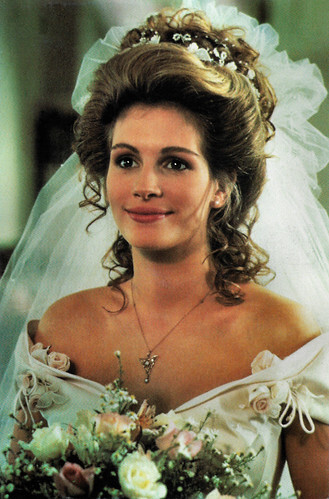
French postcard. Julia Roberts in Steel Magnolias (Herbert Ross, 1989).

British postcard by Heroes LTD., no. SPC 2349. Photo: Touchstone Pictures. Publicity still for Pretty Woman (Garry Marshall, 1990).
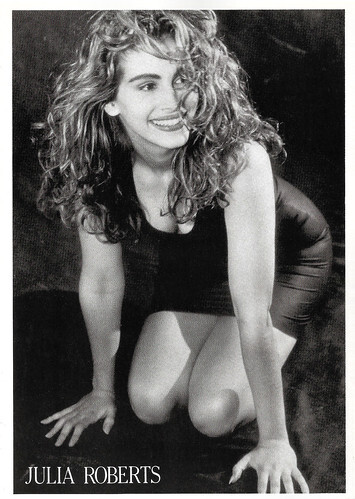
French postcard, Réf. 822.

French postcard, Réf. 944.
A good-hearted Hollywood prostitute who falls in love with a millionaire client
Julia Robert's biggest early success was in the romantic comedy Pretty Woman (Garry Marshall, 1990) with Richard Gere. Originally intended to be a dark cautionary tale about class and prostitution in Los Angeles, the film was re-conceived as a romantic comedy with a large budget. Critic Roger Ebert: "Roberts does an interesting thing; she gives her character an irrepressibly bouncy sense of humor and then lets her spend the movie trying to repress it. Actresses who can do that and look great can have whatever they want in Hollywood."
Julia got an Oscar nomination and also won the People's Choice award for Favorite Actress. Pretty Woman was widely successful at the box office and was the third-highest-grossing film of 1990. Julia's part as a good-hearted Hollywood prostitute who falls in love with a millionaire client was her definitive breakthrough role.
Her role opposite Denzel Washington in the John Grisham adaptation The Pelican Brief (Alan J. Pakula, 1993), reaffirmed her status as a dramatic actress. Even though Julia would spend the next few years either starring in serious films or playing fantasy roles like Tinkerbell in Steven Spielberg's Hook (1991), filmgoers would always love Julia best in romantic comedies such as Notting Hill (Richard Curtis, 1999) with Hugh Grant , and Runaway Bride (Garry Marshall, 1999) with Richard Gere .
In My Best Friend's Wedding (P.J. Hogan, 1997), she starred opposite Dermot Mulroney, Cameron Diaz and Rupert Everett , as a food critic who realizes she's in love with her best friend and tries to win him back after he decides to marry someone else. The cult comedy gave the genre some fresh life that had been lacking in Hollywood for some time.
Roger Ebert: "One of the pleasures of Ronald Bass' screenplay is the way it subverts the usual comic formulas that would fuel a plot like this. It makes the Julia Roberts character sympathetic at first, but eventually her behavior shades into cruel meddling. Stories like this are tricky for the actors. They have to be light enough for the comedy, and then subtle in revealing the deeper tones. Roberts, Diaz and Mulroney are in good synch, and Roberts does a skillful job of negotiating the plot's twists: We have to care for her even after we stop sharing her goals."

Italian postcard by Citrus Promotion, no. 0426. Photo: Universal / Working Title. Julia Roberts and Hugh Grant in Notting Hill (Richard Curtis, 1999).

Italian postcard by Citrus Promotion, no. 0423. Photo: Universal / Working Title. Julia Roberts and Hugh Grant in Notting Hill (Richard Curtis, 1999).
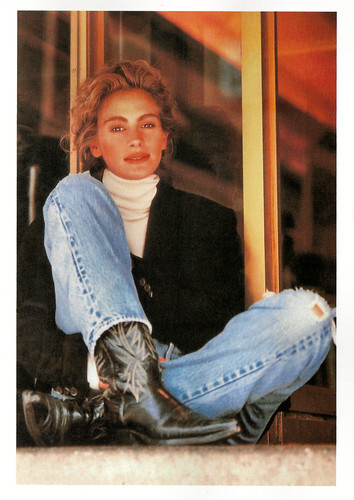
Spanish postcard by Cacitel / Grafica in the Colección 'Estrellas cinematográficas', no. 52.
A single mother wins a heated battle against corporate environmental offenders
Julia Roberts' had her biggest success when she delivered an Oscar-winning performance playing the title role in Erin Brockovich (Steven Soderbergh, 2000). The film, based on the true story of Erin Brockovich, a single mother who, against all odds, won a heated battle against corporate environmental offenders, earned Roberts a staggering 20-million-dollar salary.
The next year, Roberts starred in the crime caper Ocean's Eleven (Steven Soderbergh, 2001), in which she acted with Brad Pitt , Matt Damon, and George Clooney . A success with critics and at the box office alike, Ocean's Eleven became the fifth highest-grossing film of the year with a total of $450 million worldwide. In 2004, Roberts signed on for the sequel, the aptly titled Ocean's Twelve (Steven Soderbergh, 2004).
In 2006, she made her Broadway debut alongside Paul Rudd and Bradley Cooper in the revival of Richard Greenberg's play 'Three Days of Rain', but the production was not a success. Roberts teamed with Tom Hanks for Charlie Wilson's War (Mike Nichols, 2007), and then again for Larry Crowne (Tom Hanks, 2011). In between, she gave a critically acclaimed performance in Eat, Pray, Love (Ryan Murphy, 2010), in which she portrayed a divorcee on a journey of self-discovery.
In 2012, she played Snow White's evil stepmother in Mirror, Mirror (Tarsem Singh, 2012). Roberts starred alongside Meryl Streep and Ewan McGregor in the black comedy drama August: Osage County (John Wells, 2013) about a dysfunctional family that reunites in the familial house when their patriarch suddenly disappears. Her performance earned her her fourth Academy Award nomination.
Julia Roberts was in a relationship with actor Kiefer Sutherland for a while. In 1991, their relationship ended five days before they got married. She married country singer Lyle Lovett in 1993 but divorced him in 1995. She met her second husband, cameraman Danny Moder while shooting the film the road gangster comedy The Mexican (Gore Verbinski, 2000) with Brad Pitt . Roberts and Moder married in 2002 in Taos, New Mexico. Together they had twins in 2004, a daughter, Hazel Patricia, and a son, Phinnaeus 'Finn' Walter. In 2007, Roberts gave birth to their third child, Henry Daniel. All the children were given their father's surname.
Julia Roberts also became involved with UNICEF charities and has made visits to many different countries, including Haiti and India, in order to promote goodwill. On-screen, she appeared in Jodie Foster 's thriller Money Monster (2016), the coming-of-age drama Wonder (Steven Chbosky, 2017), and the romantic comedy Ticket to Paradise (Ol Parker, 2022) with George Clooney . She received a Primetime Emmy Award nomination for the television adaptation of Larry Kramer's AIDS-era play The Normal Heart (Larry Murphy, 2014), had her first regular television role in the first season of the psychological thriller series Homecoming (2018), and portrayed Martha Mitchell opposite Sean Penn as United States Attorney General John Mitchell in the political thriller series Gaslit (Matt Ross, 2022) about the Watergate Scandal.

French postcard, no. C 266.
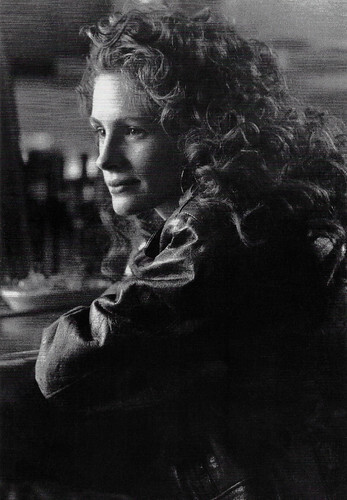
British postcard, no. 1001.
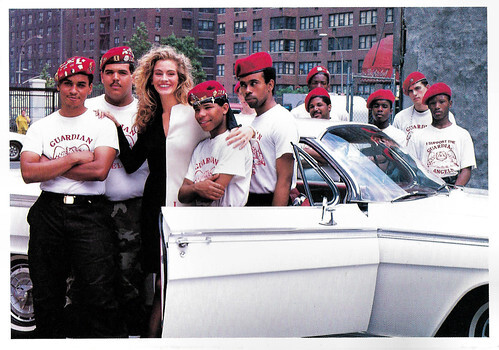
French postcard by Photomania, Paris, no. P474. Photo: Jonathan Lennard. Caption: Julia and the angels.
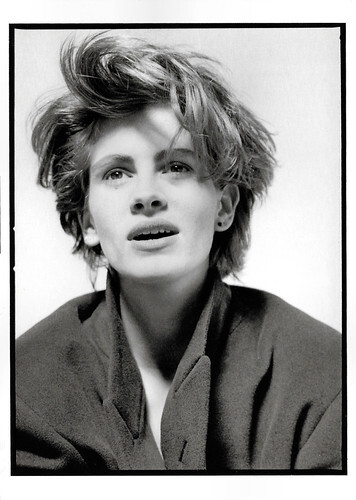
American postcard by Fotofolio, no. P430. Photo: Brigitte Lacombe.
Sources: Roger Ebert (Roger Ebert.com), Tracie Cooper (AllMovie), (IMDb), Wikipedia (Dutch and English) and .

Italian postcard in the Solo Belli series by Edizioni Eden, Milano, no. 1. Julia Roberts and Richard Gere in Pretty Woman (Garry Marshall, 1990).

French postcard, no. C 186.

Italian postcard by Citrus Promotion, no. 0424. Photo: Universal / Working Title. Julia Roberts in Notting Hill (Richard Curtis, 1999).

French postcard by Dreamworks L.L.C. and Pistolero Productions. Photo: Dreamworks L.L.C. Julia Roberts in The Mexican (Gore Verbinski, 2001).
An ill-fated would-be mother
Julia Fiona Roberts was born in Smyrna, Georgia, a suburb of Atlanta, in 1967. Julia is the youngest of three children of Walter Grady Roberts and Betty Lou Bredemus, one-time actors and playwrights. Her parents were close friends with Martin Luther King and Coretta Scott King. Walter and Betty Lou Roberts ran the Actors and Writers Workshop, then the only integrated drama school in Atlanta, which the Kings' eldest daughter Yolanda King attended. The Kings paid the hospital bill for Julia's birth.
When Roberts was four years old., her parents divorced. Her brother Eric stayed with his father and Julia and her sister Lisa continued to live with their mother in Atlanta. When Roberts was nine, her father died of cancer. As a child, due to her love of animals, Julia originally wanted to be a veterinarian, but later studied journalism. Her parents were in the drama club, so acting was soon in the cards.
Her brother Eric Roberts was originally seen as the great acting promise of the family but ended up producing more quantity than quality in the eyes of critics. Sister Lisa is not actually a professional actress but has since appeared in twenty-four films in small supporting roles, mostly in titles by her younger sister. While at school, Roberts worked as a waitress in a pizzeria and spent some time behind the cash register in a supermarket. When Eric achieved some success in Hollywood, Julia decided to try acting.
She started taking acting classes and went to live with her sister in New York where she signed with the Click Modeling Agency. She took speech lessons to get rid of her southern accent. She made her film debut with a bit role in Blood Red (Peter Masterson, 1989), starring her brother Eric Roberts, which was completed in 1986 but wouldn't be released until 1989. She appeared in several television features and series, including Miami Vice (1988).
Her first break came in 1988 when she appeared in two youth-oriented films Mystic Pizza (Donald Petrie, 1988) and Satisfaction (Joan Freeman, 1988). It helped her earn the credentials she needed to land the part of Shelby, an ill-fated would-be mother in the comedy-drama Steel Magnolias (Herbert Ross, 1989). The tearjerker found her acting alongside Sally Field and Shirley MacLaine which culminated in an Oscar nomination for Roberts. Then followed the supernatural thriller Flatliners (Joel Schumacher, 1990) with her then-flame Kiefer Sutherland.

French postcard. Julia Roberts in Steel Magnolias (Herbert Ross, 1989).

British postcard by Heroes LTD., no. SPC 2349. Photo: Touchstone Pictures. Publicity still for Pretty Woman (Garry Marshall, 1990).

French postcard, Réf. 822.

French postcard, Réf. 944.
A good-hearted Hollywood prostitute who falls in love with a millionaire client
Julia Robert's biggest early success was in the romantic comedy Pretty Woman (Garry Marshall, 1990) with Richard Gere. Originally intended to be a dark cautionary tale about class and prostitution in Los Angeles, the film was re-conceived as a romantic comedy with a large budget. Critic Roger Ebert: "Roberts does an interesting thing; she gives her character an irrepressibly bouncy sense of humor and then lets her spend the movie trying to repress it. Actresses who can do that and look great can have whatever they want in Hollywood."
Julia got an Oscar nomination and also won the People's Choice award for Favorite Actress. Pretty Woman was widely successful at the box office and was the third-highest-grossing film of 1990. Julia's part as a good-hearted Hollywood prostitute who falls in love with a millionaire client was her definitive breakthrough role.
Her role opposite Denzel Washington in the John Grisham adaptation The Pelican Brief (Alan J. Pakula, 1993), reaffirmed her status as a dramatic actress. Even though Julia would spend the next few years either starring in serious films or playing fantasy roles like Tinkerbell in Steven Spielberg's Hook (1991), filmgoers would always love Julia best in romantic comedies such as Notting Hill (Richard Curtis, 1999) with Hugh Grant , and Runaway Bride (Garry Marshall, 1999) with Richard Gere .
In My Best Friend's Wedding (P.J. Hogan, 1997), she starred opposite Dermot Mulroney, Cameron Diaz and Rupert Everett , as a food critic who realizes she's in love with her best friend and tries to win him back after he decides to marry someone else. The cult comedy gave the genre some fresh life that had been lacking in Hollywood for some time.
Roger Ebert: "One of the pleasures of Ronald Bass' screenplay is the way it subverts the usual comic formulas that would fuel a plot like this. It makes the Julia Roberts character sympathetic at first, but eventually her behavior shades into cruel meddling. Stories like this are tricky for the actors. They have to be light enough for the comedy, and then subtle in revealing the deeper tones. Roberts, Diaz and Mulroney are in good synch, and Roberts does a skillful job of negotiating the plot's twists: We have to care for her even after we stop sharing her goals."

Italian postcard by Citrus Promotion, no. 0426. Photo: Universal / Working Title. Julia Roberts and Hugh Grant in Notting Hill (Richard Curtis, 1999).

Italian postcard by Citrus Promotion, no. 0423. Photo: Universal / Working Title. Julia Roberts and Hugh Grant in Notting Hill (Richard Curtis, 1999).

Spanish postcard by Cacitel / Grafica in the Colección 'Estrellas cinematográficas', no. 52.
A single mother wins a heated battle against corporate environmental offenders
Julia Roberts' had her biggest success when she delivered an Oscar-winning performance playing the title role in Erin Brockovich (Steven Soderbergh, 2000). The film, based on the true story of Erin Brockovich, a single mother who, against all odds, won a heated battle against corporate environmental offenders, earned Roberts a staggering 20-million-dollar salary.
The next year, Roberts starred in the crime caper Ocean's Eleven (Steven Soderbergh, 2001), in which she acted with Brad Pitt , Matt Damon, and George Clooney . A success with critics and at the box office alike, Ocean's Eleven became the fifth highest-grossing film of the year with a total of $450 million worldwide. In 2004, Roberts signed on for the sequel, the aptly titled Ocean's Twelve (Steven Soderbergh, 2004).
In 2006, she made her Broadway debut alongside Paul Rudd and Bradley Cooper in the revival of Richard Greenberg's play 'Three Days of Rain', but the production was not a success. Roberts teamed with Tom Hanks for Charlie Wilson's War (Mike Nichols, 2007), and then again for Larry Crowne (Tom Hanks, 2011). In between, she gave a critically acclaimed performance in Eat, Pray, Love (Ryan Murphy, 2010), in which she portrayed a divorcee on a journey of self-discovery.
In 2012, she played Snow White's evil stepmother in Mirror, Mirror (Tarsem Singh, 2012). Roberts starred alongside Meryl Streep and Ewan McGregor in the black comedy drama August: Osage County (John Wells, 2013) about a dysfunctional family that reunites in the familial house when their patriarch suddenly disappears. Her performance earned her her fourth Academy Award nomination.
Julia Roberts was in a relationship with actor Kiefer Sutherland for a while. In 1991, their relationship ended five days before they got married. She married country singer Lyle Lovett in 1993 but divorced him in 1995. She met her second husband, cameraman Danny Moder while shooting the film the road gangster comedy The Mexican (Gore Verbinski, 2000) with Brad Pitt . Roberts and Moder married in 2002 in Taos, New Mexico. Together they had twins in 2004, a daughter, Hazel Patricia, and a son, Phinnaeus 'Finn' Walter. In 2007, Roberts gave birth to their third child, Henry Daniel. All the children were given their father's surname.
Julia Roberts also became involved with UNICEF charities and has made visits to many different countries, including Haiti and India, in order to promote goodwill. On-screen, she appeared in Jodie Foster 's thriller Money Monster (2016), the coming-of-age drama Wonder (Steven Chbosky, 2017), and the romantic comedy Ticket to Paradise (Ol Parker, 2022) with George Clooney . She received a Primetime Emmy Award nomination for the television adaptation of Larry Kramer's AIDS-era play The Normal Heart (Larry Murphy, 2014), had her first regular television role in the first season of the psychological thriller series Homecoming (2018), and portrayed Martha Mitchell opposite Sean Penn as United States Attorney General John Mitchell in the political thriller series Gaslit (Matt Ross, 2022) about the Watergate Scandal.

French postcard, no. C 266.

British postcard, no. 1001.

French postcard by Photomania, Paris, no. P474. Photo: Jonathan Lennard. Caption: Julia and the angels.

American postcard by Fotofolio, no. P430. Photo: Brigitte Lacombe.
Sources: Roger Ebert (Roger Ebert.com), Tracie Cooper (AllMovie), (IMDb), Wikipedia (Dutch and English) and .
Published on March 17, 2023 23:00
March 16, 2023
Lewis Waller
British actor Lewis Waller (1860-1915) was best known as a matinee idol in the popular romantic plays of his day. His types were the handsaome, triumphant heroes, ready to make love to every pretty woman and skilled in the use of sword and rapier. Although Waller himself loved playing Shakespeare roles like Romeo, Othello, and Henry V, his most profitable plays were always his swashbuckling romances. The good-looking actor attracted large female audiences who made themselves in a fan club known as the K.O.W. (Keen On Waller) Brigade. Waller also worked as a playwright and a stage manager and appeared in a few early British films.
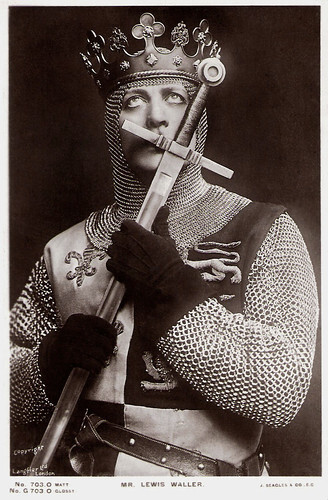
British postcard by J. Beagles & Co, E.C., no. G 703 O. Photo: Langfler Ltd. Lewis Waller as Henry V, in the eponymous Shakespeare play.
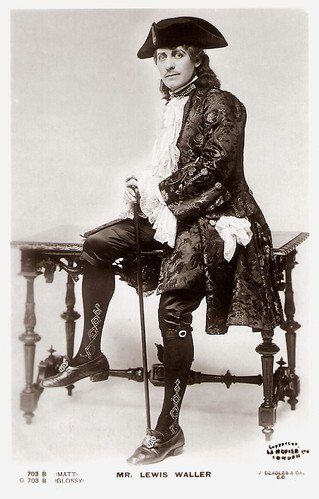
British postcard by J. Beagles & Co, E.C., no. 703 B. Photo: Langfler Ltd., London.
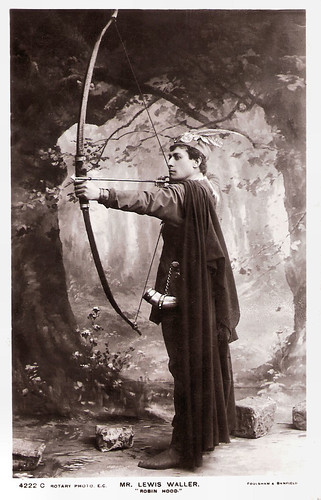
British postcard by Rotary Photo, E.C., no. 4222 C. Photo: Foulsham & Banfield. Publicity still for the stage production 'Robin Hood' (1906).
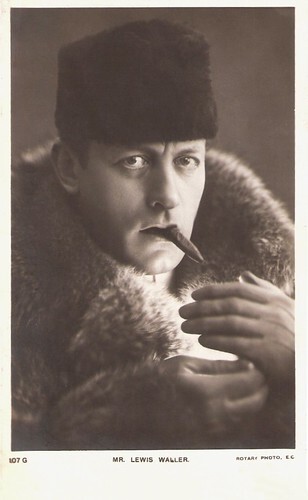
British postcard by Rotary Photo, EC, no. 107 G. Sent by mail in 1905.
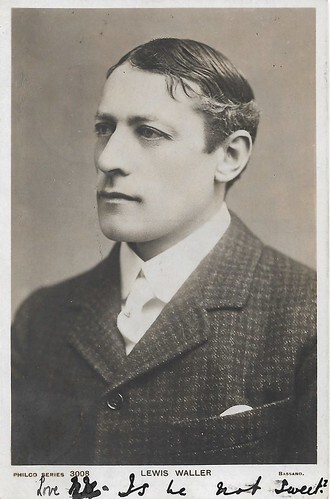
British postcard in the Philco Series, no. 3008. Photo: Bassano. Written on the card: Love. Is he not sweet?
Vigorous Acting
Lewis Waller was born William Waller Lewis in Bilbao, Spain, in 1860, the eldest son of an English civil engineer, William James Lewis, and his wife, Carlotta née Vyse. He was educated at King's College School in south west London, after which, intending to pursue a commercial career, he studied languages on the continent.
From 1879 to 1883 he was a clerk in a London firm owned by his uncle. In 1882 he married Florence Isabella Brandon (1858–1912), who shortly afterwards became a professional actress under the name of Florence West. They had a son and a daughter. After acting in amateur performances, Waller decided to make a career on the stage and was engaged by J. L. Toole in 1883.
He first appeared on the London stage in 1883. His debut was as the Hon. Claude Lorrimer in H. J. Byron's 'Uncle Dick's Darling', in which he was billed as "Waller Lewis". By May of the same year, he had adopted the stage name Lewis Waller. He got his start in the companies of the famous Dame Helena Modjeska and J. L. Toole.
Waller came to the front with a fine performance as Buckingham in 'The Three Musketeers' under legendary English actor Herbert Beerbohm Tree 's management at His Majesty's in 1895.Soon afterwards Waller organised a company of his own, first at the Haymarket and afterwards at other theatres. His fine voice and vigorous acting earned him critical acclaim in a number of Shakespeare roles, such as the title character in 'Henry V', Brutus in 'Julius Caesar', and Faulkenbridge in 'King John'.
He had his greatest successes, however, in romantic roles, such as 'Monsieur Beaucaire', a dramatic adaptation of Booth Tarkington's novel. Waller also created the role of Sir Robert Chiltern in Oscar Wilde’s 'An Ideal Husband' (1895). His wife, Florence West, appeared often with Waller in his most successful romances. The critic Hesketh Pearson praised Waller for "his good looks [and] his virile acting and his vibrant voice" which "rang through the theatre like a bell and stirred like a trumpet".
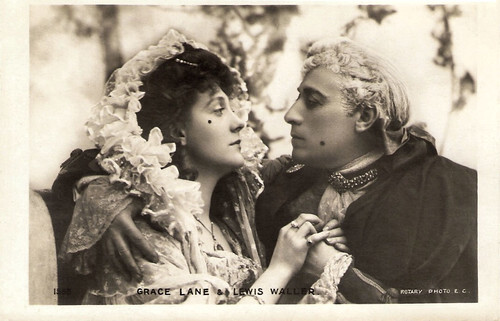
Grace Lane and Lewis Waller. British postcard, no. 1595. Photo: Rotary Photo.
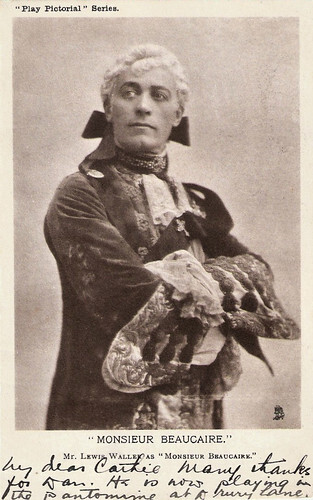
British postcard by Raphael Tuck & Sons in the Play Pictorial Series, no. 5A. Photo: publicity still for the stage play 'Monsieur Beaucaire'.
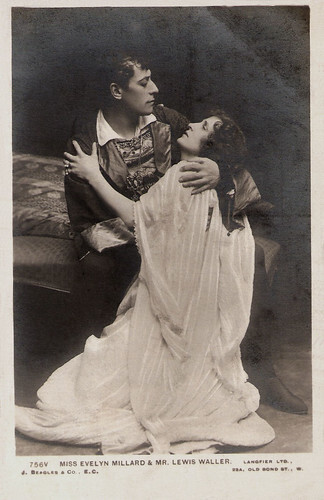
British postcard by J. Beagles & Co., London, no. 756V. Photo: Langfier Ltd. Lewis Waller and Evelyn Millard.
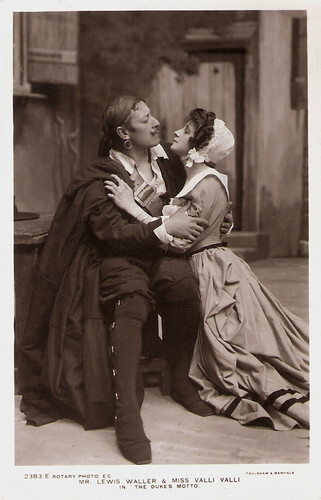
British postcard by Rotary Photo, E.C., no. 2183 E. Photo: Foulsham & Banfield. Publicity still for the stage play 'The Duke's Motto' (1908) with Lewis Waller and Valli Valli.
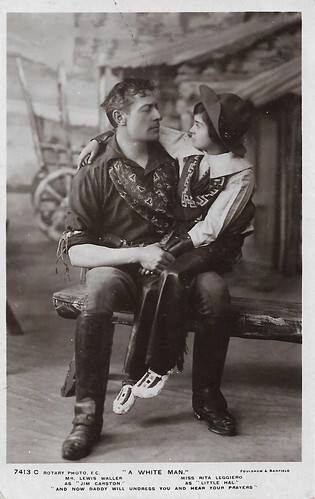
British postcard by Rotary Photo, E.C., no. 7413 Photo: C. Foulsham & Banfield. Lewis Waller as Jim Carston in the play 'A White Man'. On his lap, Miss Rita Leggiero as his son, Little Hal. Caption: And now daddy will undress you and hear your prayers.
Fires of Fate
In 1899 Lewis Waller appeared as Philip Faulconbridge in the short film drama King John (Walter Pfeffer Dando, William K.L. Dickson, 1899), based on a scene from William Shakespeare 's play. 'King John' was played by Sir Herbert Beerbohm Tree .
After the turn of the century, he returned to management, and remained an actor-manager for the rest of his career, both in London and on tour. Fifteen years later, Waller played the title role in the American historical film drama Brigadier Gerard (Bert Haldane, 1915), an adaptation of Sir Arthur Conan Doyle’s novel. In 1907 and 1911, Waller made a small number of recordings for the Gramophone Company, including Tennyson's 'Charge of the Light Brigade' and the speech from Shakespeare's 'Henry V'.
Two of his plays were filmed after his death. His play 'Fires of Fate', based on another novel by Arthur Conan Doyle, 'The Tragedy of Korosco', was filmed, Fires of Fate (Tom Terriss, 1923) with Wanda Hawley, Nigel Barrie and Stewart Rome.
Finally, Maurice Elvey directed Waller’s adaptation of the historical novel 'Henry, King of Navarre' by Alexandre Dumas père , Henry, King of Navarre (Maurice Elvey, 1924) starring Matheson Lang and Henry Victor.
In 1911 and 1912, Waller made a tour of the US, Canada and Australia. In his absence, his wife, Florence West, died. In 1915, Lewis Waller died from double pneumonia, in Nottingham, England, just two days shy of his fifty-fifth birthday. Their son Edmund Waller was also an actor.
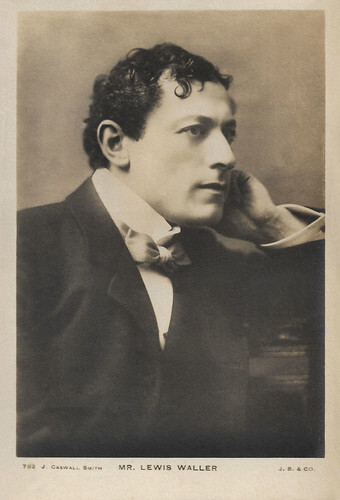
British postcard by J. Beagles & Co., London, no. 782. Photo: J. Caswall Smith.
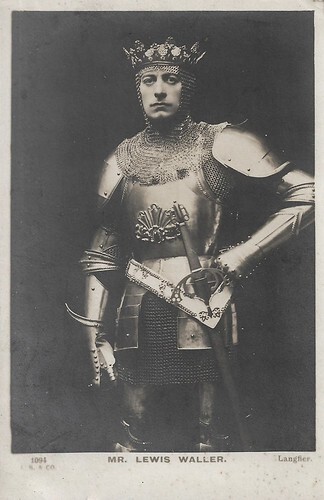
British postcard by J. Beagles & Co.,London, no. 1094. Photo: Louis Saul Langfier. Lewis Waller as Henry V (1900).
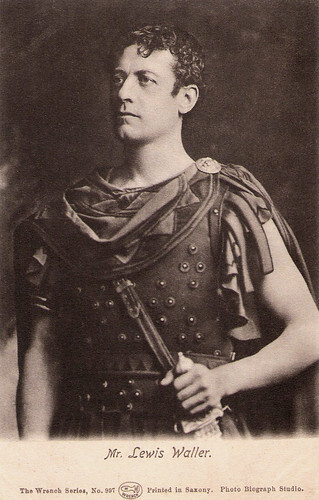
British postcard in The Wrench series, printed in Saxony, no. 997. Photo: Biograph Studio.
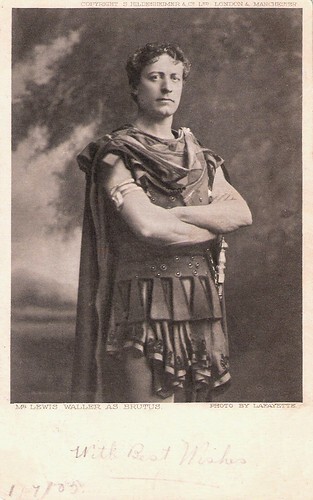
British postcard by E. Hildesheimer & Co, London/Manchester. Sent by mail in 1905. Photo: Lafayette. Waller in his stage role as Brutus in 'Julius Caesar'.
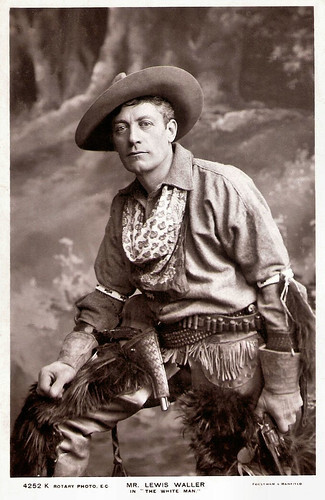
British postcard by Rotary Photo, no. 4252 K. Sent by mail in 1908. Photo: Foulsham & Banfield. Publicity still for the play 'The White Man' (1908). In this play, based on the Western play 'The Squaw Man' (1905) by Edwin Milton Royle, Lewis Waller appeared as Cowboy Bronco Buster at the Lyric Theatre in London. In the cast, there were also several American performers.
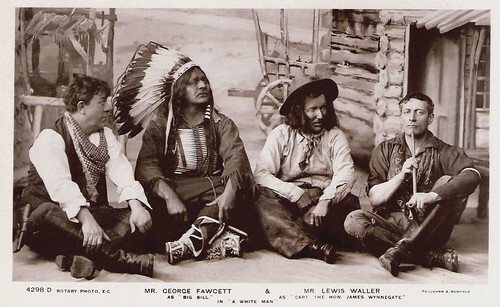
British postcard by Rotary Photographic Series, no. 4298 D. Photo: Foulsham & Banfield. Publicity still for the play 'A White Man' (1908). This play, based on the Western play 'The Squaw Man' (1905) by Edwin Milton Royle, was presented at the Lyric Theatre in London.
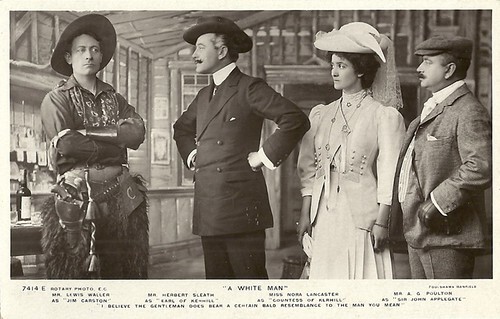
British postcard by Rotary Photo, no. E.C., 7414 E. Foulsham & Banfield. Lewis Waller as Jim Carston in the play 'A White Man', also with Herbert Sleath as the Earl of Kerhill, Nora Lancaster as the Countess of Kerhill, and A.G. Poullton as Sir John Applegate. Caption: I believe the gentleman does bear a certain resemblance to the man you mean.
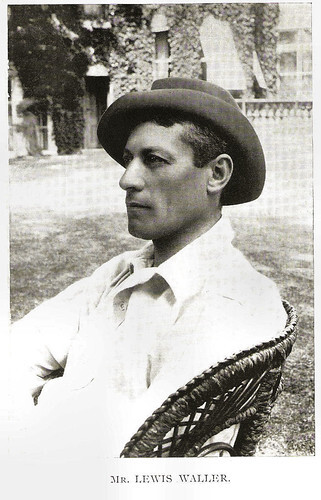
British postcard By "My Queen"& "Romance" Novelettes. Caption: One penny weekly. Two Picture Postcards presented with each copy.
Sources: Harry Rusche (Shakespeare & The Players), and Wikipedia.

British postcard by J. Beagles & Co, E.C., no. G 703 O. Photo: Langfler Ltd. Lewis Waller as Henry V, in the eponymous Shakespeare play.

British postcard by J. Beagles & Co, E.C., no. 703 B. Photo: Langfler Ltd., London.

British postcard by Rotary Photo, E.C., no. 4222 C. Photo: Foulsham & Banfield. Publicity still for the stage production 'Robin Hood' (1906).

British postcard by Rotary Photo, EC, no. 107 G. Sent by mail in 1905.

British postcard in the Philco Series, no. 3008. Photo: Bassano. Written on the card: Love. Is he not sweet?
Vigorous Acting
Lewis Waller was born William Waller Lewis in Bilbao, Spain, in 1860, the eldest son of an English civil engineer, William James Lewis, and his wife, Carlotta née Vyse. He was educated at King's College School in south west London, after which, intending to pursue a commercial career, he studied languages on the continent.
From 1879 to 1883 he was a clerk in a London firm owned by his uncle. In 1882 he married Florence Isabella Brandon (1858–1912), who shortly afterwards became a professional actress under the name of Florence West. They had a son and a daughter. After acting in amateur performances, Waller decided to make a career on the stage and was engaged by J. L. Toole in 1883.
He first appeared on the London stage in 1883. His debut was as the Hon. Claude Lorrimer in H. J. Byron's 'Uncle Dick's Darling', in which he was billed as "Waller Lewis". By May of the same year, he had adopted the stage name Lewis Waller. He got his start in the companies of the famous Dame Helena Modjeska and J. L. Toole.
Waller came to the front with a fine performance as Buckingham in 'The Three Musketeers' under legendary English actor Herbert Beerbohm Tree 's management at His Majesty's in 1895.Soon afterwards Waller organised a company of his own, first at the Haymarket and afterwards at other theatres. His fine voice and vigorous acting earned him critical acclaim in a number of Shakespeare roles, such as the title character in 'Henry V', Brutus in 'Julius Caesar', and Faulkenbridge in 'King John'.
He had his greatest successes, however, in romantic roles, such as 'Monsieur Beaucaire', a dramatic adaptation of Booth Tarkington's novel. Waller also created the role of Sir Robert Chiltern in Oscar Wilde’s 'An Ideal Husband' (1895). His wife, Florence West, appeared often with Waller in his most successful romances. The critic Hesketh Pearson praised Waller for "his good looks [and] his virile acting and his vibrant voice" which "rang through the theatre like a bell and stirred like a trumpet".

Grace Lane and Lewis Waller. British postcard, no. 1595. Photo: Rotary Photo.

British postcard by Raphael Tuck & Sons in the Play Pictorial Series, no. 5A. Photo: publicity still for the stage play 'Monsieur Beaucaire'.

British postcard by J. Beagles & Co., London, no. 756V. Photo: Langfier Ltd. Lewis Waller and Evelyn Millard.

British postcard by Rotary Photo, E.C., no. 2183 E. Photo: Foulsham & Banfield. Publicity still for the stage play 'The Duke's Motto' (1908) with Lewis Waller and Valli Valli.

British postcard by Rotary Photo, E.C., no. 7413 Photo: C. Foulsham & Banfield. Lewis Waller as Jim Carston in the play 'A White Man'. On his lap, Miss Rita Leggiero as his son, Little Hal. Caption: And now daddy will undress you and hear your prayers.
Fires of Fate
In 1899 Lewis Waller appeared as Philip Faulconbridge in the short film drama King John (Walter Pfeffer Dando, William K.L. Dickson, 1899), based on a scene from William Shakespeare 's play. 'King John' was played by Sir Herbert Beerbohm Tree .
After the turn of the century, he returned to management, and remained an actor-manager for the rest of his career, both in London and on tour. Fifteen years later, Waller played the title role in the American historical film drama Brigadier Gerard (Bert Haldane, 1915), an adaptation of Sir Arthur Conan Doyle’s novel. In 1907 and 1911, Waller made a small number of recordings for the Gramophone Company, including Tennyson's 'Charge of the Light Brigade' and the speech from Shakespeare's 'Henry V'.
Two of his plays were filmed after his death. His play 'Fires of Fate', based on another novel by Arthur Conan Doyle, 'The Tragedy of Korosco', was filmed, Fires of Fate (Tom Terriss, 1923) with Wanda Hawley, Nigel Barrie and Stewart Rome.
Finally, Maurice Elvey directed Waller’s adaptation of the historical novel 'Henry, King of Navarre' by Alexandre Dumas père , Henry, King of Navarre (Maurice Elvey, 1924) starring Matheson Lang and Henry Victor.
In 1911 and 1912, Waller made a tour of the US, Canada and Australia. In his absence, his wife, Florence West, died. In 1915, Lewis Waller died from double pneumonia, in Nottingham, England, just two days shy of his fifty-fifth birthday. Their son Edmund Waller was also an actor.

British postcard by J. Beagles & Co., London, no. 782. Photo: J. Caswall Smith.

British postcard by J. Beagles & Co.,London, no. 1094. Photo: Louis Saul Langfier. Lewis Waller as Henry V (1900).

British postcard in The Wrench series, printed in Saxony, no. 997. Photo: Biograph Studio.

British postcard by E. Hildesheimer & Co, London/Manchester. Sent by mail in 1905. Photo: Lafayette. Waller in his stage role as Brutus in 'Julius Caesar'.

British postcard by Rotary Photo, no. 4252 K. Sent by mail in 1908. Photo: Foulsham & Banfield. Publicity still for the play 'The White Man' (1908). In this play, based on the Western play 'The Squaw Man' (1905) by Edwin Milton Royle, Lewis Waller appeared as Cowboy Bronco Buster at the Lyric Theatre in London. In the cast, there were also several American performers.

British postcard by Rotary Photographic Series, no. 4298 D. Photo: Foulsham & Banfield. Publicity still for the play 'A White Man' (1908). This play, based on the Western play 'The Squaw Man' (1905) by Edwin Milton Royle, was presented at the Lyric Theatre in London.

British postcard by Rotary Photo, no. E.C., 7414 E. Foulsham & Banfield. Lewis Waller as Jim Carston in the play 'A White Man', also with Herbert Sleath as the Earl of Kerhill, Nora Lancaster as the Countess of Kerhill, and A.G. Poullton as Sir John Applegate. Caption: I believe the gentleman does bear a certain resemblance to the man you mean.

British postcard By "My Queen"& "Romance" Novelettes. Caption: One penny weekly. Two Picture Postcards presented with each copy.
Sources: Harry Rusche (Shakespeare & The Players), and Wikipedia.
Published on March 16, 2023 23:00
March 15, 2023
Four early Italian films: Iris (1914), La corsa all'abisso (1914), 'La dama del castillo negro' (S.A.), and Fra uomini e belve (1913)
EFSP presents today four Spanish collectors card series for early Italian silent films. The four films were made by different studios: Iris (Achille Consalvi, 1914) was produced by Aquila Films, La corsa all'abisso (1914) by Milano Films, 'La dama del castillo negro' (S.A.) Ambrosio, and Fra uomini e belve (1914) by Cines. All cards were collected by Ivo Blom.
Iris (1914)
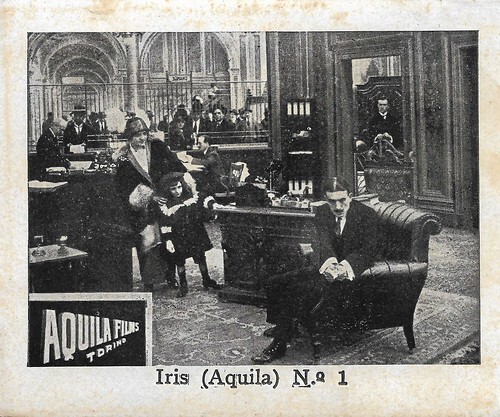
Spanish collectors card by Chocolate Amatller, Barcelona, no. 1 of 6. Photo: Aquila Films. Scene from Iris (Achille Consalvi, 1914).
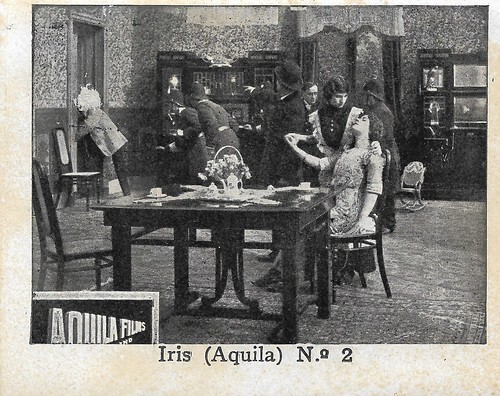
Spanish collectors card by Chocolate Amatller, Barcelona, no. 2 of 6. Photo: Aquila Films. Scene from Iris (Achille Consalvi, 1914).
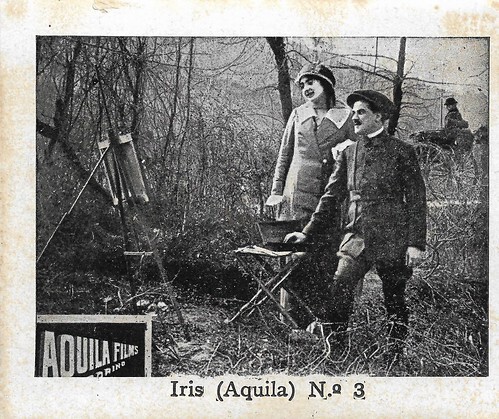
Spanish collectors card by Chocolate Amatller, Barcelona, no. 3 of 6. Photo: Aquila Films. Scene from Iris (Achille Consalvi, 1914).
A fraudulent, criminal bank cashier who becomes a murderer
Iris (Achille Consalvi, 1914) starts with a fraudulent, criminal bank cashier, who fakes a robbery at the bank in order to save himself from ruin. Discovered by a night watch, he kills the man.
After twenty years, Arturo, the son of the cashier, falls in love with the daughter of the murdered night watch, Iris, who has become an acclaimed actress. He spends large sums to impress his girlfriend and asks his mother for money. The mother lives abroad in a villa.
The homicidal husband suddenly shows up again and is informed by a ragpicker how to best rob the villa of his wife, helped by the crony's little girl. When his lamp goes off during the robbery and he hits a piece of furniture, the wife is alarmed and almost killed by her own man. The girl assists in the killing and is so terrified she falls ill.
Yet, it is the lady's son Arturo who is accused of the failed homicide. Instead, Iris, taking care of the girl, finds with her a note from the ragpicker explaining who is the real culprit. During a stage show in honour of Iris, the thief invites Iris to a party, where she unmasks him as the culprit. In the end, he dies from a bomb.
It is unknown who were the actors in this film. Iris was released in Italy in May 1914. The plot is deducted from a review of the film in the journal La Vita Cinematografica.
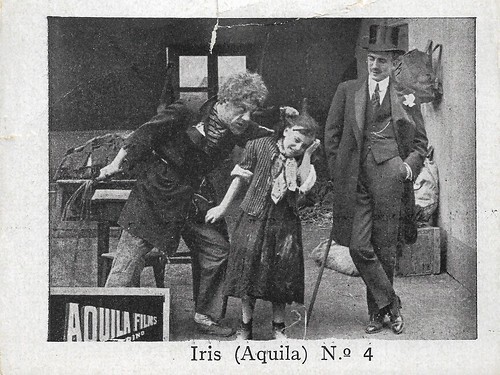
Spanish collectors card by Chocolate Amatller, Barcelona, no. 4 of 6. Photo: Aquila Films. Scene from Iris (Achille Consalvi, 1914).
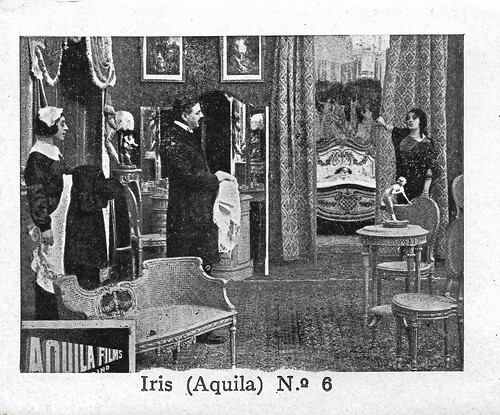
Spanish collectors card by Chocolate Amatller, Barcelona, no. 6 of 6. Photo: Aquila Films. Scene from Iris (Achille Consalvi, 1914).
La corsa all'abisso (1914)

Spanish collectors card by Reclam Films, Mallorca, no. 1 of 6. Photo: Milano Films. Mercedes Brignone and Antonio De Vergillius in La corsa all'abisso/The Pace That Kills (Attilio Fabbri, 1914).
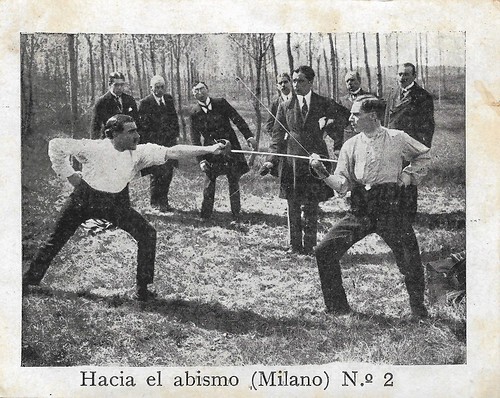
Spanish collectors card by Reclam Films, Mallorca, no. 2 of 6. Photo: Milano Films. Duel in La corsa all'abisso/The Pace That Kills (Attilio Fabbri, 1914).
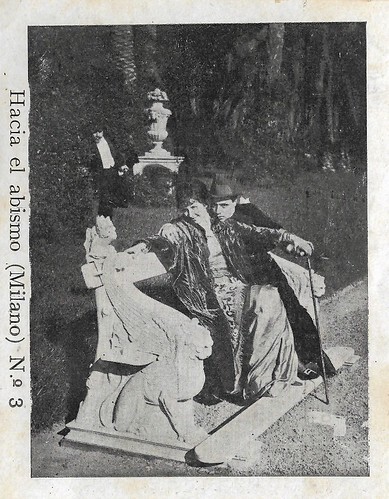
Spanish collectors card by Reclam Films, Mallorca, no. 3 of 6. Photo: Milano Films. Scene of La corsa all'abisso/The Pace That Kills (Attilio Fabbri, 1914).
Fatally pushed towards the abyss of rejection and misery
Italian actress Mercedes Brignone stars in the drama La corsa all'abisso/The Pace That Kills (Attilio Fabbri, 1914) as Lydia.
At the time of the premiere, the journal Il Maggese Cinematografico wrote that Lydia, a poor girl who once became like a dragonfly, lets herself be burned by the lamp of illusion.
In the end, she dies in the arms of her former lover, a poor artist, who really loved her and lived in the dark, but whom she, blinded by the corrupting light, had discarded, and thus was fatally pushed towards the abyss of rejection and misery.
Il Maggese Cinematografico predicted that even the most sceptical souls would be touched by this death scene. Both Il Maggese Cinematografico and La Vita Cinematografica praised the performance knowing well to perform the merry ingenuity as well as the fright and grief of the protagonist.
Attilio De Virgiliis played Brignone's rich lover, while the poor painter may have been played by Camillo Apolloni. The cinematography was by Carlo Montuori.
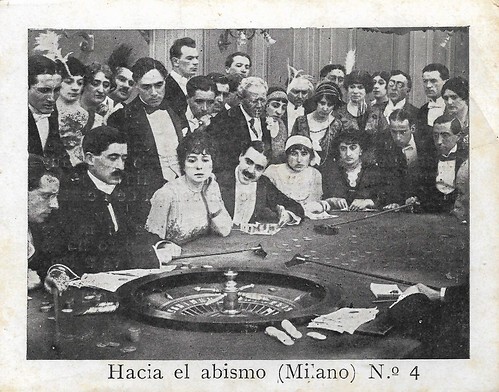
Spanish collectors card by Reclam Films, Mallorca, no. 4 of 6. Photo: Milano Films. Mercedes Brignone and Attilio De Virgiliis in La corsa all'abisso/The Pace That Kills (Attilio Fabbri, 1914).
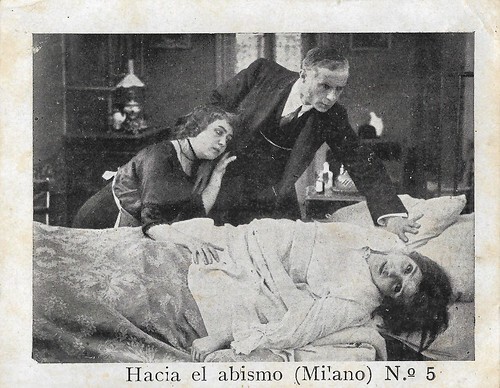
Spanish collectors card by Reclam Films, Mallorca, no. 5 of 6. Photo: Milano Films. Mercedes Brignone in La corsa all'abisso/The Pace That Kills (Attilio Fabbri, 1914).
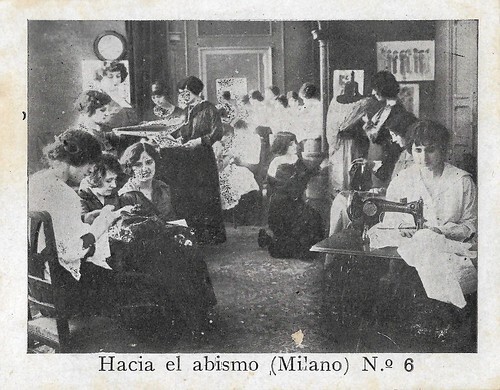
Spanish collectors card by Reclam Films, Mallorca, no. 6 of 6. Photo: Milano Films. Scene from La corsa all'abisso/The Pace That Kills (Attilio Fabbri, 1914).
'La dama del Castillo Negro' (S.A.)
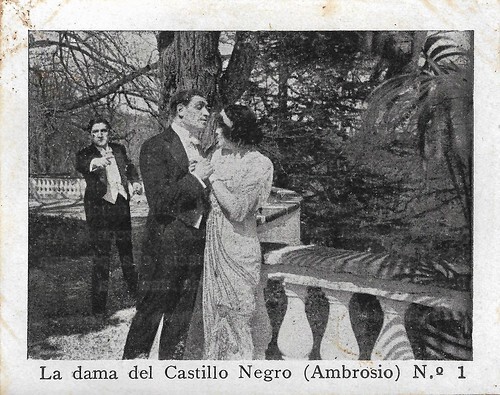
Spanish collector's card by Reclam Film, Mallorca, no. 1 of 6. Photo: Ambrosio. La dama del Castillo Negro is the Spanish title of a hitherto unidentified Italian production.
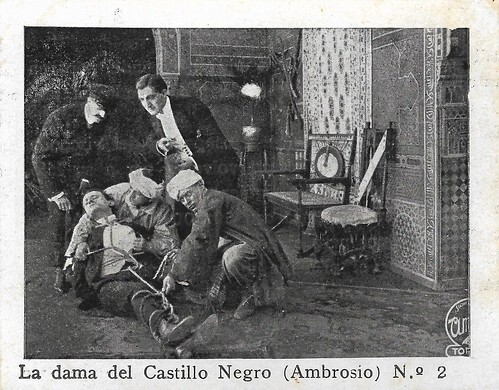
Spanish collector's card by Reclam Film, Mallorca, no. 2 of 6. Photo: Ambrosio. La dama del Castillo Negro is the Spanish title of a hitherto unidentified Italian production.
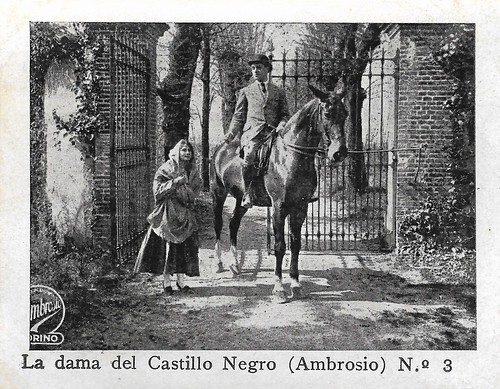
Spanish collector's card by Reclam Film, Mallorca, no. 3 of 6. Photo: Ambrosio. La dama del Castillo Negro is the Spanish title of a hitherto unidentified Italian production.
A rendezvous at the black castle
La dama del Castillo Negro is the Spanish title of a hitherto unidentified Italian production by Ambrosio Film from the early 1910s. We identified the leading actress Antonietta Calderari, as well as the actors Alfredo Bertone and Orlando Ricci.
In the plot on the cards, the main characters are named Sarha, the Prince of Koepic, Viscount Albert and policeman Harrison. The Prince of Koepic needs money and so his cousin Sarha (Antonietta Calderari) has to seduce Viscount Albert (Bertone).
Albert gives her a rendezvous at the black castle, where he is tied up and the prince asks his parents for a sum of 50,000 francs to free him. The prince's gang steals the sum and demands another 50,000, so the parents go to the policeman Harrison who goes to a hotel to catch the ring, but the prince sets fire to the hotel.
At a party, Harrison meets Sarha. Koepic finds out that Sarha is taking Harrison to the castle and so Koepic gets Harrison caught as well. Yet, Sarah has fallen so in love with Albert that Koepic wants to kill her. So she frees the two but they are pursued by Koepic and his gang. Sarah manages to throw the whole gang into a well, but as they fall, the prince shoots Sarah, who dies in the arms of her Albert.
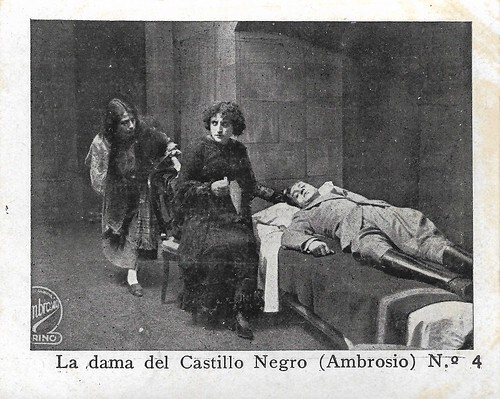
Spanish collector's card by Reclam Film, Mallorca, no. 4 of 6. La dama del Castillo Negro is the Spanish title of a hitherto unidentified Italian production by Ambrosio Film from the early 1910s.
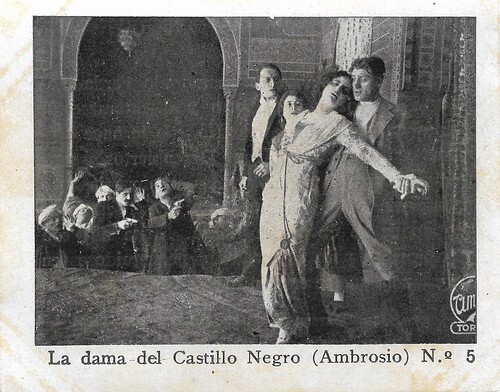
Spanish collector's card by Reclam Film, Mallorca, no. 5 of 6. La dama del Castillo Negro is the Spanish title of a hitherto unidentified Italian production by Ambrosio Film from the early 1910s.
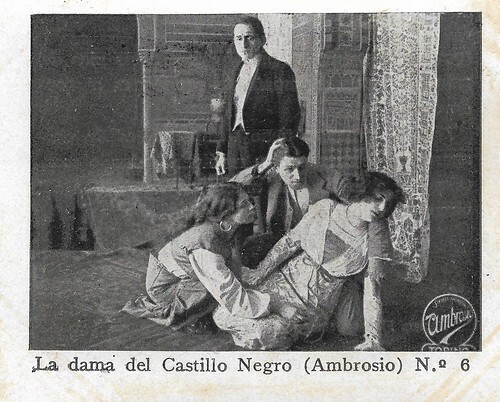
Spanish collector's card by Reclam Film, Mallorca, no. 6 of 6. La dama del Castillo Negro is the Spanish title of a hitherto unidentified Italian production by Ambrosio Film from the early 1910s.
Fra uomini e belve (1913)
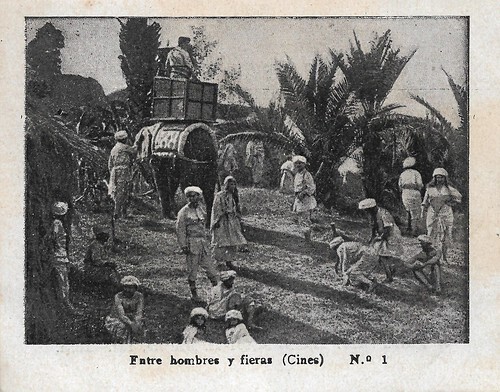
Spanish collectors card by Reclam Films, Mallorca, no. 1 of 6. Photo: Cines. Fra uomini e belve (Avventure in India)/Between Savage and Tiger (Giulio Antamoro, 1913). These Indian atmospheres were probably created at the Cines back lot.
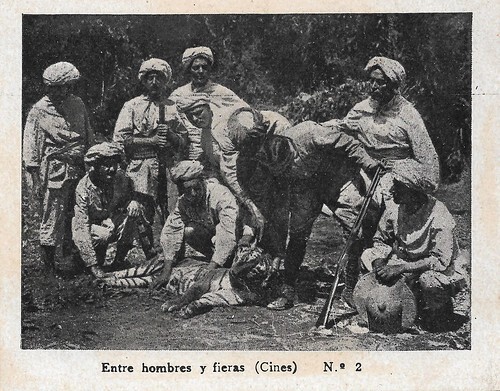
Spanish collectors card by Reclam Films, Mallorca, no. 2 of 6. Photo: Cines. Scene from Fra uomini e belve (Avventure in India)/Between Savage and Tiger (Giulio Antamoro, 1913).
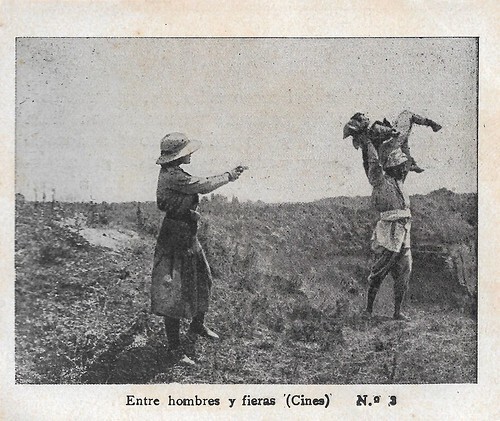
Spanish collectors card by Reclam Films, Mallorca, no. 3 of 6. Photo: Cines. Fra uomini e belve (Avventure in India)/Between Savage and Tiger (Giulio Antamoro, 1913). Hesperia saves her daughter from the evil Casuli (Ugone Di Sandri).
Strange adventures in India
In the Cines production Fra uomini e belve (Avventure in India)/Between Savage and Tiger (Giulio Antamoro, 1913), the stars are Amleto Novelli , Hesperia , Ignazio Lupi , and Lea Giunchi .
Amleto Novelli plays lieutenant Sandro Novelli, who even if not guilty, feels responsible after a disastrous explosion in gunpowder storage. He leaves for India, leaving his wife Hesperia ( Hesperia ) and little Bebé behind. His skills as a hunter are recognised by an Indian, who asks for his carabine. When Novelli refuses, he is tied to a stake to be burned alive, but the medicine man offers him salvation if he saves the chief from sickness, which he manages to do so.
The tribe honours him and the chief's daughter Sarama ( Lea Giunchi ) falls in love with him. Meanwhile, anxious because without news, Hesperia boards a ship with her daughter. A fire breaks out but Tom ( Ignazio Lupi ), an old sea wolf saves them, while the ship sinks.
After many adventures, Hesperia, Bebé and old Tom reach Novelli. Sarama, jealous of the marital bliss, exposes Bebé to a tiger, but old Tom saves the situation once more. Novelli flees with his family but is pursued by the Indians. He tricks them by putting puppets on the horses.
Yet, the grim lover of Samara, Casuli/Casali (Ugone Di Sandri), discovers the ruse, but after a fierce battle in which Hesperia shows her courage, the family manages to flee and return to Italy.
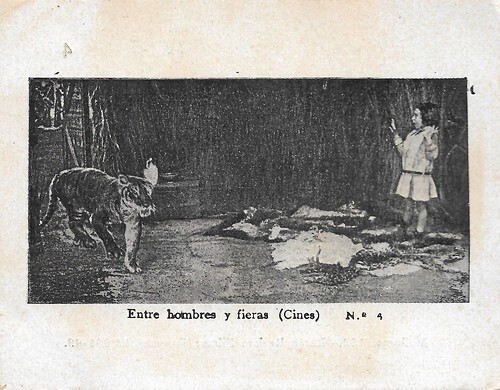
Spanish collectors card by Reclam Films, Mallorca, no. 4 of 6. Photo: Cines. Fra uomini e belve (Avventure in India)/Between Savage and Tiger (Giulio Antamoro, 1913). Little Bebé threatened by a tiger, sent by Samara.
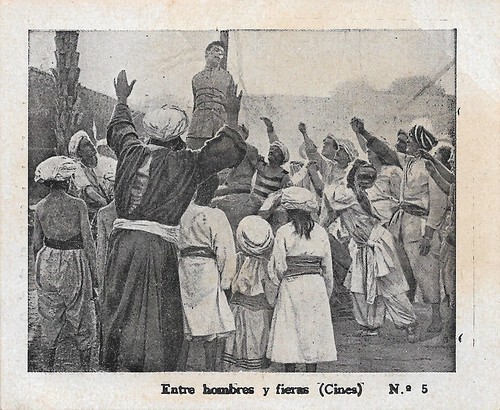
Spanish collectors card by Reclam Films, Mallorca, no. 5 of 6. Photo: Cines. Amleto Novelli to be burned alive in Fra uomini e belve (Avventure in India)/Between Savage and Tiger (Giulio Antamoro, 1913).
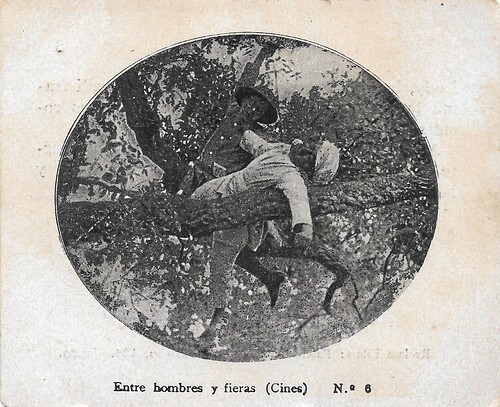
Spanish collectors card by Reclam Films, Mallorca, no. 6 of 6. Photo: Cines. Fra uomini e belve (Avventure in India)/Between Savage and Tiger (Giulio Antamoro, 1913).
Sources: Aldo Bernardini & Vittorio Martinelli, Il cinema muto italiano, 1913, Vol. I, and Vittorio Martinelli, Il cinema muto italiano, 1914, Vol. I.
Iris (1914)

Spanish collectors card by Chocolate Amatller, Barcelona, no. 1 of 6. Photo: Aquila Films. Scene from Iris (Achille Consalvi, 1914).

Spanish collectors card by Chocolate Amatller, Barcelona, no. 2 of 6. Photo: Aquila Films. Scene from Iris (Achille Consalvi, 1914).

Spanish collectors card by Chocolate Amatller, Barcelona, no. 3 of 6. Photo: Aquila Films. Scene from Iris (Achille Consalvi, 1914).
A fraudulent, criminal bank cashier who becomes a murderer
Iris (Achille Consalvi, 1914) starts with a fraudulent, criminal bank cashier, who fakes a robbery at the bank in order to save himself from ruin. Discovered by a night watch, he kills the man.
After twenty years, Arturo, the son of the cashier, falls in love with the daughter of the murdered night watch, Iris, who has become an acclaimed actress. He spends large sums to impress his girlfriend and asks his mother for money. The mother lives abroad in a villa.
The homicidal husband suddenly shows up again and is informed by a ragpicker how to best rob the villa of his wife, helped by the crony's little girl. When his lamp goes off during the robbery and he hits a piece of furniture, the wife is alarmed and almost killed by her own man. The girl assists in the killing and is so terrified she falls ill.
Yet, it is the lady's son Arturo who is accused of the failed homicide. Instead, Iris, taking care of the girl, finds with her a note from the ragpicker explaining who is the real culprit. During a stage show in honour of Iris, the thief invites Iris to a party, where she unmasks him as the culprit. In the end, he dies from a bomb.
It is unknown who were the actors in this film. Iris was released in Italy in May 1914. The plot is deducted from a review of the film in the journal La Vita Cinematografica.

Spanish collectors card by Chocolate Amatller, Barcelona, no. 4 of 6. Photo: Aquila Films. Scene from Iris (Achille Consalvi, 1914).

Spanish collectors card by Chocolate Amatller, Barcelona, no. 6 of 6. Photo: Aquila Films. Scene from Iris (Achille Consalvi, 1914).
La corsa all'abisso (1914)

Spanish collectors card by Reclam Films, Mallorca, no. 1 of 6. Photo: Milano Films. Mercedes Brignone and Antonio De Vergillius in La corsa all'abisso/The Pace That Kills (Attilio Fabbri, 1914).

Spanish collectors card by Reclam Films, Mallorca, no. 2 of 6. Photo: Milano Films. Duel in La corsa all'abisso/The Pace That Kills (Attilio Fabbri, 1914).

Spanish collectors card by Reclam Films, Mallorca, no. 3 of 6. Photo: Milano Films. Scene of La corsa all'abisso/The Pace That Kills (Attilio Fabbri, 1914).
Fatally pushed towards the abyss of rejection and misery
Italian actress Mercedes Brignone stars in the drama La corsa all'abisso/The Pace That Kills (Attilio Fabbri, 1914) as Lydia.
At the time of the premiere, the journal Il Maggese Cinematografico wrote that Lydia, a poor girl who once became like a dragonfly, lets herself be burned by the lamp of illusion.
In the end, she dies in the arms of her former lover, a poor artist, who really loved her and lived in the dark, but whom she, blinded by the corrupting light, had discarded, and thus was fatally pushed towards the abyss of rejection and misery.
Il Maggese Cinematografico predicted that even the most sceptical souls would be touched by this death scene. Both Il Maggese Cinematografico and La Vita Cinematografica praised the performance knowing well to perform the merry ingenuity as well as the fright and grief of the protagonist.
Attilio De Virgiliis played Brignone's rich lover, while the poor painter may have been played by Camillo Apolloni. The cinematography was by Carlo Montuori.

Spanish collectors card by Reclam Films, Mallorca, no. 4 of 6. Photo: Milano Films. Mercedes Brignone and Attilio De Virgiliis in La corsa all'abisso/The Pace That Kills (Attilio Fabbri, 1914).

Spanish collectors card by Reclam Films, Mallorca, no. 5 of 6. Photo: Milano Films. Mercedes Brignone in La corsa all'abisso/The Pace That Kills (Attilio Fabbri, 1914).

Spanish collectors card by Reclam Films, Mallorca, no. 6 of 6. Photo: Milano Films. Scene from La corsa all'abisso/The Pace That Kills (Attilio Fabbri, 1914).
'La dama del Castillo Negro' (S.A.)

Spanish collector's card by Reclam Film, Mallorca, no. 1 of 6. Photo: Ambrosio. La dama del Castillo Negro is the Spanish title of a hitherto unidentified Italian production.

Spanish collector's card by Reclam Film, Mallorca, no. 2 of 6. Photo: Ambrosio. La dama del Castillo Negro is the Spanish title of a hitherto unidentified Italian production.

Spanish collector's card by Reclam Film, Mallorca, no. 3 of 6. Photo: Ambrosio. La dama del Castillo Negro is the Spanish title of a hitherto unidentified Italian production.
A rendezvous at the black castle
La dama del Castillo Negro is the Spanish title of a hitherto unidentified Italian production by Ambrosio Film from the early 1910s. We identified the leading actress Antonietta Calderari, as well as the actors Alfredo Bertone and Orlando Ricci.
In the plot on the cards, the main characters are named Sarha, the Prince of Koepic, Viscount Albert and policeman Harrison. The Prince of Koepic needs money and so his cousin Sarha (Antonietta Calderari) has to seduce Viscount Albert (Bertone).
Albert gives her a rendezvous at the black castle, where he is tied up and the prince asks his parents for a sum of 50,000 francs to free him. The prince's gang steals the sum and demands another 50,000, so the parents go to the policeman Harrison who goes to a hotel to catch the ring, but the prince sets fire to the hotel.
At a party, Harrison meets Sarha. Koepic finds out that Sarha is taking Harrison to the castle and so Koepic gets Harrison caught as well. Yet, Sarah has fallen so in love with Albert that Koepic wants to kill her. So she frees the two but they are pursued by Koepic and his gang. Sarah manages to throw the whole gang into a well, but as they fall, the prince shoots Sarah, who dies in the arms of her Albert.

Spanish collector's card by Reclam Film, Mallorca, no. 4 of 6. La dama del Castillo Negro is the Spanish title of a hitherto unidentified Italian production by Ambrosio Film from the early 1910s.

Spanish collector's card by Reclam Film, Mallorca, no. 5 of 6. La dama del Castillo Negro is the Spanish title of a hitherto unidentified Italian production by Ambrosio Film from the early 1910s.

Spanish collector's card by Reclam Film, Mallorca, no. 6 of 6. La dama del Castillo Negro is the Spanish title of a hitherto unidentified Italian production by Ambrosio Film from the early 1910s.
Fra uomini e belve (1913)

Spanish collectors card by Reclam Films, Mallorca, no. 1 of 6. Photo: Cines. Fra uomini e belve (Avventure in India)/Between Savage and Tiger (Giulio Antamoro, 1913). These Indian atmospheres were probably created at the Cines back lot.

Spanish collectors card by Reclam Films, Mallorca, no. 2 of 6. Photo: Cines. Scene from Fra uomini e belve (Avventure in India)/Between Savage and Tiger (Giulio Antamoro, 1913).

Spanish collectors card by Reclam Films, Mallorca, no. 3 of 6. Photo: Cines. Fra uomini e belve (Avventure in India)/Between Savage and Tiger (Giulio Antamoro, 1913). Hesperia saves her daughter from the evil Casuli (Ugone Di Sandri).
Strange adventures in India
In the Cines production Fra uomini e belve (Avventure in India)/Between Savage and Tiger (Giulio Antamoro, 1913), the stars are Amleto Novelli , Hesperia , Ignazio Lupi , and Lea Giunchi .
Amleto Novelli plays lieutenant Sandro Novelli, who even if not guilty, feels responsible after a disastrous explosion in gunpowder storage. He leaves for India, leaving his wife Hesperia ( Hesperia ) and little Bebé behind. His skills as a hunter are recognised by an Indian, who asks for his carabine. When Novelli refuses, he is tied to a stake to be burned alive, but the medicine man offers him salvation if he saves the chief from sickness, which he manages to do so.
The tribe honours him and the chief's daughter Sarama ( Lea Giunchi ) falls in love with him. Meanwhile, anxious because without news, Hesperia boards a ship with her daughter. A fire breaks out but Tom ( Ignazio Lupi ), an old sea wolf saves them, while the ship sinks.
After many adventures, Hesperia, Bebé and old Tom reach Novelli. Sarama, jealous of the marital bliss, exposes Bebé to a tiger, but old Tom saves the situation once more. Novelli flees with his family but is pursued by the Indians. He tricks them by putting puppets on the horses.
Yet, the grim lover of Samara, Casuli/Casali (Ugone Di Sandri), discovers the ruse, but after a fierce battle in which Hesperia shows her courage, the family manages to flee and return to Italy.

Spanish collectors card by Reclam Films, Mallorca, no. 4 of 6. Photo: Cines. Fra uomini e belve (Avventure in India)/Between Savage and Tiger (Giulio Antamoro, 1913). Little Bebé threatened by a tiger, sent by Samara.

Spanish collectors card by Reclam Films, Mallorca, no. 5 of 6. Photo: Cines. Amleto Novelli to be burned alive in Fra uomini e belve (Avventure in India)/Between Savage and Tiger (Giulio Antamoro, 1913).

Spanish collectors card by Reclam Films, Mallorca, no. 6 of 6. Photo: Cines. Fra uomini e belve (Avventure in India)/Between Savage and Tiger (Giulio Antamoro, 1913).
Sources: Aldo Bernardini & Vittorio Martinelli, Il cinema muto italiano, 1913, Vol. I, and Vittorio Martinelli, Il cinema muto italiano, 1914, Vol. I.
Published on March 15, 2023 23:00
March 14, 2023
Vladimir Gajdarov
Ukrainian actor Vladimir Gajdarov (1893-1976), in Germany known as Wladimir Gaidarow, began his film career in Russia before the October Revolution. Later he became a popular star in German and French silent cinema. The sound film made him return to his home country, but in the Soviet Union, he had a hard time getting work.

German postcard by FM, no 5153. Photo: Studium Film. Vladimir Gajdarov as Paris in Helena (Manfred Noa, 1924).

German postcard by Ross Verlag, no. 887/1, 1925-1926. Caption: Vladimir Gajdarov (Waldimir Gaidarow) in a double role.
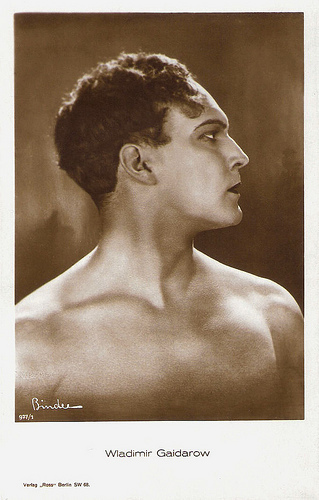
German postcard by Ross Verlag, no. 977/1, 1925-1926. Photo: Alex Binder, Berlin.
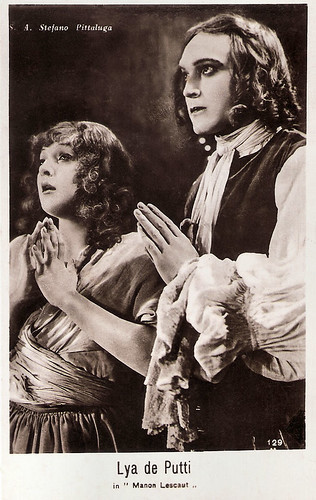
Italian postcard by G.B. Falci, Milano, no. 129. Photo: A. Stefano Pittaluga. Lya de Putti and Vladimir Gajdarov in Manon Lescaut (Arthur Robison, 1926).
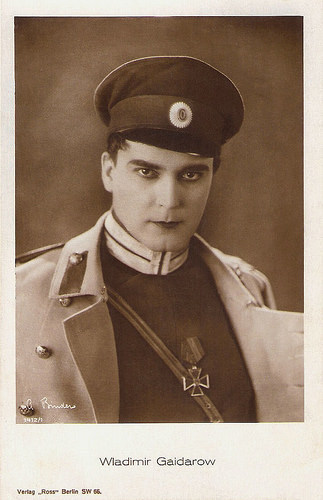
German postcard by Ross Verlag, no. 1412/1, 1927-1928. Photo: Alex Binder, Berlin.
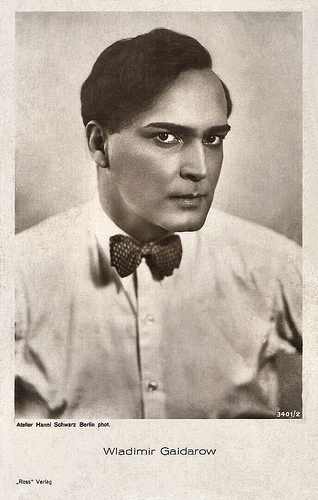
German postcard by Ross Verlag, no. 3401/2, 1928-1929. Photo: Atelier Hanni Schwarz, Berlin.
Stanislavski
Vladimir Georgiyevich Gajdarov was born in Poltava, Russian Empire (now Ukraine), in 1893. He supposedly was the son of a noble family.
He studied history, philosophy and the German language before he became a pupil of the famous stage director Konstantin Stanislavski . Soon he became a very popular actor on the Russian stage.
He began his film career in Russia before the October Revolution. His first appearance was opposite his wife-to-be, the famous Stanislavski actress Olga Gzovskaya, in Yeyo zhertva/Her Sacrifice (Cheslav Sabinsky, 1917) based on a play by Henrik Ibsen.
Next, he played with Ivan Mozzhukhin in Ne nado krovi/Blood Need Not Be Spilled (Yakov Protazanov, Alexandre Volkoff, 1917). The two actors were also featured in Otyets Sergei/Father Sergei (Yakov Protazanov, Alexandre Volkoff, 1917-1918), based on a Leo Tolstoy story. This popular film tells the tale of an officer who becomes a monk after hearing of his fiancée's affair with the Tsar.
Another film was Iola (1920) by animation filmmaker Wladyslaw Starewicz. In 1920 Gajdarov and Olga Gzovskaya left Russia. They eventually arrived in Turkey, and in Constantinople, he directed two films to raise money to aid the many stranded Russian refugees who had fled the Bolsheviks.
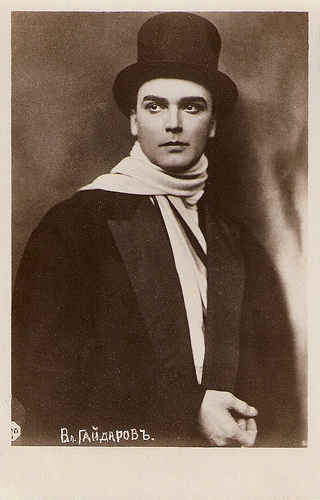
Latvian (?) postcard by KLTD.
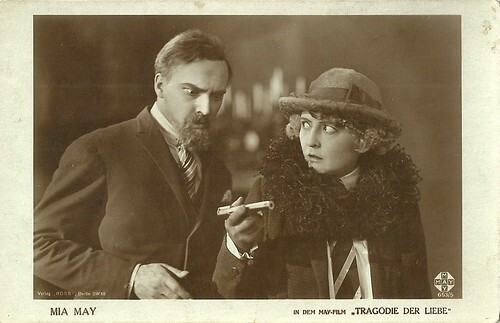
German postcard by Ross Verlag, Berlin, no. 653/5. Photo: May-Film. Mia May and Vladimir Gajdarov in Tragödie der Liebe/Tragedy of Love (Joe May, 1923).
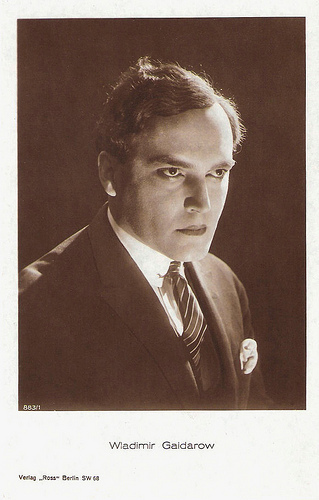
German postcard by Ross Verlag, Berlin, no. 883/1, 1925-1926.
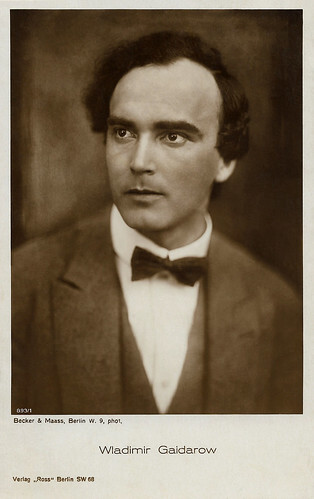
German postcard by Ross Verlag, Berlin, no. 893/1, 1925-26. Photo: Becker & Maass, Berlin.
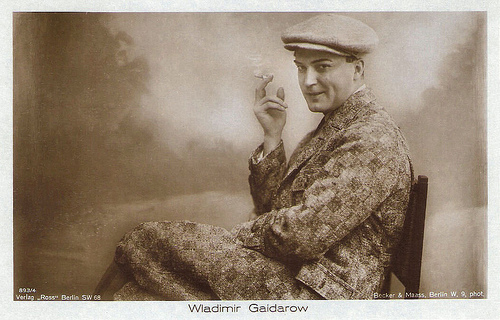
German postcard by Ross Verlag, Berlin, no. 893/4, 1925-1926. Photo: Becker & Maass, Berlin.
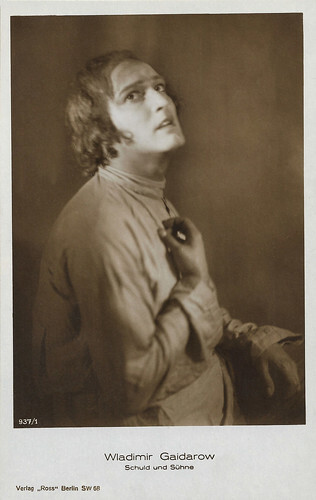
German postcard by Ross Verlag, Berlin, no. 937/1, 1925-1926. Vladimir Gajdarov in the stage play 'Schuld und Sühne' (Crime and Punishment), based on Dostojevski's classic novel.
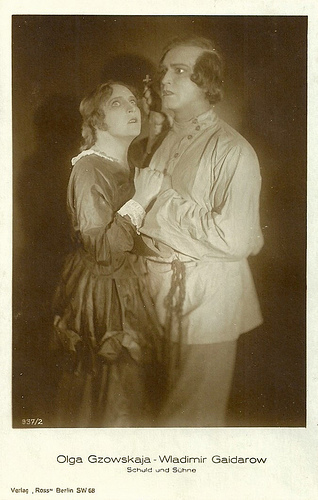
German postcard by Ross Verlag, no. 937/2, 1925-1926. Vladimir Gajdarov and Olga Gzovskaya in Schuld und Sühne, an adaptation of Dostoevski's Crime and Punishment (Raskolnikov). Unclear which film this is, as a 1922/1923 German version, called Raskolnikow (directed by Robert Wiene), starred Grigori Chmara and not Gajdarov.
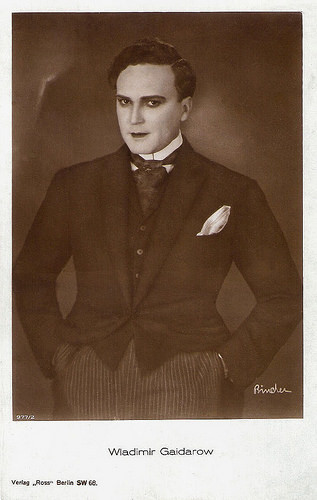
German postcard by Ross Verlag, no. 977/2, 1925-1926. Photo: Alex Binder, Berlin.
Haunted, pale face
In the following years, Vladimir Gajdarov worked in various European countries. Especially in Germany, he found rewarding roles in films.
With his haunted, pale face he acted in Der brennende Acker/The Burning Earth (F.W. Murnau, 1922) opposite Lya de Putti , and in Die Gezeichneten/Love One Another (Carl Theodor Dreyer, 1922).
Gajdarob played a double role in the Alexandre Dumas père adaptation Der Mann mit der eisernen Maske/The Man in the Iron Mask (Max Glass, 1923) starring Albert Bassermann . Other popular German films were the serial Tragödie der Liebe/The Tragedy of Love (Joe May, 1923) with Marlene Dietrich , and Manon Lescaut (Arthur Robison, 1926), again opposite Lya de Putti .
In France, he appeared as Vladimir Gaidaroff in Le roman d'un jeune homme pauvre/The Novel of a Poor Young Man (Gaston Ravel, 1926) with Maly Delschaft , and in La Madone des sleepings/Madonna of the Sleeping Cars (Marco de Gastyne, Maurice Gleize, 1927).
He starred as an exotic lady-killer in Die Weisse Sklavin/The White Slave (Augusto Genina, 1927) opposite Liane Haid , and in Frauenraub in Marokko (Gennaro Righelli, 1928) with Dolly Davis .
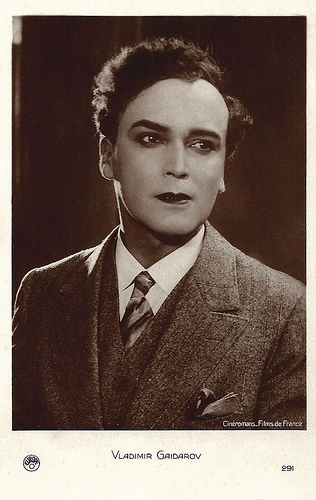
French postcard by Europe no. 291. Photo: Cinéromans Films de France.
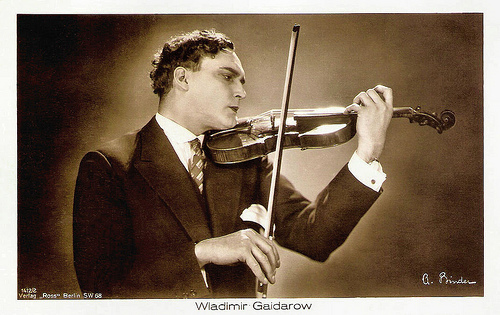
German postcard by Ross Verlag, Berlin, no. 1412/2, 1927-1928. Photo: Alex Binder.
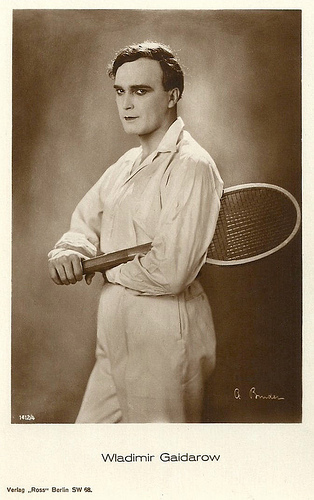
German postcard by Ross Verlag, Berlin, no. 1412/4, 1927-1928. Photo: Alex Binder.
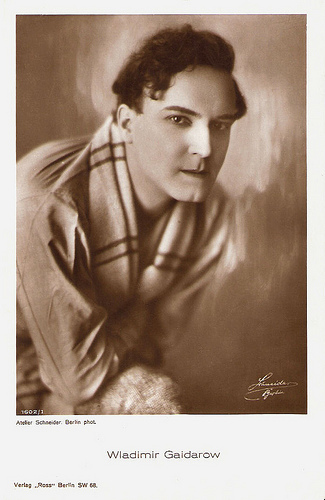
German postcard. Ross Verlag, no. 1602/1, 1927-1928. Photo: Atelier Schneider, Berlin.
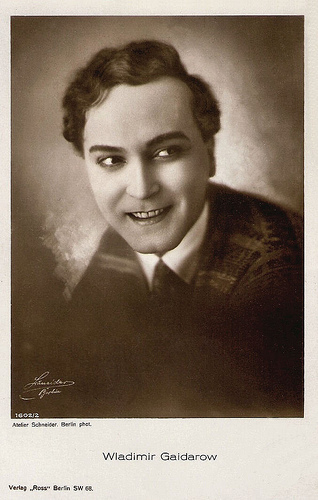
German postcard by Ross Verlag, no. 1602/2, 1927-1928. Photo: Atelier Schneider, Berlin.
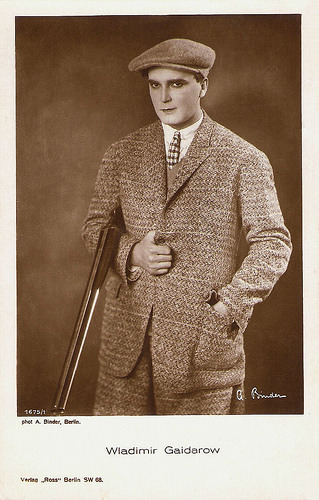
German postcard by Ross Verlag, no. 1673/1, 1927-1928. Photo: Alex Binder, Berlin.
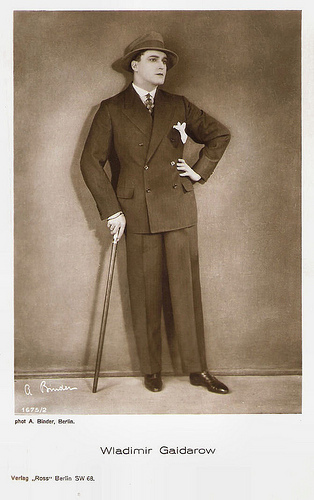
German postcard by Ross Verlag, no. 1675/2, 1927-1928. Photo: Alex Binder, Berlin.
Siberia
When the sound film arrived Vladimir Gajdarov's possibilities on the international film scene were seriously reduced. In 1930 he took on the position of film director and producer and made Kire lained/Wells of Passion (1930) with Ita Rina , but soon he had to return to acting again.
He appeared in a few German productions like Nachtkolonne/Night Convoy (James Bauer, 1931), and Luise, Königin von Preussen/Luise, Queen of Prussia (Carl Froelich, 1931), starring Henny Porten .
In 1932 he and Olga Gzovskaya returned to the Soviet Union. As former émigrés, they were unable to find employment until 1937.
During the Stalinist repression, with hundreds of people arrested every day, Gzovskaya wrote to Konstantin Stanislavski twice, begging for his help. Stanislavski responded with a letter, which helped them both to find professional work in theatres in Leningrad.
Later Gajdarov appeared in the propaganda film Stalingradskaya bitva/The Battle of Stalingrad (Vladimir Petrov, 1949-1950), Geroite na Shipka/Heroes of Shipka (Sergei Vasilyev, 1954), and the Norwegian-Russian coproduction Bare et liv/The History of Fridtjof Nansen (Sergei Mikalyen, 1968).
Vladimir Gajdarov published his memoirs in 1966. He died in Poltava, Siberia in 1976.
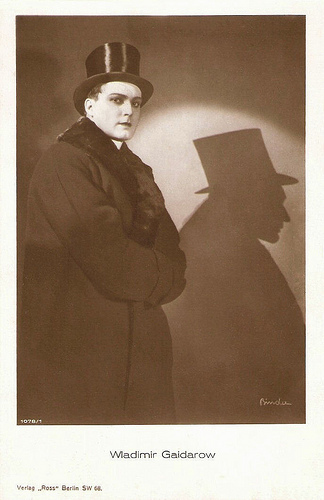
German postcard by Ross, Berlin, no. 1978/1, 1927-1928. Photo: Alex Binder.
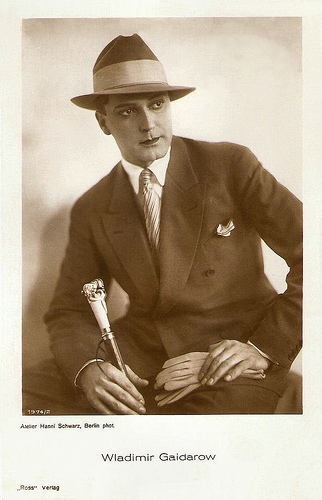
German postcard by Ross, Berlin, no. 1974/2, 1927-1928. Photo: Atelier Hanni Schwarz, Berlin.
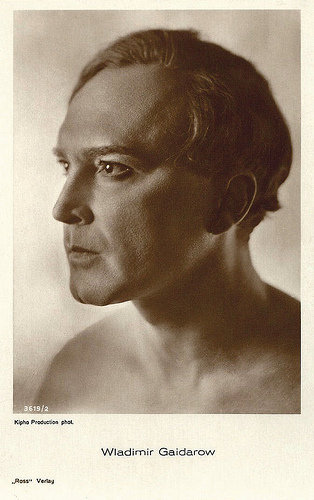
German postcard by Ross Verlag no. 3619/2, 1928-1929. Photo: Kipho Production.
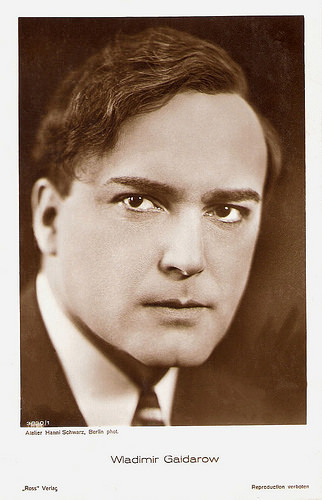
German postcard by Ross Verlag, no. 3830/1, 1928-1929. Photo: Atelier Hanni Schwarz, Berlin.
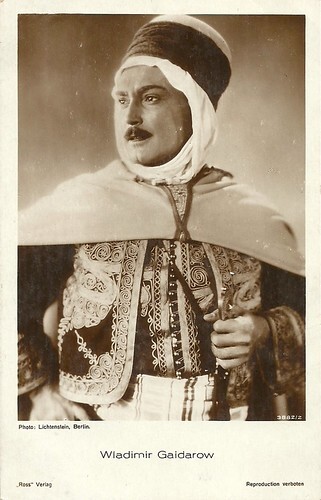
German postcard by Ross Verlag, Berlin, no. 3882/2, 1928-1929. Photo: Lichtenstein, Berlin. Vladimir Gajdarov in Frauenraub in Marokko/The Love of a Sheik (Gennaro Righelli, 1928).
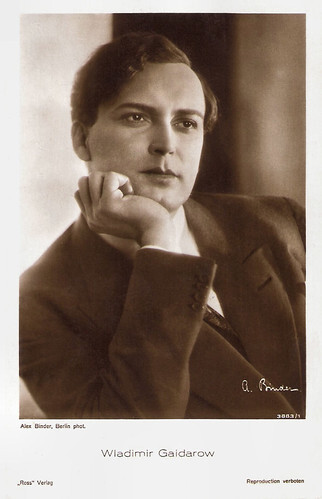
German postcard by Ross Verlag, no. 3883/1, 1928-1929. Photo: Alex Binder, Berlin.
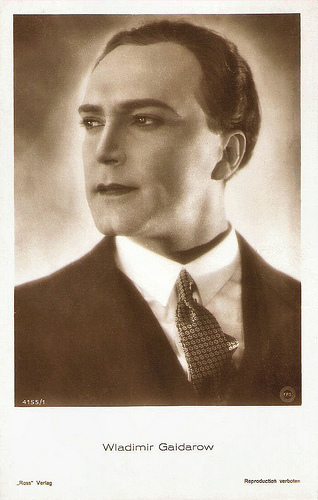
German postcard by Ross Verlag, Berlin, no. 4155/1, 1929-1930. Photo: FPS.
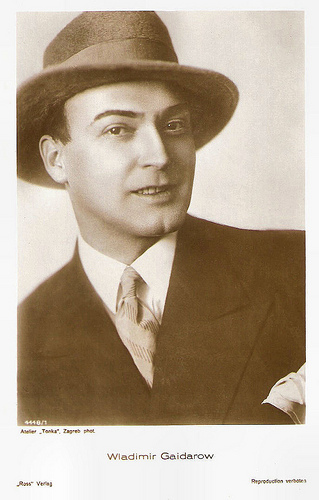
German postcard by Ross Verlag, Berlin, no. 4448/1, 1929-1930. Photo: Atelier Tonka, Zagreb.
Sources: Thomas Staedeli (Cyranos), Silents are Golden, The Silent Cinema Reader, Wikipedia and .

German postcard by FM, no 5153. Photo: Studium Film. Vladimir Gajdarov as Paris in Helena (Manfred Noa, 1924).

German postcard by Ross Verlag, no. 887/1, 1925-1926. Caption: Vladimir Gajdarov (Waldimir Gaidarow) in a double role.

German postcard by Ross Verlag, no. 977/1, 1925-1926. Photo: Alex Binder, Berlin.

Italian postcard by G.B. Falci, Milano, no. 129. Photo: A. Stefano Pittaluga. Lya de Putti and Vladimir Gajdarov in Manon Lescaut (Arthur Robison, 1926).

German postcard by Ross Verlag, no. 1412/1, 1927-1928. Photo: Alex Binder, Berlin.

German postcard by Ross Verlag, no. 3401/2, 1928-1929. Photo: Atelier Hanni Schwarz, Berlin.
Stanislavski
Vladimir Georgiyevich Gajdarov was born in Poltava, Russian Empire (now Ukraine), in 1893. He supposedly was the son of a noble family.
He studied history, philosophy and the German language before he became a pupil of the famous stage director Konstantin Stanislavski . Soon he became a very popular actor on the Russian stage.
He began his film career in Russia before the October Revolution. His first appearance was opposite his wife-to-be, the famous Stanislavski actress Olga Gzovskaya, in Yeyo zhertva/Her Sacrifice (Cheslav Sabinsky, 1917) based on a play by Henrik Ibsen.
Next, he played with Ivan Mozzhukhin in Ne nado krovi/Blood Need Not Be Spilled (Yakov Protazanov, Alexandre Volkoff, 1917). The two actors were also featured in Otyets Sergei/Father Sergei (Yakov Protazanov, Alexandre Volkoff, 1917-1918), based on a Leo Tolstoy story. This popular film tells the tale of an officer who becomes a monk after hearing of his fiancée's affair with the Tsar.
Another film was Iola (1920) by animation filmmaker Wladyslaw Starewicz. In 1920 Gajdarov and Olga Gzovskaya left Russia. They eventually arrived in Turkey, and in Constantinople, he directed two films to raise money to aid the many stranded Russian refugees who had fled the Bolsheviks.

Latvian (?) postcard by KLTD.

German postcard by Ross Verlag, Berlin, no. 653/5. Photo: May-Film. Mia May and Vladimir Gajdarov in Tragödie der Liebe/Tragedy of Love (Joe May, 1923).

German postcard by Ross Verlag, Berlin, no. 883/1, 1925-1926.

German postcard by Ross Verlag, Berlin, no. 893/1, 1925-26. Photo: Becker & Maass, Berlin.

German postcard by Ross Verlag, Berlin, no. 893/4, 1925-1926. Photo: Becker & Maass, Berlin.

German postcard by Ross Verlag, Berlin, no. 937/1, 1925-1926. Vladimir Gajdarov in the stage play 'Schuld und Sühne' (Crime and Punishment), based on Dostojevski's classic novel.

German postcard by Ross Verlag, no. 937/2, 1925-1926. Vladimir Gajdarov and Olga Gzovskaya in Schuld und Sühne, an adaptation of Dostoevski's Crime and Punishment (Raskolnikov). Unclear which film this is, as a 1922/1923 German version, called Raskolnikow (directed by Robert Wiene), starred Grigori Chmara and not Gajdarov.

German postcard by Ross Verlag, no. 977/2, 1925-1926. Photo: Alex Binder, Berlin.
Haunted, pale face
In the following years, Vladimir Gajdarov worked in various European countries. Especially in Germany, he found rewarding roles in films.
With his haunted, pale face he acted in Der brennende Acker/The Burning Earth (F.W. Murnau, 1922) opposite Lya de Putti , and in Die Gezeichneten/Love One Another (Carl Theodor Dreyer, 1922).
Gajdarob played a double role in the Alexandre Dumas père adaptation Der Mann mit der eisernen Maske/The Man in the Iron Mask (Max Glass, 1923) starring Albert Bassermann . Other popular German films were the serial Tragödie der Liebe/The Tragedy of Love (Joe May, 1923) with Marlene Dietrich , and Manon Lescaut (Arthur Robison, 1926), again opposite Lya de Putti .
In France, he appeared as Vladimir Gaidaroff in Le roman d'un jeune homme pauvre/The Novel of a Poor Young Man (Gaston Ravel, 1926) with Maly Delschaft , and in La Madone des sleepings/Madonna of the Sleeping Cars (Marco de Gastyne, Maurice Gleize, 1927).
He starred as an exotic lady-killer in Die Weisse Sklavin/The White Slave (Augusto Genina, 1927) opposite Liane Haid , and in Frauenraub in Marokko (Gennaro Righelli, 1928) with Dolly Davis .

French postcard by Europe no. 291. Photo: Cinéromans Films de France.

German postcard by Ross Verlag, Berlin, no. 1412/2, 1927-1928. Photo: Alex Binder.

German postcard by Ross Verlag, Berlin, no. 1412/4, 1927-1928. Photo: Alex Binder.

German postcard. Ross Verlag, no. 1602/1, 1927-1928. Photo: Atelier Schneider, Berlin.

German postcard by Ross Verlag, no. 1602/2, 1927-1928. Photo: Atelier Schneider, Berlin.

German postcard by Ross Verlag, no. 1673/1, 1927-1928. Photo: Alex Binder, Berlin.

German postcard by Ross Verlag, no. 1675/2, 1927-1928. Photo: Alex Binder, Berlin.
Siberia
When the sound film arrived Vladimir Gajdarov's possibilities on the international film scene were seriously reduced. In 1930 he took on the position of film director and producer and made Kire lained/Wells of Passion (1930) with Ita Rina , but soon he had to return to acting again.
He appeared in a few German productions like Nachtkolonne/Night Convoy (James Bauer, 1931), and Luise, Königin von Preussen/Luise, Queen of Prussia (Carl Froelich, 1931), starring Henny Porten .
In 1932 he and Olga Gzovskaya returned to the Soviet Union. As former émigrés, they were unable to find employment until 1937.
During the Stalinist repression, with hundreds of people arrested every day, Gzovskaya wrote to Konstantin Stanislavski twice, begging for his help. Stanislavski responded with a letter, which helped them both to find professional work in theatres in Leningrad.
Later Gajdarov appeared in the propaganda film Stalingradskaya bitva/The Battle of Stalingrad (Vladimir Petrov, 1949-1950), Geroite na Shipka/Heroes of Shipka (Sergei Vasilyev, 1954), and the Norwegian-Russian coproduction Bare et liv/The History of Fridtjof Nansen (Sergei Mikalyen, 1968).
Vladimir Gajdarov published his memoirs in 1966. He died in Poltava, Siberia in 1976.

German postcard by Ross, Berlin, no. 1978/1, 1927-1928. Photo: Alex Binder.

German postcard by Ross, Berlin, no. 1974/2, 1927-1928. Photo: Atelier Hanni Schwarz, Berlin.

German postcard by Ross Verlag no. 3619/2, 1928-1929. Photo: Kipho Production.

German postcard by Ross Verlag, no. 3830/1, 1928-1929. Photo: Atelier Hanni Schwarz, Berlin.

German postcard by Ross Verlag, Berlin, no. 3882/2, 1928-1929. Photo: Lichtenstein, Berlin. Vladimir Gajdarov in Frauenraub in Marokko/The Love of a Sheik (Gennaro Righelli, 1928).

German postcard by Ross Verlag, no. 3883/1, 1928-1929. Photo: Alex Binder, Berlin.

German postcard by Ross Verlag, Berlin, no. 4155/1, 1929-1930. Photo: FPS.

German postcard by Ross Verlag, Berlin, no. 4448/1, 1929-1930. Photo: Atelier Tonka, Zagreb.
Sources: Thomas Staedeli (Cyranos), Silents are Golden, The Silent Cinema Reader, Wikipedia and .
Published on March 14, 2023 23:00
March 13, 2023
Werner Fuetterer
At 18, handsome German actor Werner Fuetterer (1907-1991) was discovered to play the young lover in a series of silent films. For more than four decades he went on to work as a supporting actor in nearly 100 films. Fuetterer remains best remembered for his role as the Archangel in F. W. Murnau's masterpiece Faust (1926).
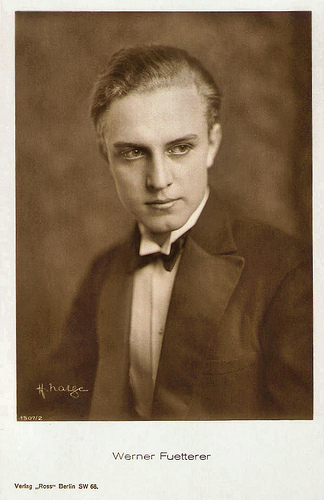
German postcard by Ross Verlag, Berlin, no. 1507/2, 1927-1928. Photo: Hans Natge.
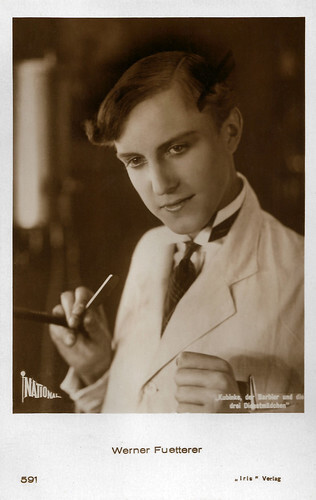
Austrian postcard by Iris-Verlag, no. 591. Photo: National. Werner Fuetterer in Kubinke, der Barbier, und die drei Dienstmädchen/Kubinke, the Barber, and the Three Maids (Carl Boese, 1926).
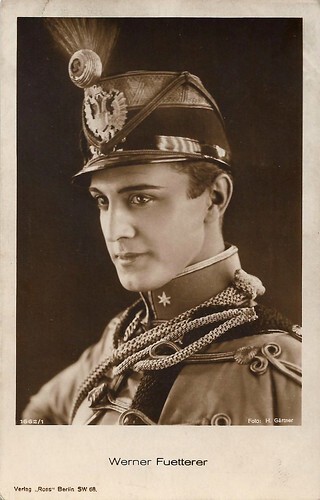
German postcard by Ross Verlag, no. 1662/1, 1927-1928. Photo: H. Gärtner. Werner Fuetterer in Durchlaucht Radieschen/Serene Radish (Richard Eichberg, 1927).
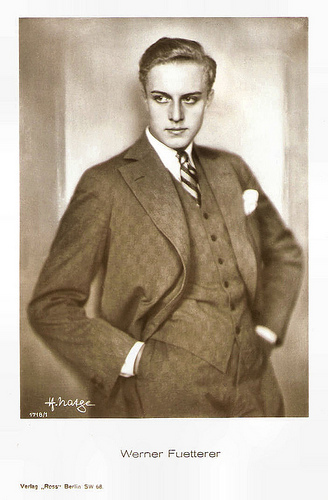
German postcard by Ross Verlag, Berlin, no. 1718/1, 1927-1928. Photo: Hans Natge.
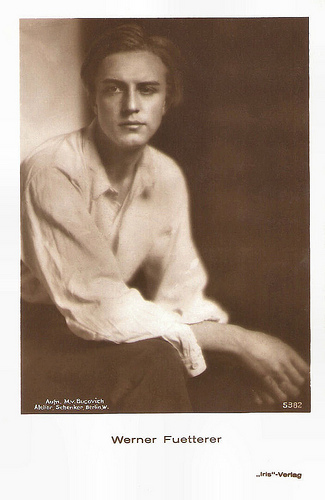
Austrian postcard by Iris Verlag, no. 5382. Photo: M. v. Bucovich / Atelier K. Schenker, Berlin.
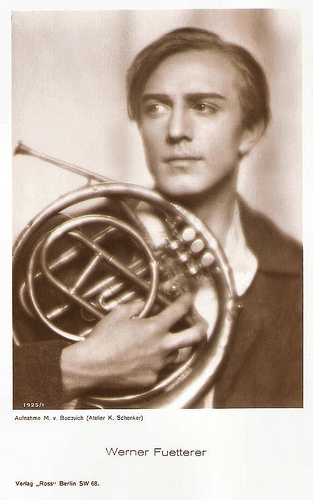
German postcard by Ross Verlag, no. 1925/1, 1927-1928. Photo: M. v. Bucovich / Atelier K. Schenker, Berlin.
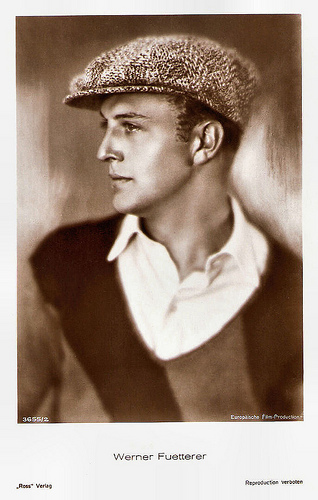
German postcard by Ross Verlag, Berlin, no. 3655/2, 1928-1929. Photo: Europäische Film-Production.
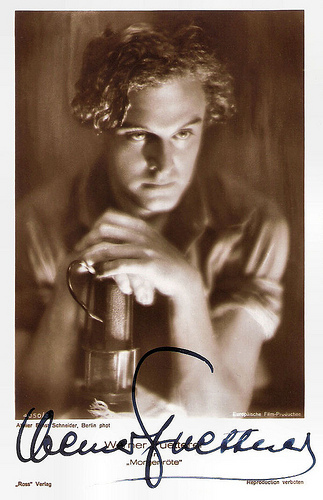
German postcard by Ross Verlag, no. 4050/1, 1929-1930. Photo: Ernst Schneider, Berlin / Europäische Film-Production. Publicity still for Morgenröte/Dawnings (Wolfgang Neff, Burton George, 1929).
Archangel Michael
Werner Fueterer was born in 1907 in Stralsund (or Barth according to some souces) in Mecklenburg-Vorpommern, Germany, but grew up in Guatemala, where his father managed a hacienda. In 1919 the family returned to Germany and went to live in Lübeck. In 1924 Werner started to study acting at the Berliner Schauspielschule.
He left the school prematurely in 1925 when he got a surprising offer for a role in the Swedish film Flygande holländaren/The Flying Dutchman (Karin Swanström, 1925). Soon, he became quite popular as a young lover in the German silent cinema of the 1920s.
He appeared in successful films like Kreuzer Emden/Cruiser Emden (Louis Ralph, 1926) and Die Brüder Schellenberg/The Brothers Schellenberg (Karl Grune, 1926), with Conrad Veidt and Lil Dagover .
His best-known role in this period was that of archangel Michael in the silent masterpiece Faust – eine deutsche Volkssage/Faust: A German Folk Legend (Friedrich Wilhelm Murnau, 1926) which was based on motifs from Goethe's 'Faust'. The film became a worldwide success and brought Emil Jannings a Hollywood career, but Fuetterer was merely offered supporting roles afterwards.
He appeared in films like Die keusche Susanne/The Innocent Susanne (Richard Eichberg, 1926), Du sollst nicht stehlen/Thou Art Not Steal (Victor Janson, 1928), and Das Mädel mit der Peitsche/The Girl With The Whip (Carl Lamac, 1929) with Anny Ondra .
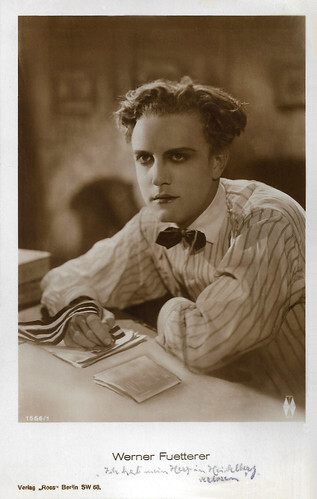
German postcard by Ross Verlag, no. 1566/1, 1927-1928. Photo: Münchner Lichtspielkunst AG (Emelka). Werner Fuetterer in Ich hab mein Herz in Heidelberg verloren/I lost my heart in Heidelberg (Arthur Bergen, 1926).
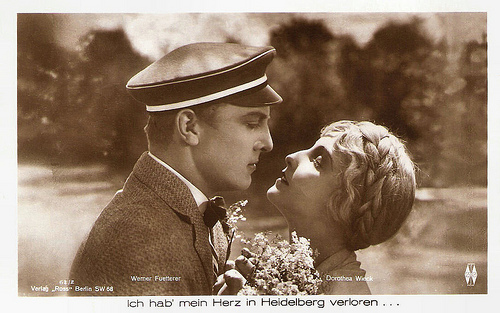
German postcard by Ross Verlag, Berlin, no. 61/2, 1926. Photo: Münchner Lichtspielkunst AG (Emelka). Publicity still for Ich hab mein Herz in Heidelberg verloren/I Lost My Heart in Heidelberg (Arthur Bergen, 1926) with Dorothea Wieck .
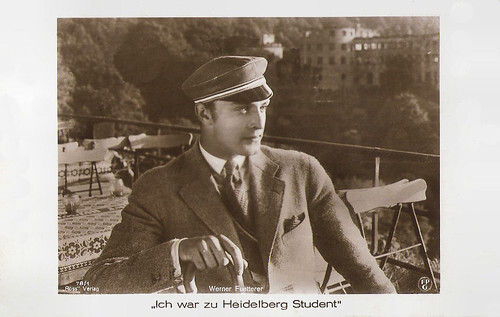
German postcard by Ross Verlag, Berlin, no. 78/1. Photo: Münchner Lichtspielkunst AG (Emelka). Werner Fuetterer in Ich war zu Heidelberg Student/I was a student at Heidelberg (Wolfgang Neff, 1927).
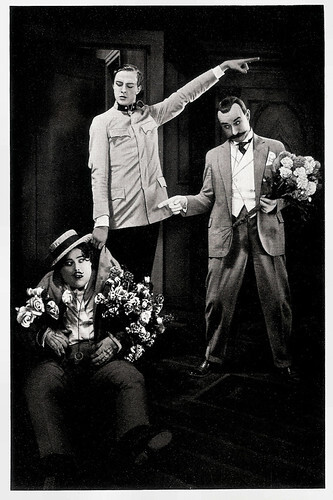
German collectors card by Ross Verlag in the series Vom Werden deutscher Filmkunst - Der Stumme Film, picture no. 199, group 43. Photo: Eichberg-Film. Werner Fuetterer and Hans Junkermann in Durchlaucht Radieschen/Highness Radish (Richard Eichberg, 1927).
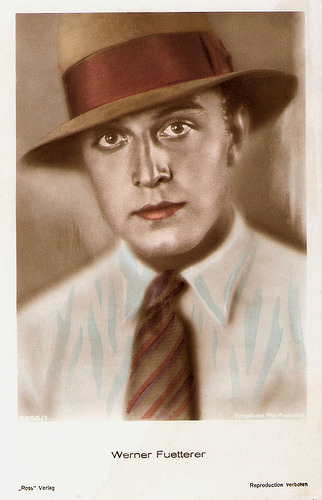
German postcard by Ross Verlag, no. 3655/1, 1928-1929. Photo: Europäische Film Production.
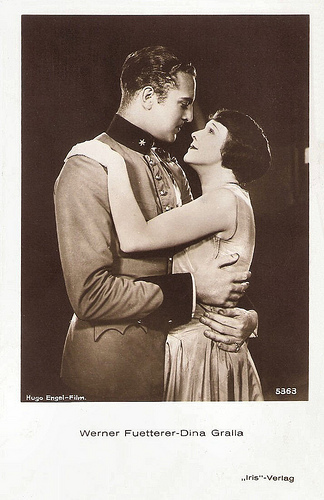
Austrian postcard by Iris-Verlag, no. 5363. Photo: Hugo Engel-Film. Publicity still for Das Girl von der Revue/The Girl of the Revue (Richard Eichberg, 1928) with Dina Gralla .
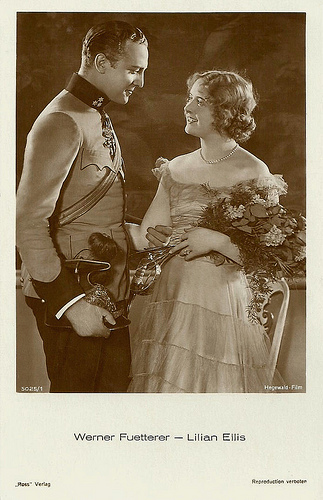
German postcard by Ross Verlag, no. 5025/1, 1930-1931. Photo: Hegewald-Film. Publicity still for Wiener Herzen/Viennese Hearts (Fred Sauer, 1930) with Lilian Ellis , a late silent film and a German-Austrian-Czech coproduction.
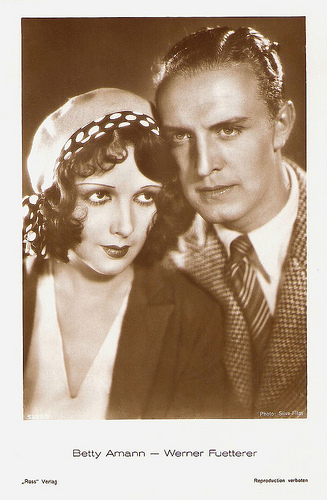
German postcard by Ross Verlag, no. 5325/2, 1930-1931. Photo: Silva-Film. Publicity still for O alte Burschenherrlichkeit/Oh Those Glorious Old Student Days (Rolf Randolf, 1930) with Betty Amann .
Best Friend
Smoothly Werner Fuetterer continued his career into the sound era with roles opposite Anny Ondra in Die Grausame Freundin/The Cruel Girl Friend (Carl Lamac, 1932) and Die Tochter des Regiments/The Regiment's Daughter (1933).
Other examples of his popular early sound films were Nacht der Versuchung/Night of Temptation (Léo Lasko, Robert Wohlmuth, 1932) with Elga Brink , and Einmal eine große Dame sein/To Be a Grand Lady Once (Gerhard Lamprecht, 1934) starring Käthe von Nagy .
In the 1930s and 1940s he was often cast as the best friend of the leading man like in the Heinz Rühmann comedies Der Mustergatte/Model Husband (Wolfgang Liebeneiner, 1937) and Ich vertraue Dir meine Frau an/I Trust To You My Wife (Kurt Hoffmann, 1940). He became established as a popular film actor and also worked in the theatre.
From 1937 to 1939 he toured the USA. After World War II he continued his career without a problem. His films included the comedies Es geschehen noch Wunder/Miracles Still Happen (Willi Forst, 1951) and Das kann jedem passieren/This Can Happen To Everybody (Paul Verhoeven, 1952) starring Heinz Rühmann , the circus drama Salto Mortale (Viktor Tourjansky, 1953), Des Teufels General/The Devil's General (Helmut Käutner, 1955), and Liebling der Götter/Sweetheart of the Gods (Gottfried Reinhardt, 1960), a bio pic of film star Renate Müller .
For many years, Werner Fuetterer was chairman of the Film Actor’s Union in Germany. From 1957 on he lived in Spain, where he managed a camping and bungalow park. His last supporting part was in the adventure film Mister Dynamit - morgen küßt Euch der Tod/Die Slowly, You'll Enjoy It More (Franz Josef Gottlieb, 1967) starring Lex Barker . In 1991 Werner Fuetterer died in Benidorm, hardly noticed by the media. He was 85. None of the sources note if he was married.
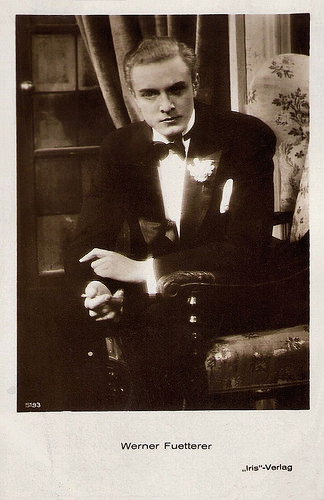
Austrian postcard by Iris-Verlag, no. 5193.
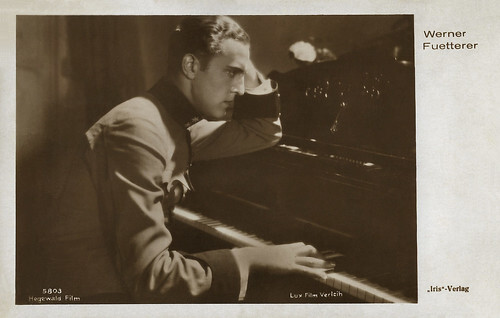
Austrian postcard by Iris-Verlag, Berlin, no. 5803. Photo: Hegewald Film / Lux Film Verleih. Werner Fuetterer in Im Prater blühen wieder die Bäume/In the Prater the trees are blossoming again (E.W. Emo, 1929).
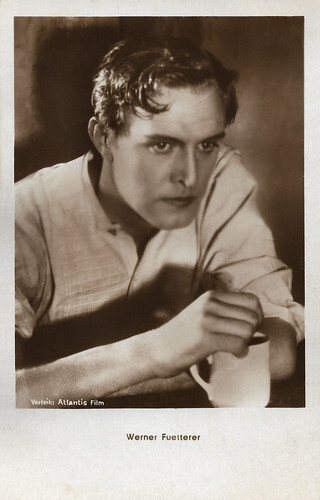
Austrian postcard by Iris-Verlag, no. 6009. Photo: Atlantis Film. Werner Fuetterer in Ich glaub nie mehr an eine Frau/Never Trust a Woman (Max Reichmann, 1930).
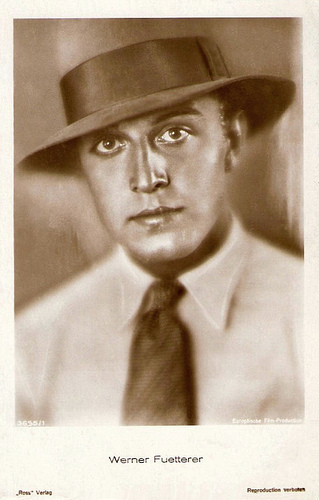
German postcard by Ross Verlag, no. 3655/1, 1928-1929. Photo Europäische Film Production.
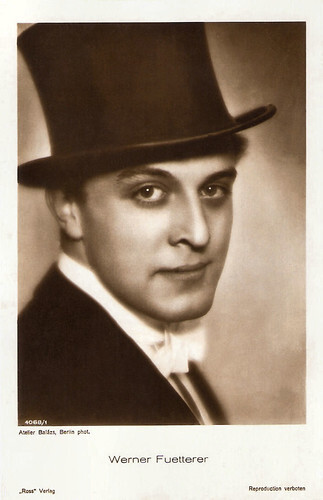
German postcard by Ross Verlag, no. 4068/1, 1929-1930. Photo: Atelier Balázs, Berlin.
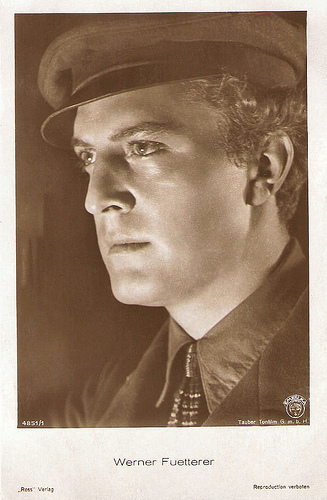
German postcard by Ross Verlag, no. 4851/1, 1929-1930. Photo: Tauber Tonfilm G.m.b.H / Emelka. Publicity still for Ich glaub nie mehr an eine Frau/Never Trust a Woman (Max Reichmann, 1930).
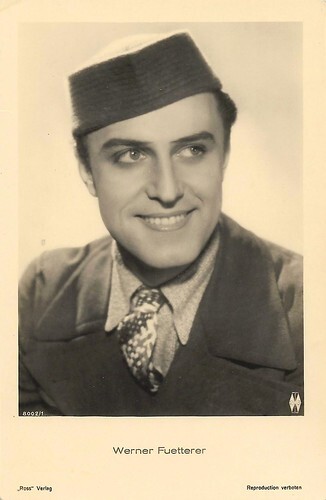
German postcard by Ross Verlag, no. 8002/1, 1933-1934. Photo: Münchner Lichtspielkunst AG (Emelka). Probably publicity still for the Emelka production Nacht der Versuchung/Night of Temptation (Léo Lasko, Robert Wohlmuth, 1932).
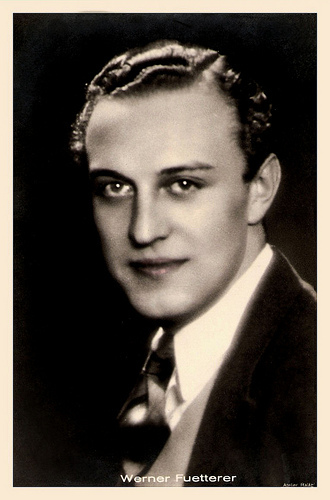
German postcard by Ross Verlag. Photo: Atelier Balasz, Berlin. (The edges of this card were cut off. We've photoshopped them for this scan).
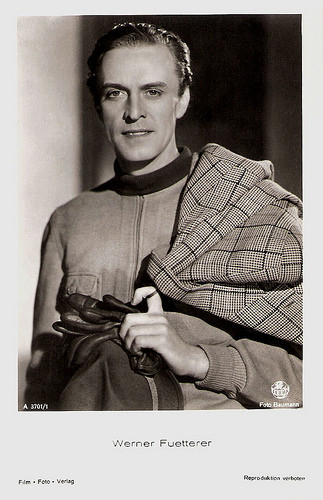
German postcard by Film-Foto-Verlag, Berlin, no. A 3701/1, 1941-1944. Photo: Baumann / Terra.
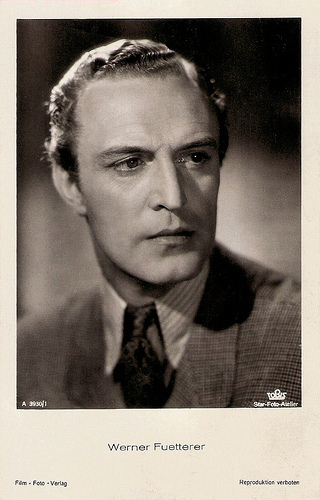
German postcard by Film-Foto-Verlag, no. 3930/1, 1941-1944. Photo: Star-Foto-Atelier / Tobis.
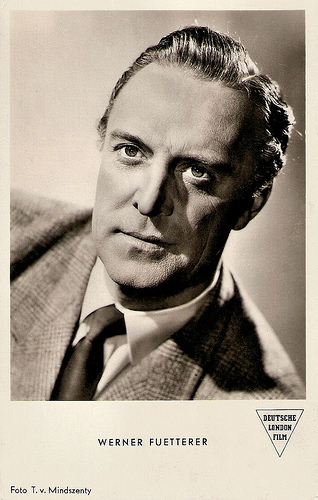
German postcard by Kunst und Bild, Berlin, no. A 838. Photo: T. von Mindszenty / Deutsche London Film. Still for Keine Angst vor grossen Tieren/Don't Fear Big Animals (Ulrich Erfurth, 1953).
Sources: Stephanie D'heil (Steffi-line - German), José L Bernabé Tronchoni (Find A Grave), Wikipedia, Thomas Staedeli, and .

German postcard by Ross Verlag, Berlin, no. 1507/2, 1927-1928. Photo: Hans Natge.

Austrian postcard by Iris-Verlag, no. 591. Photo: National. Werner Fuetterer in Kubinke, der Barbier, und die drei Dienstmädchen/Kubinke, the Barber, and the Three Maids (Carl Boese, 1926).

German postcard by Ross Verlag, no. 1662/1, 1927-1928. Photo: H. Gärtner. Werner Fuetterer in Durchlaucht Radieschen/Serene Radish (Richard Eichberg, 1927).

German postcard by Ross Verlag, Berlin, no. 1718/1, 1927-1928. Photo: Hans Natge.

Austrian postcard by Iris Verlag, no. 5382. Photo: M. v. Bucovich / Atelier K. Schenker, Berlin.

German postcard by Ross Verlag, no. 1925/1, 1927-1928. Photo: M. v. Bucovich / Atelier K. Schenker, Berlin.

German postcard by Ross Verlag, Berlin, no. 3655/2, 1928-1929. Photo: Europäische Film-Production.

German postcard by Ross Verlag, no. 4050/1, 1929-1930. Photo: Ernst Schneider, Berlin / Europäische Film-Production. Publicity still for Morgenröte/Dawnings (Wolfgang Neff, Burton George, 1929).
Archangel Michael
Werner Fueterer was born in 1907 in Stralsund (or Barth according to some souces) in Mecklenburg-Vorpommern, Germany, but grew up in Guatemala, where his father managed a hacienda. In 1919 the family returned to Germany and went to live in Lübeck. In 1924 Werner started to study acting at the Berliner Schauspielschule.
He left the school prematurely in 1925 when he got a surprising offer for a role in the Swedish film Flygande holländaren/The Flying Dutchman (Karin Swanström, 1925). Soon, he became quite popular as a young lover in the German silent cinema of the 1920s.
He appeared in successful films like Kreuzer Emden/Cruiser Emden (Louis Ralph, 1926) and Die Brüder Schellenberg/The Brothers Schellenberg (Karl Grune, 1926), with Conrad Veidt and Lil Dagover .
His best-known role in this period was that of archangel Michael in the silent masterpiece Faust – eine deutsche Volkssage/Faust: A German Folk Legend (Friedrich Wilhelm Murnau, 1926) which was based on motifs from Goethe's 'Faust'. The film became a worldwide success and brought Emil Jannings a Hollywood career, but Fuetterer was merely offered supporting roles afterwards.
He appeared in films like Die keusche Susanne/The Innocent Susanne (Richard Eichberg, 1926), Du sollst nicht stehlen/Thou Art Not Steal (Victor Janson, 1928), and Das Mädel mit der Peitsche/The Girl With The Whip (Carl Lamac, 1929) with Anny Ondra .

German postcard by Ross Verlag, no. 1566/1, 1927-1928. Photo: Münchner Lichtspielkunst AG (Emelka). Werner Fuetterer in Ich hab mein Herz in Heidelberg verloren/I lost my heart in Heidelberg (Arthur Bergen, 1926).

German postcard by Ross Verlag, Berlin, no. 61/2, 1926. Photo: Münchner Lichtspielkunst AG (Emelka). Publicity still for Ich hab mein Herz in Heidelberg verloren/I Lost My Heart in Heidelberg (Arthur Bergen, 1926) with Dorothea Wieck .

German postcard by Ross Verlag, Berlin, no. 78/1. Photo: Münchner Lichtspielkunst AG (Emelka). Werner Fuetterer in Ich war zu Heidelberg Student/I was a student at Heidelberg (Wolfgang Neff, 1927).

German collectors card by Ross Verlag in the series Vom Werden deutscher Filmkunst - Der Stumme Film, picture no. 199, group 43. Photo: Eichberg-Film. Werner Fuetterer and Hans Junkermann in Durchlaucht Radieschen/Highness Radish (Richard Eichberg, 1927).

German postcard by Ross Verlag, no. 3655/1, 1928-1929. Photo: Europäische Film Production.

Austrian postcard by Iris-Verlag, no. 5363. Photo: Hugo Engel-Film. Publicity still for Das Girl von der Revue/The Girl of the Revue (Richard Eichberg, 1928) with Dina Gralla .

German postcard by Ross Verlag, no. 5025/1, 1930-1931. Photo: Hegewald-Film. Publicity still for Wiener Herzen/Viennese Hearts (Fred Sauer, 1930) with Lilian Ellis , a late silent film and a German-Austrian-Czech coproduction.

German postcard by Ross Verlag, no. 5325/2, 1930-1931. Photo: Silva-Film. Publicity still for O alte Burschenherrlichkeit/Oh Those Glorious Old Student Days (Rolf Randolf, 1930) with Betty Amann .
Best Friend
Smoothly Werner Fuetterer continued his career into the sound era with roles opposite Anny Ondra in Die Grausame Freundin/The Cruel Girl Friend (Carl Lamac, 1932) and Die Tochter des Regiments/The Regiment's Daughter (1933).
Other examples of his popular early sound films were Nacht der Versuchung/Night of Temptation (Léo Lasko, Robert Wohlmuth, 1932) with Elga Brink , and Einmal eine große Dame sein/To Be a Grand Lady Once (Gerhard Lamprecht, 1934) starring Käthe von Nagy .
In the 1930s and 1940s he was often cast as the best friend of the leading man like in the Heinz Rühmann comedies Der Mustergatte/Model Husband (Wolfgang Liebeneiner, 1937) and Ich vertraue Dir meine Frau an/I Trust To You My Wife (Kurt Hoffmann, 1940). He became established as a popular film actor and also worked in the theatre.
From 1937 to 1939 he toured the USA. After World War II he continued his career without a problem. His films included the comedies Es geschehen noch Wunder/Miracles Still Happen (Willi Forst, 1951) and Das kann jedem passieren/This Can Happen To Everybody (Paul Verhoeven, 1952) starring Heinz Rühmann , the circus drama Salto Mortale (Viktor Tourjansky, 1953), Des Teufels General/The Devil's General (Helmut Käutner, 1955), and Liebling der Götter/Sweetheart of the Gods (Gottfried Reinhardt, 1960), a bio pic of film star Renate Müller .
For many years, Werner Fuetterer was chairman of the Film Actor’s Union in Germany. From 1957 on he lived in Spain, where he managed a camping and bungalow park. His last supporting part was in the adventure film Mister Dynamit - morgen küßt Euch der Tod/Die Slowly, You'll Enjoy It More (Franz Josef Gottlieb, 1967) starring Lex Barker . In 1991 Werner Fuetterer died in Benidorm, hardly noticed by the media. He was 85. None of the sources note if he was married.

Austrian postcard by Iris-Verlag, no. 5193.

Austrian postcard by Iris-Verlag, Berlin, no. 5803. Photo: Hegewald Film / Lux Film Verleih. Werner Fuetterer in Im Prater blühen wieder die Bäume/In the Prater the trees are blossoming again (E.W. Emo, 1929).

Austrian postcard by Iris-Verlag, no. 6009. Photo: Atlantis Film. Werner Fuetterer in Ich glaub nie mehr an eine Frau/Never Trust a Woman (Max Reichmann, 1930).

German postcard by Ross Verlag, no. 3655/1, 1928-1929. Photo Europäische Film Production.

German postcard by Ross Verlag, no. 4068/1, 1929-1930. Photo: Atelier Balázs, Berlin.

German postcard by Ross Verlag, no. 4851/1, 1929-1930. Photo: Tauber Tonfilm G.m.b.H / Emelka. Publicity still for Ich glaub nie mehr an eine Frau/Never Trust a Woman (Max Reichmann, 1930).

German postcard by Ross Verlag, no. 8002/1, 1933-1934. Photo: Münchner Lichtspielkunst AG (Emelka). Probably publicity still for the Emelka production Nacht der Versuchung/Night of Temptation (Léo Lasko, Robert Wohlmuth, 1932).

German postcard by Ross Verlag. Photo: Atelier Balasz, Berlin. (The edges of this card were cut off. We've photoshopped them for this scan).

German postcard by Film-Foto-Verlag, Berlin, no. A 3701/1, 1941-1944. Photo: Baumann / Terra.

German postcard by Film-Foto-Verlag, no. 3930/1, 1941-1944. Photo: Star-Foto-Atelier / Tobis.

German postcard by Kunst und Bild, Berlin, no. A 838. Photo: T. von Mindszenty / Deutsche London Film. Still for Keine Angst vor grossen Tieren/Don't Fear Big Animals (Ulrich Erfurth, 1953).
Sources: Stephanie D'heil (Steffi-line - German), José L Bernabé Tronchoni (Find A Grave), Wikipedia, Thomas Staedeli, and .
Published on March 13, 2023 23:00
March 12, 2023
Intimidades cinematograficas
Ivo Blom loves to collect small Spanish collector cards from the 1910s and 1920s. They present many film stills of little-known and famous films of the era. One of the series which he collects is 'Intimidades cinematograficas' from the mid-1920s. The 20 minicards in the series I of 'Intimidades cinematograficas' offer unique and, yes, intimate glimpses of what happened in between filming on Hollywood sets.
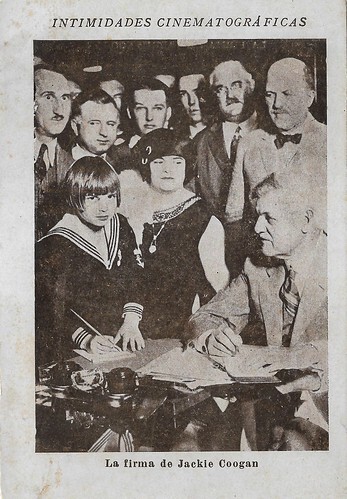
Spanish minicard (collectors card) in the series Intimidades cinematograficas, series I, card 1 of 20. Caption: Jackie Coogan's signature.
In the presence of his parents and Sam Goldwyn, Jackie Coogan signs a contract for his first film with Metro-Goldwyn.
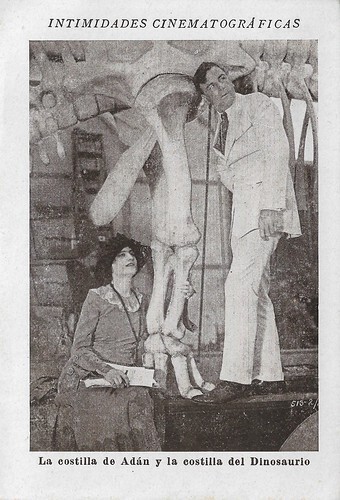
Spanish minicard (collectors card) in the series Intimidades cinematograficas, series I, card 2 of 20. Caption: Adam's rib and Dino's rib.
Milton Sills during the production of Adam's Rib (Cecil B. DeMille, 1923). The woman next to him is Jeanie MacPherson, screenwriter of the film and DeMille's regular collaborator, for whom she worked for 24 years.
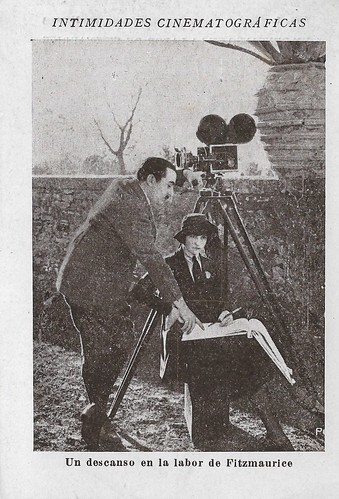
Spanish minicard (collectors card) in the series Intimidades cinematograficas, series I, card 3 of 20. Caption: A break during the work of Fitzmaurice.
Director George Fitzmaurice, discussing with his wife Ouida Bergère the production of the prestigious film The Man from Home (George Fitzmaurice, 1922), shot in Italy. It was based on a novel by Booth Tarkington.
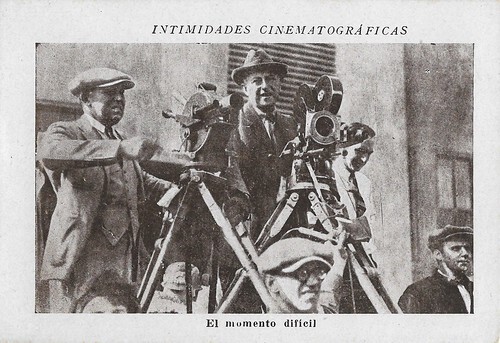
Spanish minicard (collectors card) in the series Intimidades cinematograficas, series I, card 4 of 20. Caption: The difficult moment.
Cecil B. DeMille has a difficult moment directing The Golden Bed (Cecil B. DeMille, 1925), based on a novel by Wallace Irving, as it is difficult to combine the set of characters that should appear on the screen. DeMille and his cinematographer look tense, and only one of the assistants has a smile on his face.
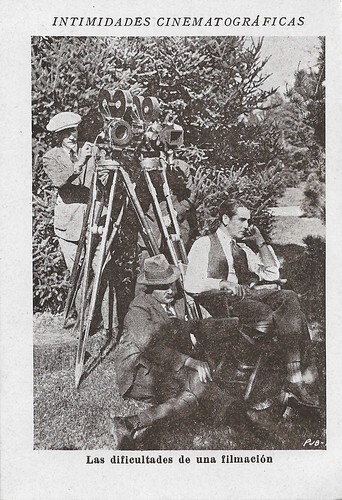
Spanish minicard (collectors card) in the series Intimidades cinematograficas, series I, card 5 of 20. Caption: The difficulties of filmmaking.
Rex Ingram and cinematographer John Seitz during the shooting of Scaramouche (Rex Ingram, 1923).
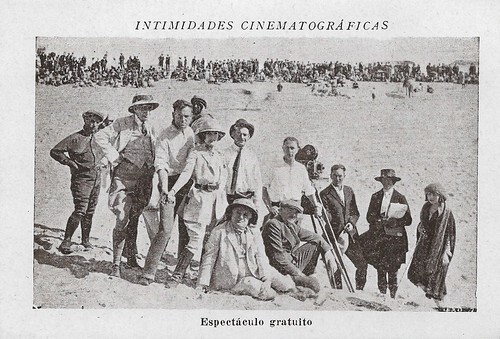
Spanish minicard (collectors card) in the series Intimidades cinematograficas, series I, card 6 of 20. Caption: Free spectacle.
According to the minicard, the photo is taken during a break in the shooting of Beyond the Rocks (Sam Wood, 1922), starring Gloria Swanson . In the background, curious spectators are visible. A beach in California is the stand-in for the Sahara.
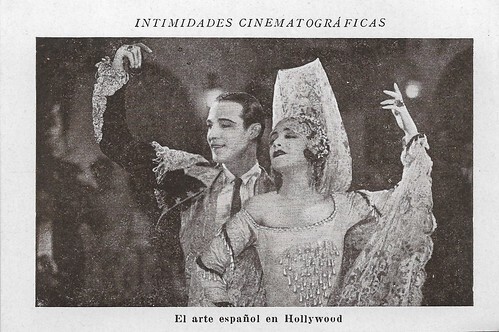
Spanish minicard (collectors card) in the series Intimidades cinematograficas, series I, card 7 of 20. Caption: Spanish art in Hollywood.
Rudolph Valentino and Helena d'Algy in A Sainted Devil (Joseph Henabery, 1924).
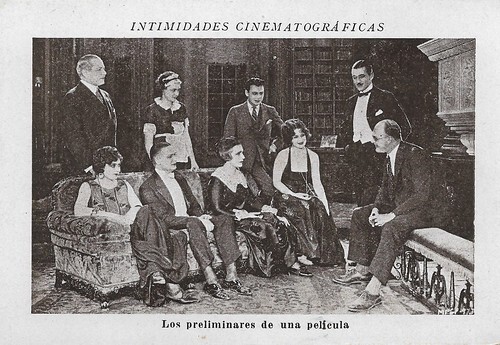
Spanish minicard (collectors card) in the series Intimidades cinematograficas, series I, card 8 of 20. Caption: The preparation of a film (scene).
Director Reginald Barker explains his film to his actors of the Metro production Pleasure Mad (Reginald Barker, 1923), based on a novel by Blanche Upright. Left to right, the actors Winifred Bryson, Huntley Gordon, Mary Alden and Norma Shearer . Behind them were the cinematographers Alvin Wyckoff and Norbert Brodin. Next to Barker, the scriptwriter Andrew Percival Younger.
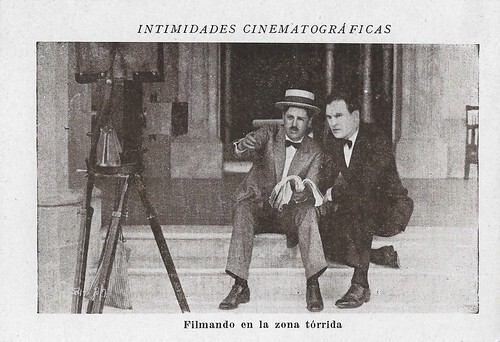
Spanish minicard (collector's card). Series Intimidades cinematograficas, series I, card 9 of 20. Caption: Filming in a stormy area.
Here, Thomas Meighan and director Alfred Green during the making of The Ne'er Do Well (Alfred Green, 1923), shot in Panama. The director, holding the film's script, points the actor to where he needs to go to, the door of the local Teatro Tivoli. Next to them, is the camera which cannot wait to get set in motion by the cinematographer, who is just finishing lunch.
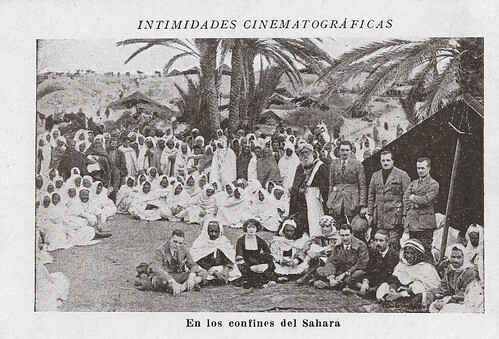
Spanish minicard (collectors card) in the series Intimidades cinematograficas, series I, card 10 of 20. Caption: At the borders of the Sahara.
Rex Ingram , Alice Terry , Ramon Novarro , and many others posing for a group photo during the making of The Arab (Rex Ingram, 1924).
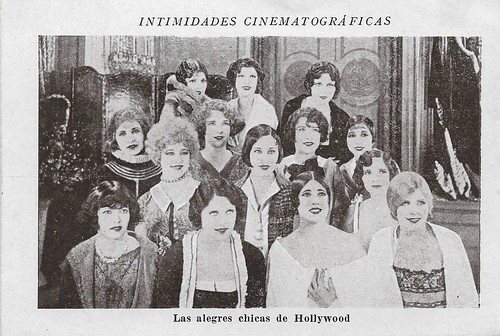
Spanish minicard (collectors card) in the series Intimidades cinematograficas, series I, card 11 of 20. Caption: The happy girls from Hollywood.
For The Dressmaker from Paris (Paul Bern, 1925), Paramount organised a beauty contest. In the end, Leatrice Joy played the female lead.
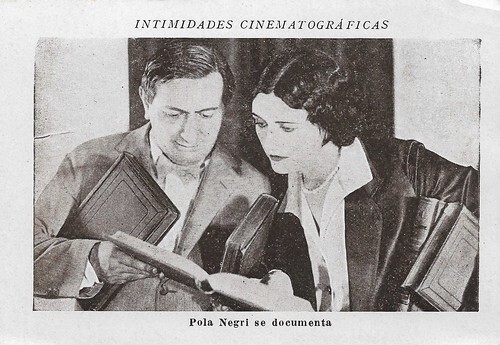
Spanish minicard (collectors card) in the series Intimidades cinematograficas, series I, card 12 of 20. Caption: Pola Negri documents herself.
Pola Negri and Ernst Lubitsch during the preparation of Forbidden Paradise Ernst (Lubitsch, 1924).
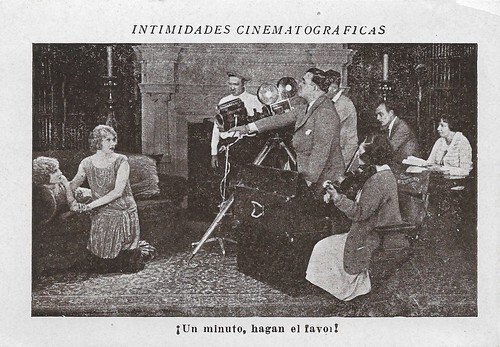
Spanish minicard (collectors card) in the series Intimidades cinematograficas, series I, card 13 of 20. Caption: One minute, if you please!
Victor Schertzinger directs Eva and Jane Novak in The Man Life Passed By (1923). Mark the female violin player on the right.
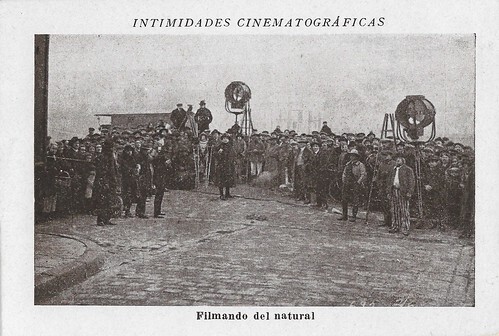
Spanish minicard (collectors card) in the series Intimidades cinematograficas, series I, card 14 of 20. Caption: Filming in the natural world.
Léonce Perret directs Madame Sans-Gêne (1925), with Gloria Swanson in the title role.
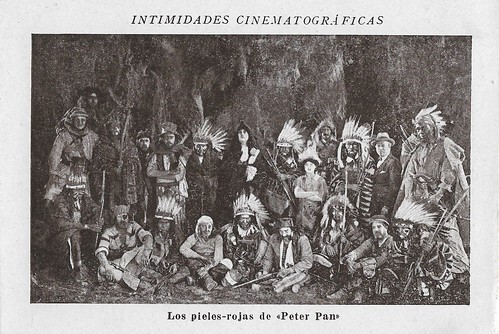
Spanish minicard (collectors card) in the series Intimidades cinematograficas, series I, card 15 of 20. Caption: The redskins from Peter Pan.
This minicard refers to Peter Pan (Herbert Brenon, 1924), starring Betty Bronson . On this card in the middle Ernest Torrence is visible as Captain Hook, while the director stands on the right. The little person may be Bronson.
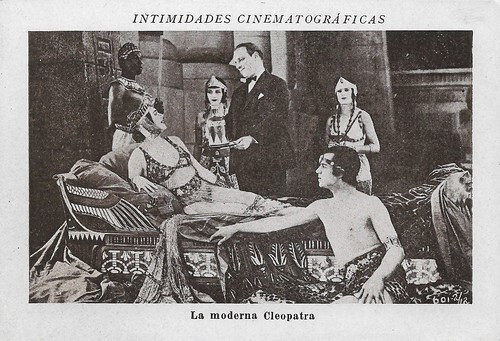
Spanish minicard (collectors card) in the series Intimidades cinematograficas, series I, card 16 of 20. Caption: The modern Cleopatra.
Nita Naldi in an intermezzo with the director at the set of Lawful Larceny (Allan Dwan, 1923).
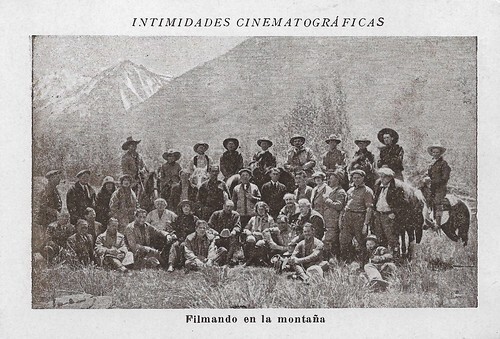
Spanish minicard (collectors card) in the series Intimidades cinematograficas, series I, card 17 of 20. Caption: Filming in the mountains
Filming in the mountains, far from Hollywood. Group photo taken during the shooting of the Metro film The Eagle's Feather (1923), directed by Edward Sloman and J. J. Hughes and cinematography by Georges Rizard, although IMDb gives other names. The film was based on the eponymous novel of Katherine Newlin Burt, adapted by Winifred Dunn. The actors James Kirkwood, Mary Alden, Lester Cuneo, and Charles McHugh are all visible on the photo.
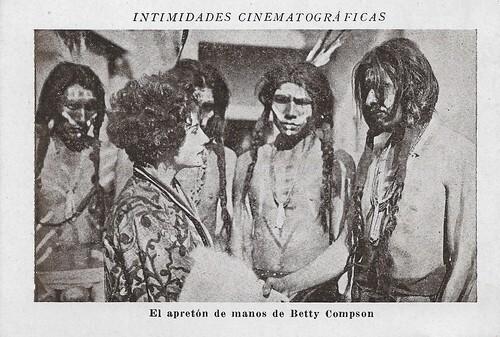
Spanish minicard (collectors card) in the series Intimidades cinematograficas, series I, card 18 of 20. Caption: The handshake of Betty Compson.
The handshake of Betty Compson to real Indians who work as extras in cinema. According to the card, the photo was taken during the making of the Paramount film La horda maldita (The cursed horde = The Thundering Herd (William K. Howard, 1925), but Compson isn't in that film. It is more likely this minicard refers to Compson's film The Pony Express (James Cruze, 1925).
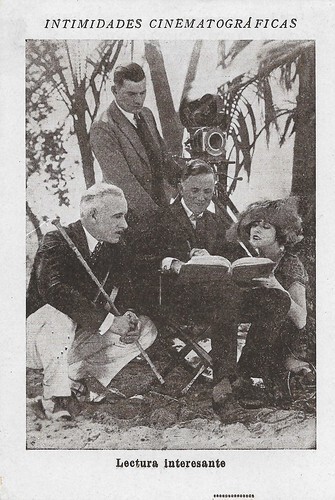
Spanish minicard (collectors card) in the series Intimidades cinematograficas, series I, card 19 of 20. Caption: Interesting reading.
Lewis Stone and Nita Naldi on their knees next to director George Melford, during the making of the Paramount film You Can't Fool Your Wife (George Melford, 1923). Behind them, the cinematographer Charles G. Clarke.
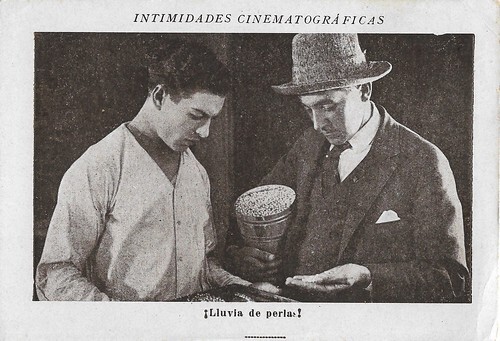
Spanish minicard (collectors card) in the series Intimidades cinematograficas, series I, card 20 of 20. Caption: A rain of pearls!
On the set of the silent Hollywood film Empire Builders (E. Mason Hopper, 1924), produced by Goldwyn. The leading actor Cullen Landis and director E. Mason Hopper closely inspect a huge collection of original pearls, worth millions of dollars (the card claims).

Spanish minicard (collectors card) in the series Intimidades cinematograficas, series I, card 1 of 20. Caption: Jackie Coogan's signature.
In the presence of his parents and Sam Goldwyn, Jackie Coogan signs a contract for his first film with Metro-Goldwyn.

Spanish minicard (collectors card) in the series Intimidades cinematograficas, series I, card 2 of 20. Caption: Adam's rib and Dino's rib.
Milton Sills during the production of Adam's Rib (Cecil B. DeMille, 1923). The woman next to him is Jeanie MacPherson, screenwriter of the film and DeMille's regular collaborator, for whom she worked for 24 years.

Spanish minicard (collectors card) in the series Intimidades cinematograficas, series I, card 3 of 20. Caption: A break during the work of Fitzmaurice.
Director George Fitzmaurice, discussing with his wife Ouida Bergère the production of the prestigious film The Man from Home (George Fitzmaurice, 1922), shot in Italy. It was based on a novel by Booth Tarkington.

Spanish minicard (collectors card) in the series Intimidades cinematograficas, series I, card 4 of 20. Caption: The difficult moment.
Cecil B. DeMille has a difficult moment directing The Golden Bed (Cecil B. DeMille, 1925), based on a novel by Wallace Irving, as it is difficult to combine the set of characters that should appear on the screen. DeMille and his cinematographer look tense, and only one of the assistants has a smile on his face.

Spanish minicard (collectors card) in the series Intimidades cinematograficas, series I, card 5 of 20. Caption: The difficulties of filmmaking.
Rex Ingram and cinematographer John Seitz during the shooting of Scaramouche (Rex Ingram, 1923).

Spanish minicard (collectors card) in the series Intimidades cinematograficas, series I, card 6 of 20. Caption: Free spectacle.
According to the minicard, the photo is taken during a break in the shooting of Beyond the Rocks (Sam Wood, 1922), starring Gloria Swanson . In the background, curious spectators are visible. A beach in California is the stand-in for the Sahara.

Spanish minicard (collectors card) in the series Intimidades cinematograficas, series I, card 7 of 20. Caption: Spanish art in Hollywood.
Rudolph Valentino and Helena d'Algy in A Sainted Devil (Joseph Henabery, 1924).

Spanish minicard (collectors card) in the series Intimidades cinematograficas, series I, card 8 of 20. Caption: The preparation of a film (scene).
Director Reginald Barker explains his film to his actors of the Metro production Pleasure Mad (Reginald Barker, 1923), based on a novel by Blanche Upright. Left to right, the actors Winifred Bryson, Huntley Gordon, Mary Alden and Norma Shearer . Behind them were the cinematographers Alvin Wyckoff and Norbert Brodin. Next to Barker, the scriptwriter Andrew Percival Younger.

Spanish minicard (collector's card). Series Intimidades cinematograficas, series I, card 9 of 20. Caption: Filming in a stormy area.
Here, Thomas Meighan and director Alfred Green during the making of The Ne'er Do Well (Alfred Green, 1923), shot in Panama. The director, holding the film's script, points the actor to where he needs to go to, the door of the local Teatro Tivoli. Next to them, is the camera which cannot wait to get set in motion by the cinematographer, who is just finishing lunch.

Spanish minicard (collectors card) in the series Intimidades cinematograficas, series I, card 10 of 20. Caption: At the borders of the Sahara.
Rex Ingram , Alice Terry , Ramon Novarro , and many others posing for a group photo during the making of The Arab (Rex Ingram, 1924).

Spanish minicard (collectors card) in the series Intimidades cinematograficas, series I, card 11 of 20. Caption: The happy girls from Hollywood.
For The Dressmaker from Paris (Paul Bern, 1925), Paramount organised a beauty contest. In the end, Leatrice Joy played the female lead.

Spanish minicard (collectors card) in the series Intimidades cinematograficas, series I, card 12 of 20. Caption: Pola Negri documents herself.
Pola Negri and Ernst Lubitsch during the preparation of Forbidden Paradise Ernst (Lubitsch, 1924).

Spanish minicard (collectors card) in the series Intimidades cinematograficas, series I, card 13 of 20. Caption: One minute, if you please!
Victor Schertzinger directs Eva and Jane Novak in The Man Life Passed By (1923). Mark the female violin player on the right.

Spanish minicard (collectors card) in the series Intimidades cinematograficas, series I, card 14 of 20. Caption: Filming in the natural world.
Léonce Perret directs Madame Sans-Gêne (1925), with Gloria Swanson in the title role.

Spanish minicard (collectors card) in the series Intimidades cinematograficas, series I, card 15 of 20. Caption: The redskins from Peter Pan.
This minicard refers to Peter Pan (Herbert Brenon, 1924), starring Betty Bronson . On this card in the middle Ernest Torrence is visible as Captain Hook, while the director stands on the right. The little person may be Bronson.

Spanish minicard (collectors card) in the series Intimidades cinematograficas, series I, card 16 of 20. Caption: The modern Cleopatra.
Nita Naldi in an intermezzo with the director at the set of Lawful Larceny (Allan Dwan, 1923).

Spanish minicard (collectors card) in the series Intimidades cinematograficas, series I, card 17 of 20. Caption: Filming in the mountains
Filming in the mountains, far from Hollywood. Group photo taken during the shooting of the Metro film The Eagle's Feather (1923), directed by Edward Sloman and J. J. Hughes and cinematography by Georges Rizard, although IMDb gives other names. The film was based on the eponymous novel of Katherine Newlin Burt, adapted by Winifred Dunn. The actors James Kirkwood, Mary Alden, Lester Cuneo, and Charles McHugh are all visible on the photo.

Spanish minicard (collectors card) in the series Intimidades cinematograficas, series I, card 18 of 20. Caption: The handshake of Betty Compson.
The handshake of Betty Compson to real Indians who work as extras in cinema. According to the card, the photo was taken during the making of the Paramount film La horda maldita (The cursed horde = The Thundering Herd (William K. Howard, 1925), but Compson isn't in that film. It is more likely this minicard refers to Compson's film The Pony Express (James Cruze, 1925).

Spanish minicard (collectors card) in the series Intimidades cinematograficas, series I, card 19 of 20. Caption: Interesting reading.
Lewis Stone and Nita Naldi on their knees next to director George Melford, during the making of the Paramount film You Can't Fool Your Wife (George Melford, 1923). Behind them, the cinematographer Charles G. Clarke.

Spanish minicard (collectors card) in the series Intimidades cinematograficas, series I, card 20 of 20. Caption: A rain of pearls!
On the set of the silent Hollywood film Empire Builders (E. Mason Hopper, 1924), produced by Goldwyn. The leading actor Cullen Landis and director E. Mason Hopper closely inspect a huge collection of original pearls, worth millions of dollars (the card claims).
Published on March 12, 2023 23:00
March 11, 2023
Photo by Trevisani
Italian photographer Paolo Trevisani was based in Bologna and his studio was active between 1900 and ca. 1930. Little is known about his biography. In the 1910s, Trevisani started to make photo portraits of such celebrities as author Luigi Pirandello and stage and film diva Lyda Borelli.

Italian postcard by Ed. A Traldi, Milano, no. 44. Photo: Trevisani, Bologna.
Italian stage and screen actor Luigi Almirante (1886–1963) obtained a resounding success with the plays by Luigi Pirandello, especially in the drama 'Sei personaggi in cerca d'autore' (Six Characters in Search of an Author). From 1926 on, he also devoted himself to the cinema. In the sound era, he began to emerge in comical roles. His slender body and his wiry face made him an incisive comic actor.
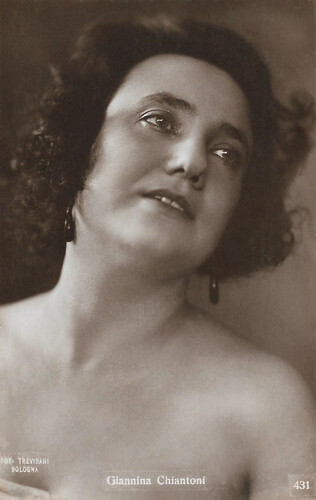
Italian postcard, Milano, no. 431. Photo: Trevisani, Bologna.
Giannina Chiantoni (1881–1972) was an Italian stage and screen actress. She made her screen debut in 1910 at Film d'Arte Italiana (FAI), the Italian subsidiary of Pathé Freres, but her silent film performances remained scarce. From the mid-1930s she returned to the sets for supporting parts in films by Alessandro Blasetti and Enrico Guazzoni.
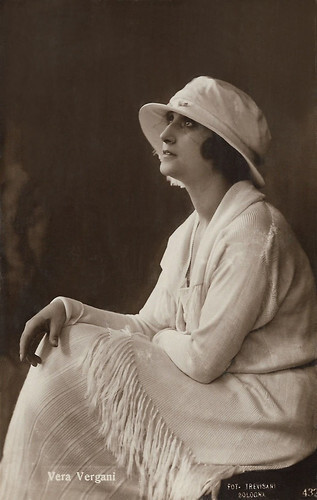
Italian postcard by Ed. A. Traldi, Milano, no. 432. Photo: Trevisani, Bologna.
Vera Vergani (1894-1989) was an Italian stage and film actress. She not only performed in the first stagings of Luigi Pirandello’s plays but in 1916-1921 she also knew a career as an actress in Italian silent cinema.
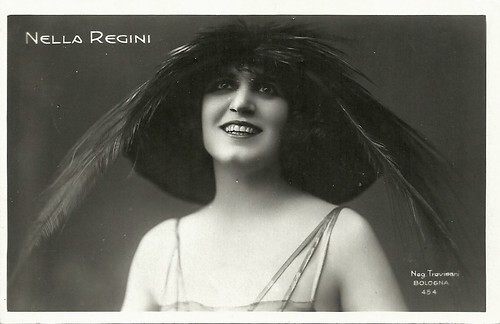
Italian postcard by Ed. A. Traldi, Milano, no. 454. Photo: Trevisani, Bologna.
Nella Regini was not a film actress, but one of the most famous stars of the Italian operetta during the 1920s.
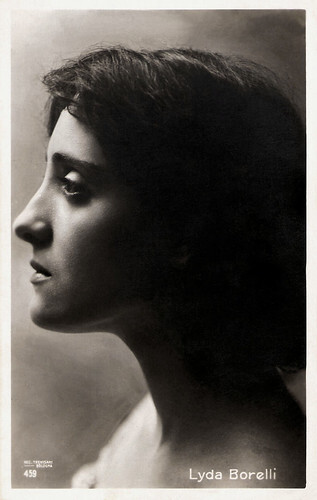
Italian postcard by Ed. A. Traldi, Milano, no. 459. Photo: Trevisani, Bologna.
Lyda Borelli (1887-1959) was already an acclaimed stage actress before she became the first diva of Italian silent cinema. The fascinating film star caused a craze among female fans called 'Borellismo'
Paolo Trevisani
Very little is known about photographer Paolo Trevisani. On 5 April 1901, Trevisani and his partner Mario Pozzi succeeded the Angiolini studio at the Palazzo Pepoli in the Via Castiglione 1339 (now no. 6), in the old Palazzo Pepoli in Bologna.
In 1837, Luigi Angiolini, Girolamo Angiolini and Luigi Mazzoni set up a company for typography and lithography in Bologna in Via Altabella 1636. The opening of the first photographic studio probably dates back to June 1858, when Luigi Angiolini moved the company to the premises in Via Castiglione.
In 1869, the year of Luigi Angiolini's death, the business passed to his four sons who kept the company name 'Luigi Angiolini e C.' until 1885. It was to be the three sisters Amalia, Cesira and Adele Angiolini who continued the business after their brother Ugo Felice left Bologna in c. 1870. From 1881 the sisters used the name 'M.lles Angiolini'.
The sisters participated in the Italian General Exhibition in Turin in 1884 and received a silver medal from the Bologna Chamber of Commerce for the photographs exhibited including a portrait of Queen Margherita.
In 1901, the sisters sold the company in Bologna to Mario Pozzi and Paolo Trevisani. According to an advertisement, they produced "portraits on novelty cards, unalterable enlargements, photographs on porcelain and on enamel, reproductions and watercolour works, and miniatures on ivory".
The company ceased to exist on 1 March 1905. Paolo Trevisani subsequently took over the studio that had formerly been owned by Roberto Peli. He must have been quite successful and in January 1907 his photos were presented at the Exhibition of Decorative Art in Bologna. We could not find information about Trevisani's later activities.
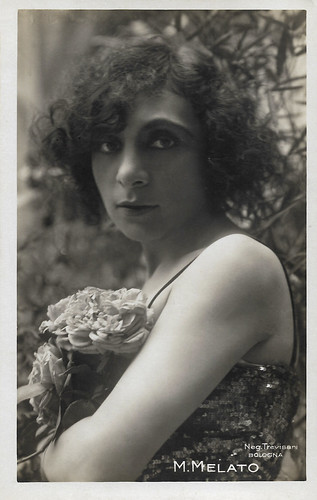
Italian postcard by Vettori, Bologna. Photo: Trevisani, Bologna.
Italian actress Maria Melato (1885-1950) appeared in the theatre, on the radio and in the cinema. Her films included Ritorno/Return (1914), Anna Karenina (1917) and Il volo degli aironi/The flight of the herons (1920). Unfortunately, all her films are considered lost.
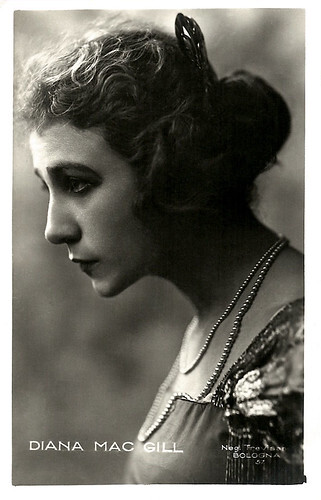
Italian postcard by Vettori, Bologna, no. 37. Photo: Trevisani, Bologna.
Italian actress and singer Diana MacGill (1899-1968) was the prima donna of the Nuovo Teatro Futurista, in which she appeared on stage with Marinetti and others, offering intelligent 'futurist declamations'. For L.M.B. Film, she starred in several silent films. She also excelled in the more traditional variety shows because of her beautiful vocal style and fine diction.
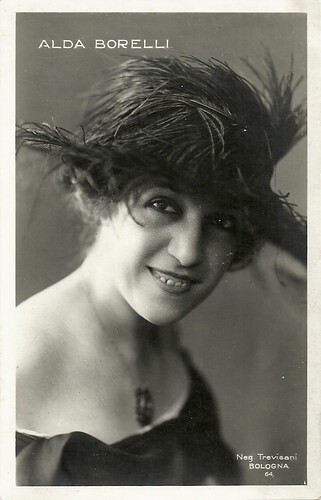
Italian postcard by Vettori, Bologna,, no. 64. Photo: Trevisani, Bologna.
Alda Borelli (1879-1964) was an Italian stage and screen actress, who peaked on stage in the 1920s and also acted in a handful of silent films in the 1910s. She was the sister of the Italian film diva Lyda Borelli.
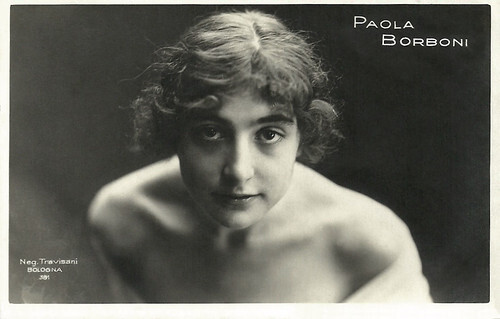
Italian postcard by Ed. Vettori, Bologna, no. 381 Photo: Trevisani, Bologna.
Paola Borboni (1900-1995) was one of the greatest stage actresses in Italy. She also played in many films. She was also often heard on the radio and seen on television, but her true passion was the stage.
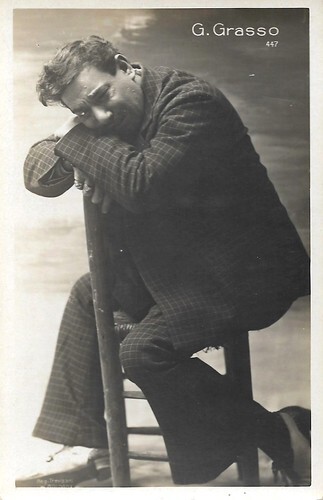
Italian postcard by Ed. Vettori, Bologna, no. 447. Photo Trevisani.
Italian stage and screen actor Giovanni Grasso (1873-1930) was known as the best Sicilian tragic actor and one of the best in Italy. Grasso also had a limited but important career in Italian silent cinema.
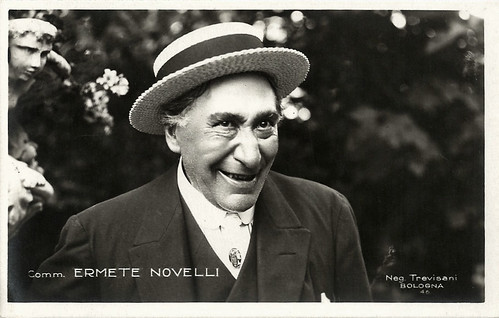
Italian postcard by Ed. Vettori, Bologna, no. 46. Photo: Trevisani, Bologna.
Italian actor Ermete Novelli (1851-1919) was a legendary monstre sacré of the theatre. In the 1910s he appeared in films by Film d'Arte Italiana, Ambrosio and Raggio Film.
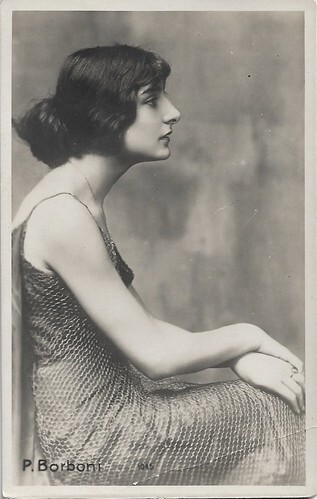
Italian postcard by Ed. Vettori, Bologna, no. 1045. Photo: Trevisani, Bologna.
Paola Borboni (1900-1995) was one of the greatest stage actresses in Italy. She also played in many films. She was also often heard on the radio and seen on television, but her true passion was the stage.
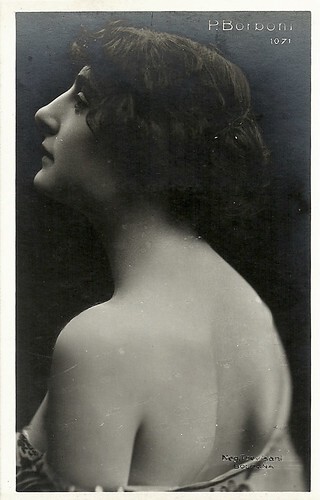
Italian postcard by Ed. Vettori, Bologna, no. 1071. Photo: Trevisani, Bologna.
Paola Borboni (1900-1995) was one of the greatest stage actresses in Italy. She also played in many films and was often heard on the radio and seen on television, but her true passion was the stage.
Sources: Biblioteca dell'Archiginassio (Italian) and ERPAC Patrimonio Culturale (Italian).

Italian postcard by Ed. A Traldi, Milano, no. 44. Photo: Trevisani, Bologna.
Italian stage and screen actor Luigi Almirante (1886–1963) obtained a resounding success with the plays by Luigi Pirandello, especially in the drama 'Sei personaggi in cerca d'autore' (Six Characters in Search of an Author). From 1926 on, he also devoted himself to the cinema. In the sound era, he began to emerge in comical roles. His slender body and his wiry face made him an incisive comic actor.

Italian postcard, Milano, no. 431. Photo: Trevisani, Bologna.
Giannina Chiantoni (1881–1972) was an Italian stage and screen actress. She made her screen debut in 1910 at Film d'Arte Italiana (FAI), the Italian subsidiary of Pathé Freres, but her silent film performances remained scarce. From the mid-1930s she returned to the sets for supporting parts in films by Alessandro Blasetti and Enrico Guazzoni.

Italian postcard by Ed. A. Traldi, Milano, no. 432. Photo: Trevisani, Bologna.
Vera Vergani (1894-1989) was an Italian stage and film actress. She not only performed in the first stagings of Luigi Pirandello’s plays but in 1916-1921 she also knew a career as an actress in Italian silent cinema.

Italian postcard by Ed. A. Traldi, Milano, no. 454. Photo: Trevisani, Bologna.
Nella Regini was not a film actress, but one of the most famous stars of the Italian operetta during the 1920s.

Italian postcard by Ed. A. Traldi, Milano, no. 459. Photo: Trevisani, Bologna.
Lyda Borelli (1887-1959) was already an acclaimed stage actress before she became the first diva of Italian silent cinema. The fascinating film star caused a craze among female fans called 'Borellismo'
Paolo Trevisani
Very little is known about photographer Paolo Trevisani. On 5 April 1901, Trevisani and his partner Mario Pozzi succeeded the Angiolini studio at the Palazzo Pepoli in the Via Castiglione 1339 (now no. 6), in the old Palazzo Pepoli in Bologna.
In 1837, Luigi Angiolini, Girolamo Angiolini and Luigi Mazzoni set up a company for typography and lithography in Bologna in Via Altabella 1636. The opening of the first photographic studio probably dates back to June 1858, when Luigi Angiolini moved the company to the premises in Via Castiglione.
In 1869, the year of Luigi Angiolini's death, the business passed to his four sons who kept the company name 'Luigi Angiolini e C.' until 1885. It was to be the three sisters Amalia, Cesira and Adele Angiolini who continued the business after their brother Ugo Felice left Bologna in c. 1870. From 1881 the sisters used the name 'M.lles Angiolini'.
The sisters participated in the Italian General Exhibition in Turin in 1884 and received a silver medal from the Bologna Chamber of Commerce for the photographs exhibited including a portrait of Queen Margherita.
In 1901, the sisters sold the company in Bologna to Mario Pozzi and Paolo Trevisani. According to an advertisement, they produced "portraits on novelty cards, unalterable enlargements, photographs on porcelain and on enamel, reproductions and watercolour works, and miniatures on ivory".
The company ceased to exist on 1 March 1905. Paolo Trevisani subsequently took over the studio that had formerly been owned by Roberto Peli. He must have been quite successful and in January 1907 his photos were presented at the Exhibition of Decorative Art in Bologna. We could not find information about Trevisani's later activities.

Italian postcard by Vettori, Bologna. Photo: Trevisani, Bologna.
Italian actress Maria Melato (1885-1950) appeared in the theatre, on the radio and in the cinema. Her films included Ritorno/Return (1914), Anna Karenina (1917) and Il volo degli aironi/The flight of the herons (1920). Unfortunately, all her films are considered lost.

Italian postcard by Vettori, Bologna, no. 37. Photo: Trevisani, Bologna.
Italian actress and singer Diana MacGill (1899-1968) was the prima donna of the Nuovo Teatro Futurista, in which she appeared on stage with Marinetti and others, offering intelligent 'futurist declamations'. For L.M.B. Film, she starred in several silent films. She also excelled in the more traditional variety shows because of her beautiful vocal style and fine diction.

Italian postcard by Vettori, Bologna,, no. 64. Photo: Trevisani, Bologna.
Alda Borelli (1879-1964) was an Italian stage and screen actress, who peaked on stage in the 1920s and also acted in a handful of silent films in the 1910s. She was the sister of the Italian film diva Lyda Borelli.

Italian postcard by Ed. Vettori, Bologna, no. 381 Photo: Trevisani, Bologna.
Paola Borboni (1900-1995) was one of the greatest stage actresses in Italy. She also played in many films. She was also often heard on the radio and seen on television, but her true passion was the stage.

Italian postcard by Ed. Vettori, Bologna, no. 447. Photo Trevisani.
Italian stage and screen actor Giovanni Grasso (1873-1930) was known as the best Sicilian tragic actor and one of the best in Italy. Grasso also had a limited but important career in Italian silent cinema.

Italian postcard by Ed. Vettori, Bologna, no. 46. Photo: Trevisani, Bologna.
Italian actor Ermete Novelli (1851-1919) was a legendary monstre sacré of the theatre. In the 1910s he appeared in films by Film d'Arte Italiana, Ambrosio and Raggio Film.

Italian postcard by Ed. Vettori, Bologna, no. 1045. Photo: Trevisani, Bologna.
Paola Borboni (1900-1995) was one of the greatest stage actresses in Italy. She also played in many films. She was also often heard on the radio and seen on television, but her true passion was the stage.

Italian postcard by Ed. Vettori, Bologna, no. 1071. Photo: Trevisani, Bologna.
Paola Borboni (1900-1995) was one of the greatest stage actresses in Italy. She also played in many films and was often heard on the radio and seen on television, but her true passion was the stage.
Sources: Biblioteca dell'Archiginassio (Italian) and ERPAC Patrimonio Culturale (Italian).
Published on March 11, 2023 22:00
March 10, 2023
Russell Merritt (1941-2023)
American film historian Russell Merritt passed away on 2 March 2023 at age 82. Merritt wrote a groundbreaking dissertation on D.W. Griffith, co-wrote two books on the early work of Walt Disney and was a fan of Sherlock Holmes. Russell and his wife Karen were friends with Ivo Blom and we often met in Pordenone at the Giornate del Cinema Muto. Here at EFSP, Ivo commemorates his old friend with a selection of postcards which Russell would have loved. Our hearts go out to Karen during this difficult time.
Griffith
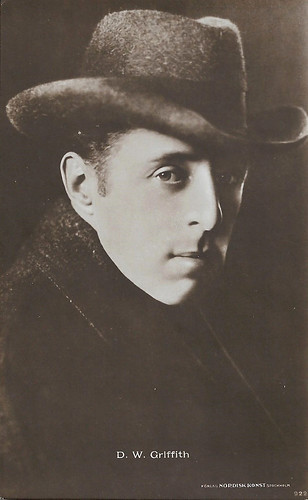
Swedish postcard by Förlag Nordisk Konst, Stockholm, no. 922. A rare portrait of the famous American film director D.W. Griffith .

American postcard. Kraus Manufacturing Company, New York 1913. Biograph Co. Henry B. Walthall (1878-1936) was a prolific actor at D.W. Griffith's American Biograph and played in countless films there. The culmination of the Griffith-Walthall connection was Walthall's role as Colonel Ben Cameron in The Birth of a Nation (1915).
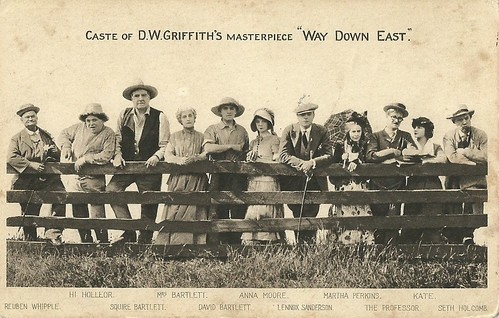
British postcard by Cinema Art, London. The cast of D.W. Griffith 's film Way Down East (1920). From left to right, the actors George Neville, Edgar Nelson, Burr McIntosh, Kate Bruce, Richard Barthelmess , Lillian Gish , Lowell Sherman, Vivia Ogden, Creighton Hale, Mary Hay and Porter Strong.
Walt in Wonderland: Ub Iwerks & Disney
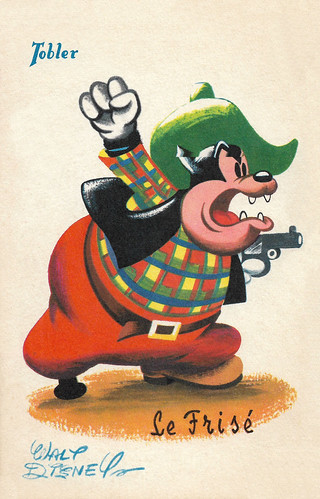
French postcard by Imp. Georges Lang, Paris, offered by Chocolats Tobler. Image: Walt Disney. Pete or Peg-Leg Pete is a villainous cat created by Walt Disney and Ub Iwerks. He is the arch-nemesis of Mickey Mouse, normally characterised as a cigar-smoking thug with a ruthless and tyrannical personality. Some of Pete’s most notable traits include his Herculean strength and thunderous cackle. Pete’s most frequent scheme involves kidnapping Minnie Mouse for lecherous purposes. Pete first appeared in Alice Solves the Puzzle (1925). He was a bear-like animal that frequently antagonised Alice and her friend, Julius. The Alice Comedies were produced three years before the first appearance of Mickey, which makes Pete the oldest recurring Disney character and the first villain to be conceived by the studio.
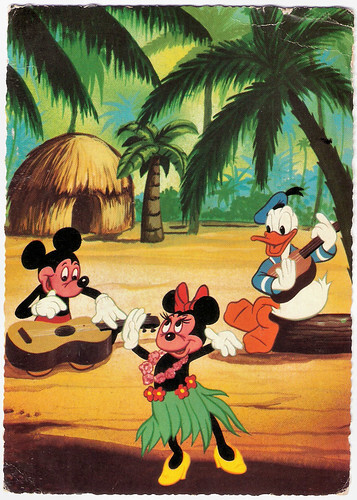
French postcard. Illustration: Walt Disney Productions. Sent by mail in 1967. Mickey Mouse is a funny animal cartoon character and the mascot of The Walt Disney Company. He was created by Walt Disney and Ub Iwerks at the Walt Disney Studios in 1928. An anthropomorphic mouse who typically wears red shorts, large yellow shoes, and white gloves, Mickey is one of the world's most recognisable characters. Mickey was created as a replacement for a prior Disney character, Oswald the Lucky Rabbit. He debuted publicly in the short film Steamboat Willie (1928), one of the first sound cartoons. He went on to appear in over 130 films.
Mickey Mouse's uncle
Russell Merritt was born in 1941 and grew up in New Jersey and Connecticut. At a young age, he discovered the medium of film, which opened new avenues for him to art, literature, music etc. In high school, he watched Birth of a Nation (1915) and then discovered the "father of film". His PhD dissertation at Harvard was on the 485 short- to full-length films D.W. Griffith made between 1908 and 1913. He researched his work at such length that he became an expert on Griffith. Eventually, he would be also an adviser on the Emmy-awarded TV series Griffith, Father of Film, while he was also one of the prominent contributors to the long-running Griffth Project at the Giornate del Cinema Muto.
His interest in Griffith led to a more general fascination with silent film and with various film styles and genres — from animation to national cinema (French, Italian, Japanese, and German), to the films of the 1950s. His first academic article was on Alain Resnais'L'Année dernière à Marienbad/Last Year at Marienbad (1961), and his favourite film was Jean Renoir 's La règle du jeu/Rules of the Game (1939).
Russell also favoured research on early Disney animation resulting in his co-authorship of 'Walt in Wonderland: The Silent Films of Walt Disney' (2000) and 'Walt Disney's Silly Symphonies: A Companion to the Walt Disney Cartoon Series' (2006). Here he was also much intrigued by Disney's sources and appropriations, from the early animation of Pat Sullivan's Felix the Cat to Chaplin and Keaton. Indeed, he was fascinated when the Dutch Filmmuseum (now Eye) found and preserved a whole range of combined animation & live-action silent shorts by Disney with the character Alice during the 1990s.
For decades Russell enthused his students with his film history classes, first at the University of Wisconsin-Madison and from 1986 at the University of California-Berkeley. He also produced and directed the Great Nickelodeon Show, a recreation of a turn-of-the-century nickelodeon program which has played at the Telluride Film Festival, Le Giornate del Cinema Muto, the Los Angeles Film Festival, the TCM Film Festival and other venues.
In addition to the mentioned publications and many more articles on Griffith, Russell Merritt also published on e.g. Sherlock Holmes on film, precinema, Sergei Eisenstein , music for silent film, and the end of Technicolor. At the site of Le Giornate del Cinema Muto is written: "There will be no Russell Merritt at the next edition of Le Giornate del Cinema Muto and it will be the first time since 1986. At that time he had come to Pordenone thanks to his fraternal friend David Shepard of the Directors Guild of America, to whom the Le Giornate paid tribute that year on the occasion of its 50th anniversary. Since then Pordenone had become his second home. A regular and familiar presence, for everyone Mickey Mouse's uncle for his studies and books on the early Walt Disney, for the Days an incomparable collaborator and friend of the festival, which he had helped to make known in the United States." We will miss him.
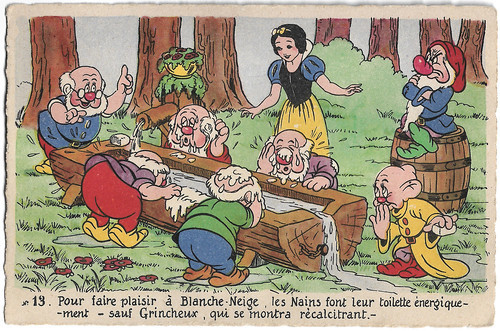
French postcard by Editions Superluxe, Paris, no. 13. Image: Walt Disney - Micky Mouse S.A.. Publicity still for Snow White and the Seven Dwarfs (William Cottrell, David Hand, Wilfred Jackson, Larry Morey, Perce Pearce, Ben Sharpsteen, 1937). Caption: To please Snow White, the Dwarves wash vigorously - except Grumpy who is noticeably obstinate.
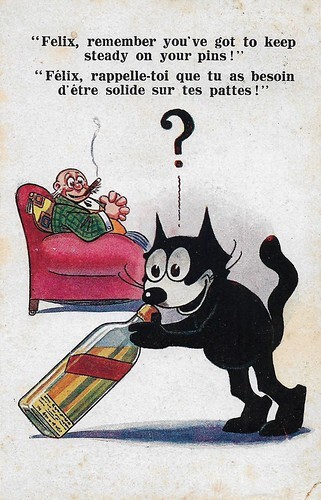
Franco-British postcard by Milton, Woolstone Bros. of London. Design by Pat Sullivan. Inspiration: Felix the cat. Caption: "Felix, remember you've got to keep steady on your pins/Félix, rappelle-toi que tu as besoin d'être solide sur tes pattes."
Silly Symphonies
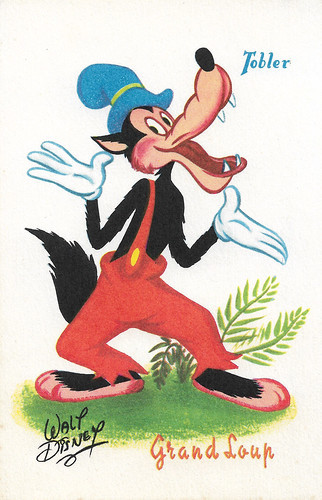
French postcard by Imp. Georges Lang, Paris, offered by Chocolats Tobler. Image: Walt Disney. The Big Bad Wolf is the main antagonist of the Silly Symphonies short Three Little Pigs (Burt Gillett, 1933) and its sequels. As his name suggests, he is a ruthless, conniving wolf who constantly plots to capture and eat the Three Little Pigs.
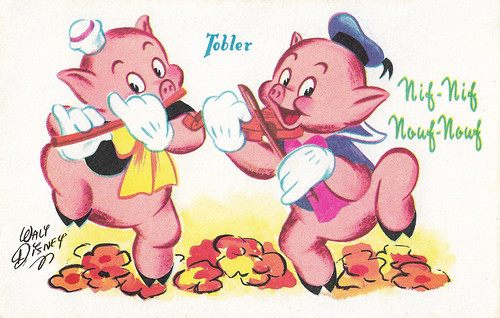
French postcard by Imp. Georges Lang, Paris, offered by Chocolats Tobler. Image: Walt Disney. Fifer Pig and Fiddler Pig are two of the three little pigs of the classic Silly Symphonies short Three Little Pigs (Burt Gillett, 1933) and its three follow-up shorts, The Big Bad Wolf (Burt Gillett, 1934), Three Little Wolves (Burt Gillett, David Hand, 1936), and The Practical Pig (Dick Rickard, 1939). The three pigs are constantly targeted by the Big Bad Wolf, who wants to eat them for dinner.
Sherlock Holmes - on stage and in the cinema
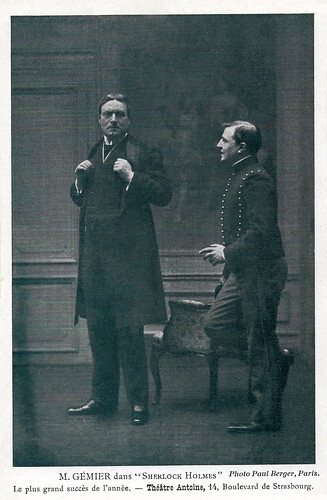
French postcard by Imprimerie Darjeanne. Photo: Paul Berger, Paris. Firmin Gémier in the play 'Sherlock Holmes' at the Théâtre Antoine, Paris. Caption: The biggest success of the year. The play 'Sherlock Holmes' (1899) by William Gillette and based on the famous stories by Arthur Conan Doyle, was first performed in a French version by Pierre Decourcelle, at the Théâtre Antoine in Paris in 1907.
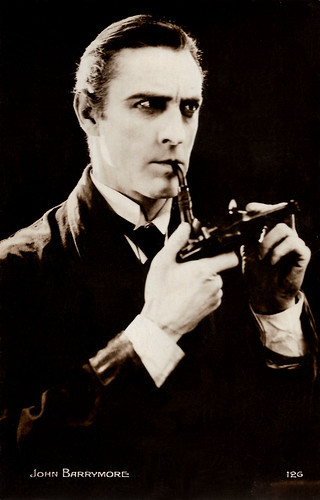
French postcard by Editions Cinémagazine, no. 126. John Barrymore in Sherlock Holmes (Albert Parker, 1922).
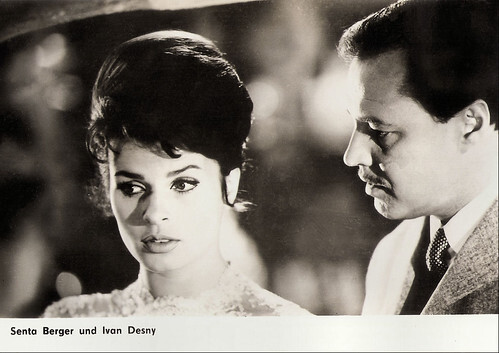
East German postcard by VEB Progress Filmvertrieb, Berlin, no. 3012, 1967 Photo: Senta Berger and Ivan Desny in Sherlock Holmes und das Halsband des Todes/Sherlock Holmes and the Deadly Necklace (Terence Fisher, 1962).
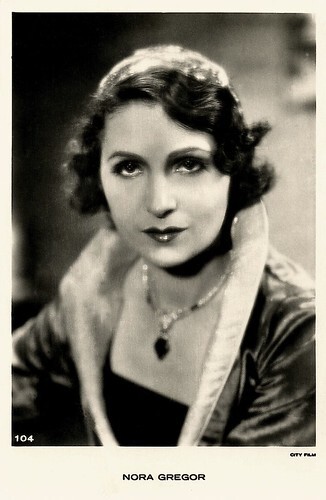
Dutch postcard by City Film, no. 104. Austrian Nora Gregor (1901-1949) was an operetta diva, stage and film actress. Her most famous screen role was as Christine in Jean Renoir's classic film La Règle du Jeu (1938).

Rialto Theater, 812 South Broadway, Los Angeles, CA, United States. This former cinema was built in 1917 as Quinn's Rialto, a nickelodeon. Architect was Oliver Perry Dennis and exhibitor was J.M. Quinn. The Rialto was purchased by Sid Grauman in 1919 and it quickly became part of his growing empire. Grauman gave it a remodel using William Woollett as the architect and for awhile it was known as Grauman's Rialto. The seating was 1,000 originally, and 840 in later years.
Technicolor & Senso
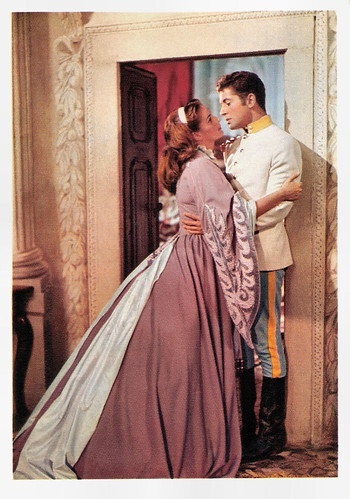
Italian postcard by Rotocalco Dagnino, Torino. Photo: Lux Film. Alida Valli and Farley Granger as countess Livia Serpieri and Lt. Franz Mahler in Luchino Visconti's historical film Senso (1954). This scene was shot at the 16th century Villa Godi-Malinverni at Lonedo, Lugo di Vicenza - Andrea Palladio's oldest villa, once called Villa Valmarana. The costumes are by Marcel Escoffier and Piero Tosi. Senso was one of the earliest colour features in Italian film production and is a masterpiece of colour cinema.
Sources: Hilary Kaiser (Berkeley Olli), Laughing Place, Le Giornate del Cinema Muto (Italian), and .
Griffith

Swedish postcard by Förlag Nordisk Konst, Stockholm, no. 922. A rare portrait of the famous American film director D.W. Griffith .

American postcard. Kraus Manufacturing Company, New York 1913. Biograph Co. Henry B. Walthall (1878-1936) was a prolific actor at D.W. Griffith's American Biograph and played in countless films there. The culmination of the Griffith-Walthall connection was Walthall's role as Colonel Ben Cameron in The Birth of a Nation (1915).

British postcard by Cinema Art, London. The cast of D.W. Griffith 's film Way Down East (1920). From left to right, the actors George Neville, Edgar Nelson, Burr McIntosh, Kate Bruce, Richard Barthelmess , Lillian Gish , Lowell Sherman, Vivia Ogden, Creighton Hale, Mary Hay and Porter Strong.
Walt in Wonderland: Ub Iwerks & Disney

French postcard by Imp. Georges Lang, Paris, offered by Chocolats Tobler. Image: Walt Disney. Pete or Peg-Leg Pete is a villainous cat created by Walt Disney and Ub Iwerks. He is the arch-nemesis of Mickey Mouse, normally characterised as a cigar-smoking thug with a ruthless and tyrannical personality. Some of Pete’s most notable traits include his Herculean strength and thunderous cackle. Pete’s most frequent scheme involves kidnapping Minnie Mouse for lecherous purposes. Pete first appeared in Alice Solves the Puzzle (1925). He was a bear-like animal that frequently antagonised Alice and her friend, Julius. The Alice Comedies were produced three years before the first appearance of Mickey, which makes Pete the oldest recurring Disney character and the first villain to be conceived by the studio.

French postcard. Illustration: Walt Disney Productions. Sent by mail in 1967. Mickey Mouse is a funny animal cartoon character and the mascot of The Walt Disney Company. He was created by Walt Disney and Ub Iwerks at the Walt Disney Studios in 1928. An anthropomorphic mouse who typically wears red shorts, large yellow shoes, and white gloves, Mickey is one of the world's most recognisable characters. Mickey was created as a replacement for a prior Disney character, Oswald the Lucky Rabbit. He debuted publicly in the short film Steamboat Willie (1928), one of the first sound cartoons. He went on to appear in over 130 films.
Mickey Mouse's uncle
Russell Merritt was born in 1941 and grew up in New Jersey and Connecticut. At a young age, he discovered the medium of film, which opened new avenues for him to art, literature, music etc. In high school, he watched Birth of a Nation (1915) and then discovered the "father of film". His PhD dissertation at Harvard was on the 485 short- to full-length films D.W. Griffith made between 1908 and 1913. He researched his work at such length that he became an expert on Griffith. Eventually, he would be also an adviser on the Emmy-awarded TV series Griffith, Father of Film, while he was also one of the prominent contributors to the long-running Griffth Project at the Giornate del Cinema Muto.
His interest in Griffith led to a more general fascination with silent film and with various film styles and genres — from animation to national cinema (French, Italian, Japanese, and German), to the films of the 1950s. His first academic article was on Alain Resnais'L'Année dernière à Marienbad/Last Year at Marienbad (1961), and his favourite film was Jean Renoir 's La règle du jeu/Rules of the Game (1939).
Russell also favoured research on early Disney animation resulting in his co-authorship of 'Walt in Wonderland: The Silent Films of Walt Disney' (2000) and 'Walt Disney's Silly Symphonies: A Companion to the Walt Disney Cartoon Series' (2006). Here he was also much intrigued by Disney's sources and appropriations, from the early animation of Pat Sullivan's Felix the Cat to Chaplin and Keaton. Indeed, he was fascinated when the Dutch Filmmuseum (now Eye) found and preserved a whole range of combined animation & live-action silent shorts by Disney with the character Alice during the 1990s.
For decades Russell enthused his students with his film history classes, first at the University of Wisconsin-Madison and from 1986 at the University of California-Berkeley. He also produced and directed the Great Nickelodeon Show, a recreation of a turn-of-the-century nickelodeon program which has played at the Telluride Film Festival, Le Giornate del Cinema Muto, the Los Angeles Film Festival, the TCM Film Festival and other venues.
In addition to the mentioned publications and many more articles on Griffith, Russell Merritt also published on e.g. Sherlock Holmes on film, precinema, Sergei Eisenstein , music for silent film, and the end of Technicolor. At the site of Le Giornate del Cinema Muto is written: "There will be no Russell Merritt at the next edition of Le Giornate del Cinema Muto and it will be the first time since 1986. At that time he had come to Pordenone thanks to his fraternal friend David Shepard of the Directors Guild of America, to whom the Le Giornate paid tribute that year on the occasion of its 50th anniversary. Since then Pordenone had become his second home. A regular and familiar presence, for everyone Mickey Mouse's uncle for his studies and books on the early Walt Disney, for the Days an incomparable collaborator and friend of the festival, which he had helped to make known in the United States." We will miss him.

French postcard by Editions Superluxe, Paris, no. 13. Image: Walt Disney - Micky Mouse S.A.. Publicity still for Snow White and the Seven Dwarfs (William Cottrell, David Hand, Wilfred Jackson, Larry Morey, Perce Pearce, Ben Sharpsteen, 1937). Caption: To please Snow White, the Dwarves wash vigorously - except Grumpy who is noticeably obstinate.

Franco-British postcard by Milton, Woolstone Bros. of London. Design by Pat Sullivan. Inspiration: Felix the cat. Caption: "Felix, remember you've got to keep steady on your pins/Félix, rappelle-toi que tu as besoin d'être solide sur tes pattes."
Silly Symphonies

French postcard by Imp. Georges Lang, Paris, offered by Chocolats Tobler. Image: Walt Disney. The Big Bad Wolf is the main antagonist of the Silly Symphonies short Three Little Pigs (Burt Gillett, 1933) and its sequels. As his name suggests, he is a ruthless, conniving wolf who constantly plots to capture and eat the Three Little Pigs.

French postcard by Imp. Georges Lang, Paris, offered by Chocolats Tobler. Image: Walt Disney. Fifer Pig and Fiddler Pig are two of the three little pigs of the classic Silly Symphonies short Three Little Pigs (Burt Gillett, 1933) and its three follow-up shorts, The Big Bad Wolf (Burt Gillett, 1934), Three Little Wolves (Burt Gillett, David Hand, 1936), and The Practical Pig (Dick Rickard, 1939). The three pigs are constantly targeted by the Big Bad Wolf, who wants to eat them for dinner.
Sherlock Holmes - on stage and in the cinema

French postcard by Imprimerie Darjeanne. Photo: Paul Berger, Paris. Firmin Gémier in the play 'Sherlock Holmes' at the Théâtre Antoine, Paris. Caption: The biggest success of the year. The play 'Sherlock Holmes' (1899) by William Gillette and based on the famous stories by Arthur Conan Doyle, was first performed in a French version by Pierre Decourcelle, at the Théâtre Antoine in Paris in 1907.

French postcard by Editions Cinémagazine, no. 126. John Barrymore in Sherlock Holmes (Albert Parker, 1922).

East German postcard by VEB Progress Filmvertrieb, Berlin, no. 3012, 1967 Photo: Senta Berger and Ivan Desny in Sherlock Holmes und das Halsband des Todes/Sherlock Holmes and the Deadly Necklace (Terence Fisher, 1962).

Dutch postcard by City Film, no. 104. Austrian Nora Gregor (1901-1949) was an operetta diva, stage and film actress. Her most famous screen role was as Christine in Jean Renoir's classic film La Règle du Jeu (1938).

Rialto Theater, 812 South Broadway, Los Angeles, CA, United States. This former cinema was built in 1917 as Quinn's Rialto, a nickelodeon. Architect was Oliver Perry Dennis and exhibitor was J.M. Quinn. The Rialto was purchased by Sid Grauman in 1919 and it quickly became part of his growing empire. Grauman gave it a remodel using William Woollett as the architect and for awhile it was known as Grauman's Rialto. The seating was 1,000 originally, and 840 in later years.
Technicolor & Senso

Italian postcard by Rotocalco Dagnino, Torino. Photo: Lux Film. Alida Valli and Farley Granger as countess Livia Serpieri and Lt. Franz Mahler in Luchino Visconti's historical film Senso (1954). This scene was shot at the 16th century Villa Godi-Malinverni at Lonedo, Lugo di Vicenza - Andrea Palladio's oldest villa, once called Villa Valmarana. The costumes are by Marcel Escoffier and Piero Tosi. Senso was one of the earliest colour features in Italian film production and is a masterpiece of colour cinema.
Sources: Hilary Kaiser (Berkeley Olli), Laughing Place, Le Giornate del Cinema Muto (Italian), and .
Published on March 10, 2023 22:00
March 9, 2023
Marcel Amont (1929-2023)
On Wednesday, 8 March 2023, French Singer and actor Marcel Amont (1929) passed away. He enjoyed considerable success during the 1960s and 1970s. Amont embodied the dynamic, cheerful and light singer.

French collectors card. Photo: Sam Lévin.

French postcard by EDUG, no. 198. Photo: Sam Lévin.
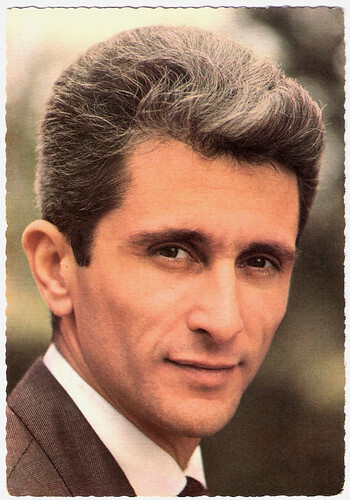
French postcard by PSG, offered by Korès, no. 1100.
The revelation of the year
Marcel Amont was born Marcel Jean-Pierre Miramon Balthazar in a working-class area in Bordeaux, France in 1929. His parents were from a small valley in Bearn, right on the border of Spain.
He started acting in the local theatre and in 1951 he moved to Paris to become a cabaret entertainer. In 1956 he had his breakthrough. That year he released his first record and he appeared as the supporting act at the concerts of Édith Piaf . The French newspapers called him ‘the revelation of the year’.
He married Tamara Vladimirovna Deinessa, a Russian dancer with whom he had two children. That same year, he also made his film debut in the romantic comedy La mariée est trop belle/Her Bridal Night (Pierre Gaspard Huit, 1956) starring Brigitte Bardot and Louis Jourdan . Later the singer could be seen in more films, including La conduite à gauche/Driving on the Left (Guy Lefranc, 1961) with Dany Robin .
His musical career was his main focus though. He appeared at Paris's most famous venue, L’Olympia as the supporting act of George Brassens and The Platters. In 1962, he performed one hundred days as the main act at another famous music hall, Bobino. There he sang several songs written by the then-unknown Claude Nougaro: 'Le balayeur du roy', 'Porte-Plume', 'Le tango des jumeaux', 'Le jazz et la java', etc.
In 1970, Amont performed at the Olympia in a real one-man show with dancers, waterfalls, giant screens, etc. It was so successful that the show was extended by two weeks, which was never seen before at the Olympia. An American producer and the BBC both made him an offer, but he declined because he was preparing a musical comedy. Eventually, Sacha Distel would broadcast for the BBC. Among Marcel Amont’s greatest hits are 'Bleu blanc blond' (1962), 'Un Mexicain' (1962), 'L'amour ça fait passer le temps' (1971) and 'C'est aujourd'hui dimanche' (1971).
In 1974 he was the host of the TV show Toutankhamont. Several times, he sang in the Gascon dialect of the Occitan language, including 'Marcel Amont canta en biarnes' and 'Marcel Amont canta los poetas gascons'. He had a relationship with the German singer/dancer Alice Kessler , one of the famous Kessler twins .
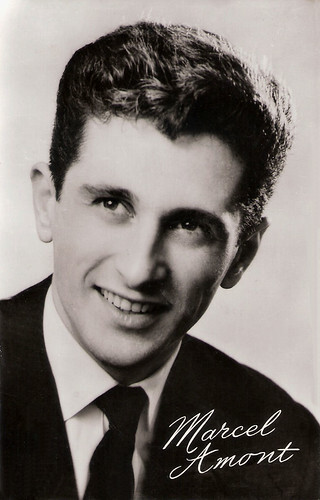
Dutch postcard by Uitg. Takken, Utrecht, no. 4546. Promotion card for the Belgian magazine Juke Box.
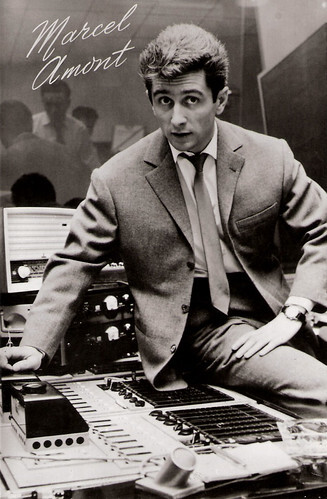
Dutch postcard by Uitg. Takken, Utrecht, no. 5292. Photo: Polydor.
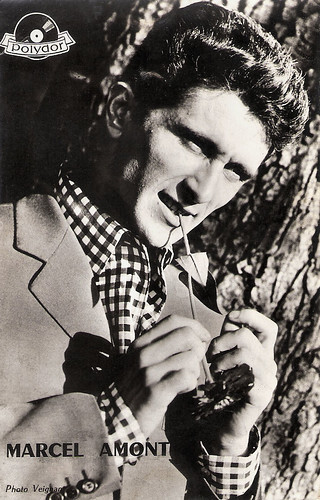
French postcard. Photo: Veignant / Polydor.
A symbol of the cruelty of the profession
From the 1980s on, Marcel Amont’s popularity declined sharply. He was no longer seen on television and the radio did no longer play his records. Wikipedia writes that “this relative neglect became a sort of symbol of the cruelty of the profession of the singer”.
Marcel took refuge in writing and published many books on music. He appeared in two more films, Les maîtres du soleil/The masters of the sun (Jean-Jacques Aublanc, 1984) and L'orsalher (Jean Fleschet, 1984), spoken in Occitan. Both films were not successful. In his final film, Avant l'oubli/Before oblivion (Augustin Burger, 2005) with Sami Bouajila, his scenes were even deleted.
During the 2000s he made a comeback through various collaborations. In 2006, 27 years after his last recordings, he returned with a new album 'Jetlag', singing duets with Agnes Jaoui, Gerard Darmon, and others. In 2008, he participated in Guillaume Aldebert Enfantillages, an album for children. He wrote his autobiography Sur le boulevard du temps qui passe (On the Boulevard of the passing time) in 2009.
Amont wrote the song 'Dans les yeux d'Alain Delon' (2010), which he sang with the young artist Emma Daumas. He also contributed to the children's album 'Les larmes de crocodile et autres fables' (The crocodile tears) composed by Daumas and his son Mathias Miramon.
Marcel Amont died on 8 March 2023 in Saint-Cloud, Hauts-de-Seine, France. He was 93. Since 1978 he was married to Marlene Laborde. They had two children.
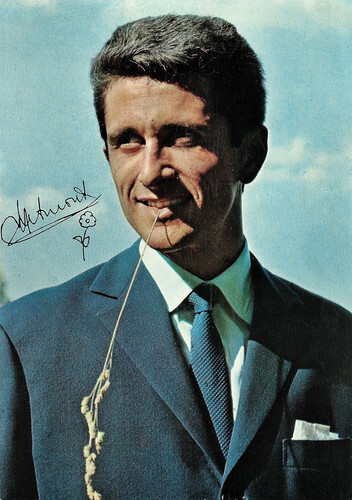
French collectors card.
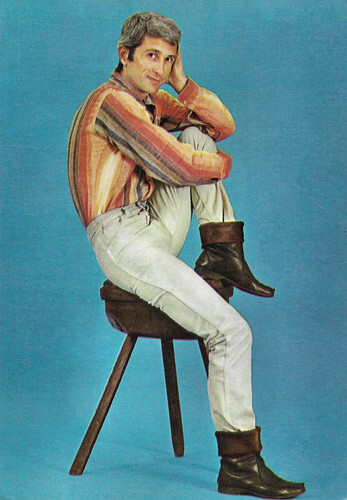
French postcard by Collection Frimousse. Photo: Disques Polydor.
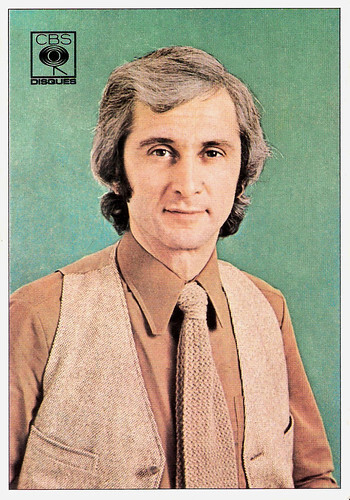
French collectors card in the Hit Collection by Figurine Panini, no. 73. Photo: CBS Disques.
Sources: (IMDb), MarcelAmont.com, Wikipedia (French) and .

French collectors card. Photo: Sam Lévin.

French postcard by EDUG, no. 198. Photo: Sam Lévin.

French postcard by PSG, offered by Korès, no. 1100.
The revelation of the year
Marcel Amont was born Marcel Jean-Pierre Miramon Balthazar in a working-class area in Bordeaux, France in 1929. His parents were from a small valley in Bearn, right on the border of Spain.
He started acting in the local theatre and in 1951 he moved to Paris to become a cabaret entertainer. In 1956 he had his breakthrough. That year he released his first record and he appeared as the supporting act at the concerts of Édith Piaf . The French newspapers called him ‘the revelation of the year’.
He married Tamara Vladimirovna Deinessa, a Russian dancer with whom he had two children. That same year, he also made his film debut in the romantic comedy La mariée est trop belle/Her Bridal Night (Pierre Gaspard Huit, 1956) starring Brigitte Bardot and Louis Jourdan . Later the singer could be seen in more films, including La conduite à gauche/Driving on the Left (Guy Lefranc, 1961) with Dany Robin .
His musical career was his main focus though. He appeared at Paris's most famous venue, L’Olympia as the supporting act of George Brassens and The Platters. In 1962, he performed one hundred days as the main act at another famous music hall, Bobino. There he sang several songs written by the then-unknown Claude Nougaro: 'Le balayeur du roy', 'Porte-Plume', 'Le tango des jumeaux', 'Le jazz et la java', etc.
In 1970, Amont performed at the Olympia in a real one-man show with dancers, waterfalls, giant screens, etc. It was so successful that the show was extended by two weeks, which was never seen before at the Olympia. An American producer and the BBC both made him an offer, but he declined because he was preparing a musical comedy. Eventually, Sacha Distel would broadcast for the BBC. Among Marcel Amont’s greatest hits are 'Bleu blanc blond' (1962), 'Un Mexicain' (1962), 'L'amour ça fait passer le temps' (1971) and 'C'est aujourd'hui dimanche' (1971).
In 1974 he was the host of the TV show Toutankhamont. Several times, he sang in the Gascon dialect of the Occitan language, including 'Marcel Amont canta en biarnes' and 'Marcel Amont canta los poetas gascons'. He had a relationship with the German singer/dancer Alice Kessler , one of the famous Kessler twins .

Dutch postcard by Uitg. Takken, Utrecht, no. 4546. Promotion card for the Belgian magazine Juke Box.

Dutch postcard by Uitg. Takken, Utrecht, no. 5292. Photo: Polydor.

French postcard. Photo: Veignant / Polydor.
A symbol of the cruelty of the profession
From the 1980s on, Marcel Amont’s popularity declined sharply. He was no longer seen on television and the radio did no longer play his records. Wikipedia writes that “this relative neglect became a sort of symbol of the cruelty of the profession of the singer”.
Marcel took refuge in writing and published many books on music. He appeared in two more films, Les maîtres du soleil/The masters of the sun (Jean-Jacques Aublanc, 1984) and L'orsalher (Jean Fleschet, 1984), spoken in Occitan. Both films were not successful. In his final film, Avant l'oubli/Before oblivion (Augustin Burger, 2005) with Sami Bouajila, his scenes were even deleted.
During the 2000s he made a comeback through various collaborations. In 2006, 27 years after his last recordings, he returned with a new album 'Jetlag', singing duets with Agnes Jaoui, Gerard Darmon, and others. In 2008, he participated in Guillaume Aldebert Enfantillages, an album for children. He wrote his autobiography Sur le boulevard du temps qui passe (On the Boulevard of the passing time) in 2009.
Amont wrote the song 'Dans les yeux d'Alain Delon' (2010), which he sang with the young artist Emma Daumas. He also contributed to the children's album 'Les larmes de crocodile et autres fables' (The crocodile tears) composed by Daumas and his son Mathias Miramon.
Marcel Amont died on 8 March 2023 in Saint-Cloud, Hauts-de-Seine, France. He was 93. Since 1978 he was married to Marlene Laborde. They had two children.

French collectors card.

French postcard by Collection Frimousse. Photo: Disques Polydor.

French collectors card in the Hit Collection by Figurine Panini, no. 73. Photo: CBS Disques.
Sources: (IMDb), MarcelAmont.com, Wikipedia (French) and .
Published on March 09, 2023 22:00
March 8, 2023
L'homme aux trois masques (1920)
L'Homme aux trois masques (Emille Keppens, 1920) was a French serial in 12 episodes by the company Eclair. A young and dynamic engineer, Julien Marsac (André Marnay), is innocently judged for murder. He escapes from prison and his only goal is to take revenge. The serial was released in Spain as 'El hombre de la tres caras' and Edicion Union Eclair made a series of 42 collectors cards or mini cards of the serial for Cholate Pi in Barcelona to be a gift in their chocolate boxes.
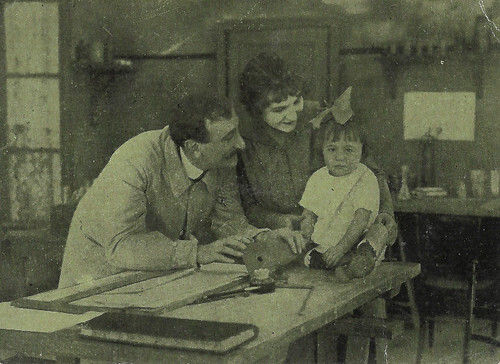
Spanish collector's card (minicard) for Chocolate Pi, Barcelona, by Edicion Union Eclair, card no. 2 of 42. Printed by Plauber, Barcelona. Card for L'Homme aux trois masques (Emille Keppens, 1920), released in Spain as 'El hombre de la tres caras'.
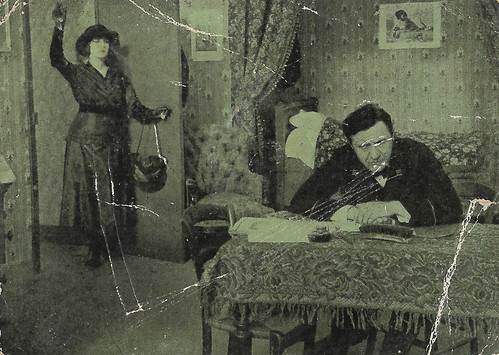
Spanish collector's card (minicard) for Chocolate Pi, Barcelona, by Edicion Union Eclair, card no. 4 of 42. Printed by Plauber, Barcelona. Card for L'Homme aux trois masques (Emille Keppens, 1920), released in Spain as 'El hombre de la tres caras'.
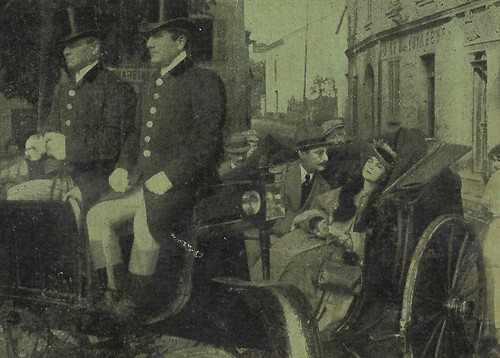
Spanish collector's card (minicard) for Chocolate Pi, Barcelona, by Edicion Union Eclair, card no. 5 of 42. Printed by Plauber, Barcelona. Card for L'Homme aux trois masques (Emille Keppens, 1920), released in Spain as 'El hombre de la tres caras'.
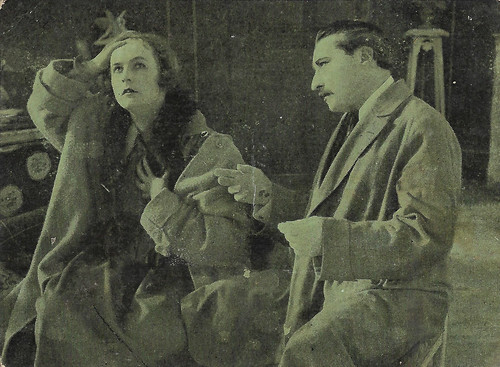
Spanish collector's card (minicard) for Chocolate Pi, Barcelona, by Edicion Union Eclair, card no. 6 of 42. Printed by Plauber, Barcelona. Card for L'Homme aux trois masques (Emille Keppens, 1920), released in Spain as 'El hombre de la tres caras'.
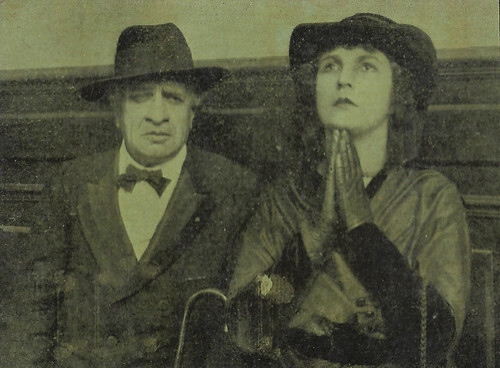
Spanish collector's card (minicard) for Chocolate Pi, Barcelona, by Edicion Union Eclair, card no. 7 of 42. Printed by Plauber, Barcelona. Card for L'Homme aux trois masques (Emille Keppens, 1920), released in Spain as 'El hombre de la tres caras'.
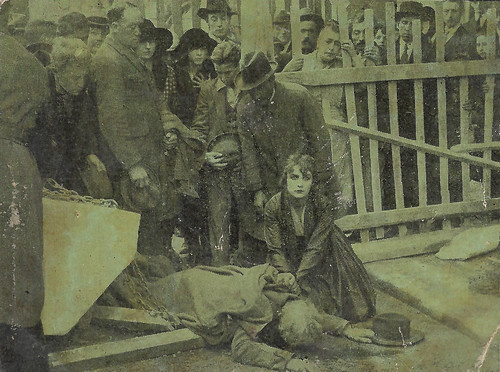
Spanish collector's card (minicard) for Chocolate Pi, Barcelona, by Edicion Union Eclair, card no. 8 of 42. Printed by Plauber, Barcelona. Card for L'Homme aux trois masques (Emille Keppens, 1920), released in Spain as 'El hombre de la tres caras'.
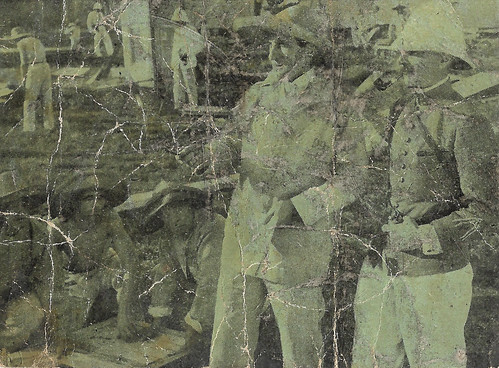
Spanish collector's card (minicard) for Chocolate Pi, Barcelona, by Edicion Union Eclair, card no. 9 of 42. Printed by Plauber, Barcelona. Card for L'Homme aux trois masques (Emille Keppens, 1920), released in Spain as 'El hombre de la tres caras'.
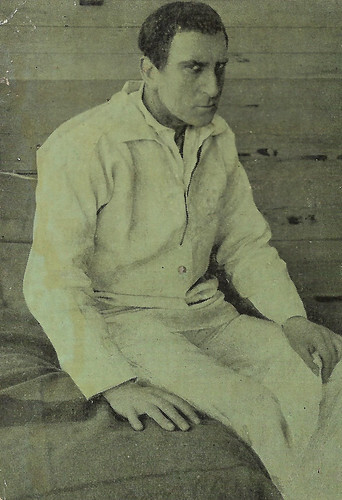
Spanish collector's card (minicard) for Chocolate Pi, Barcelona, by Edicion Union Eclair, card no. 10 of 42. Printed by Plauber, Barcelona. Card for L'Homme aux trois masques (Emille Keppens, 1920), released in Spain as 'El hombre de la tres caras'.
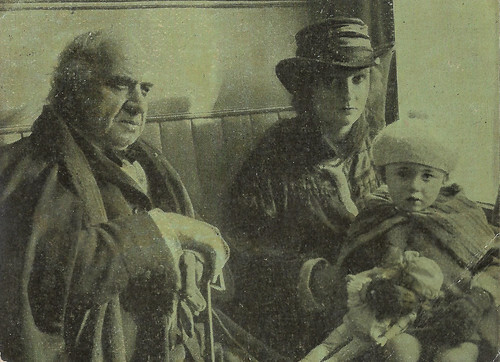
Spanish collector's card (minicard) for Chocolate Pi, Barcelona, by Edicion Union Eclair, card no. 11 of 42. Printed by Plauber, Barcelona. Card for L'Homme aux trois masques (Emille Keppens, 1920), released in Spain as 'El hombre de la tres caras'.
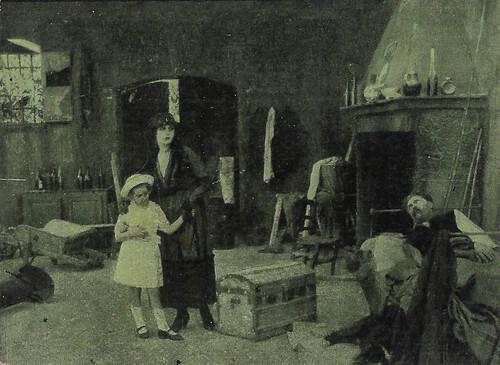
Spanish collector's card (minicard) for Chocolate Pi, Barcelona, by Edicion Union Eclair, card no. 12 of 42. Printed by Plauber, Barcelona. Card for L'Homme aux trois masques (Emille Keppens, 1920), released in Spain as 'El hombre de la tres caras'.
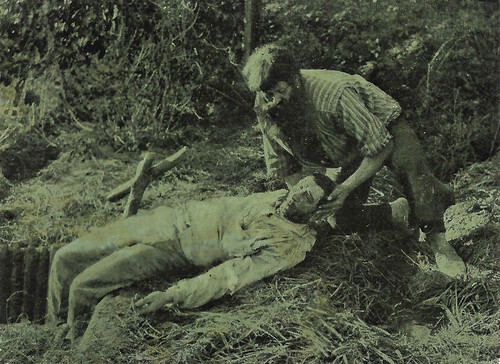
Spanish collector's card (minicard) for Chocolate Pi, Barcelona, by Edicion Union Eclair, card no. 13 of 42. Printed by Plauber, Barcelona. Card for L'Homme aux trois masques (Emille Keppens, 1920), released in Spain as 'El hombre de la tres caras'.
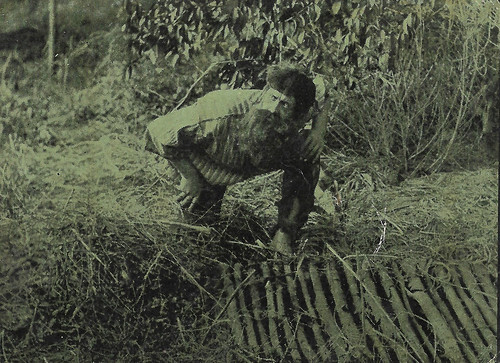
Spanish collector's card (minicard) for Chocolate Pi, Barcelona, by Edicion Union Eclair, card no. 14 of 42. Printed by Plauber, Barcelona. Card for L'Homme aux trois masques (Emille Keppens, 1920), released in Spain as 'El hombre de la tres caras'.
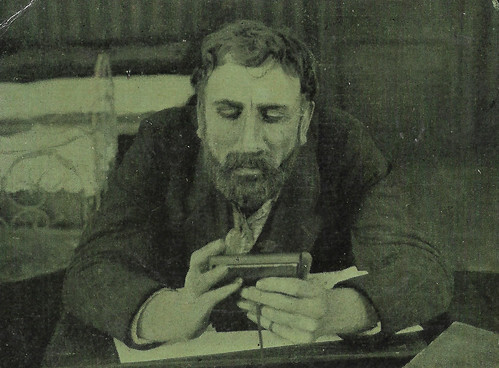
Spanish collector's card (minicard) for Chocolate Pi, Barcelona, by Edicion Union Eclair, card no. 15 of 42. Printed by Plauber, Barcelona. Card for L'Homme aux trois masques (Emille Keppens, 1920), released in Spain as 'El hombre de la tres caras'.
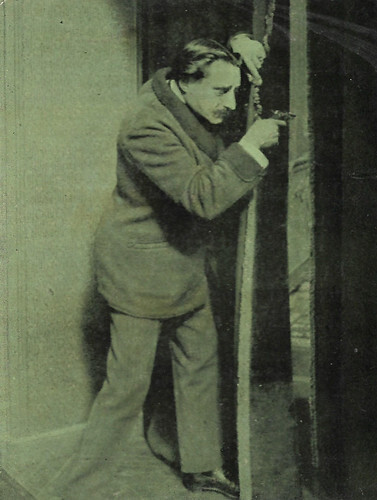
Spanish collector's card (minicard) for Chocolate Pi, Barcelona, by Edicion Union Eclair, card no. 16 of 42. Printed by Plauber, Barcelona. Card for L'Homme aux trois masques (Emille Keppens, 1920), released in Spain as 'El hombre de la tres caras'.
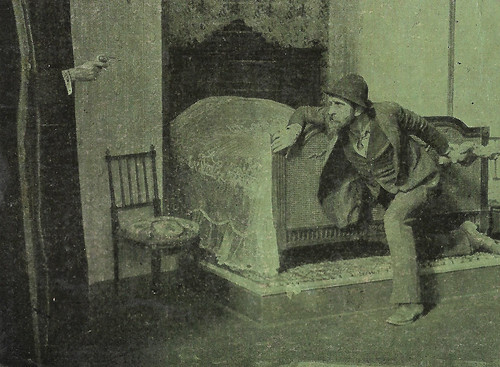
Spanish collector's card (minicard) for Chocolate Pi, Barcelona, by Edicion Union Eclair, card no. 17 of 42. Printed by Plauber, Barcelona. Card for L'Homme aux trois masques (Emille Keppens, 1920), released in Spain as 'El hombre de la tres caras'.
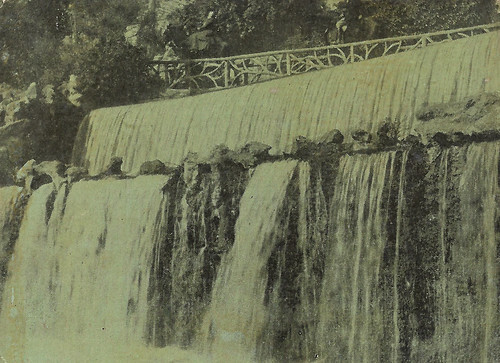
Spanish collector's card (minicard) for Chocolate Pi, Barcelona, by Edicion Union Eclair, card no. 18 of 42. Printed by Plauber, Barcelona. Card for L'Homme aux trois masques (Emille Keppens, 1920), released in Spain as 'El hombre de la tres caras'.
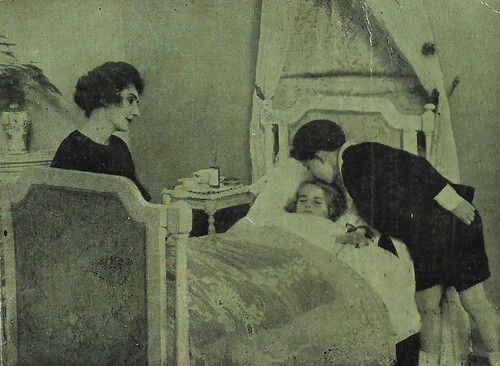
Spanish collector's card (minicard) for Chocolate Pi, Barcelona, by Edicion Union Eclair, card no. 19 of 42. Printed by Plauber, Barcelona. Card for L'Homme aux trois masques (Emille Keppens, 1920), released in Spain as 'El hombre de la tres caras'.
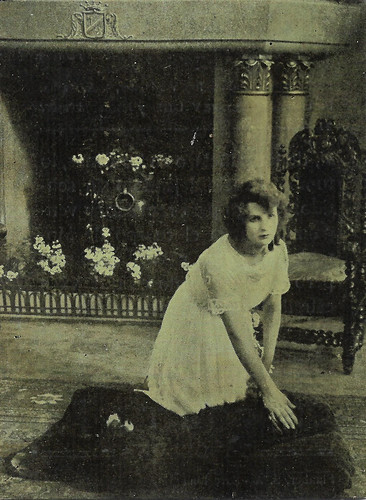
Spanish collector's card (minicard) for Chocolate Pi, Barcelona, by Edicion Union Eclair, card no. 20 of 42. Printed by Plauber, Barcelona. Card for L'Homme aux trois masques (Emille Keppens, 1920), released in Spain as 'El hombre de la tres caras'.
A poor inventor in the clutches of a banker
L'Homme aux trois masques (Emille Keppens, 1920) was based on a book by Arthur Bernède, who also scripted the film. Some sources indicate René Navarre as co-director. The cinematographer was Marcel Eywinger.
Engineer Julien Marsac (André Marnay) leads a happy life with his wife Pascaline ( Elmire Vautier ) and their little daughter Huguette (Renée Mercorelli). He is however a poor inventor, in the clutches of the banker Barodin and his nephew Morant (Charles Casella). In a fight about money, Morant strangles his uncle and buys the silence of the employee Fergus (Cauvin-Fassal).
Marsac enters and thinks the banker is asleep but is immediately caught by the police who think he is the assassin. He protests that he is innocent but Morant and Fergus point to him as the culprit. While all appearances are against the poor engineer, his wife Pascaline still believes in his innocence. When the court gives him the death penalty, poor Pascaline faints. M. Morizot (Armand Dutertre), Julian's former teacher and friend, is also convinced of Julian's innocence, protects Pascaline and promises to do all he can to reveal the truth. When his execution is near, his penalty is changed to a lifetime in prison, and he is transported to Guyana.
M. Morizot is keen on unmasking Morant, but when he one day leaves Pascaline's house, he is killed by a big rock. Pascaline is now all on her own. When Julian hears about this, he has no doubt Morant is involved, and fearing for his wife and daughter, he evades. With difficulty, he manages to get back to Europe. Meanwhile, Fergus, Morant's accomplice, is dying and repenting his act he writes Pasqualina a letter. She meets him and he gives her a declaration accusing Morant of the murder.
Morant also hears of this and steals the document from the woman. A struggle follows after which Morant throws Pascaline and her daughter Huguette into the river. Yet, Fergus' loyal dog saves the girl. Morant intends to marry Ms. Sallenave, a rich heiress. Julien visits him and asks about his wife and daughter, and when the other denies seeing them, a new fight follows. Suddenly, the whole abandoned house where they are collapses, but the two enemies survive. Later on, Morant is still keen on Huguette's disappearance. The girl has been picked up by an old army officer widower and mother of little Robert Grisolles (Ellen Hélia).
Years pass. The now adults Robert (Rex Stocken) and Huguette fall in love and are united forever, but the vengeful Morant keeps having sinister intentions towards Huguette. Yet, Santa Fiore is keen on financially ruining Morant. A new opportunity for Morant is offered to avenge himself on Huguette, but again Santa Fiore alias Julien blocks his plans. Julien finally discovers his daughter and hides her at a farm. Robert gets an anonymous letter from Morant that his wife is hiding with a lover. Seeing Muguette embracing another man, and not knowing he is her father, he shoots him. She shouts he is her father, but he doesn't believe her. Tenderly, Huguette takes care of her father.
Soon Julien is back in shape and set on revenge against Morant, the cause of all this misery, by closing down Morant's banking network. On top of this, Morant's daughter Suzanne (Gina Manès) is killed by a fall in a ravine. In addition to his financial downfall, this blow makes Morant realize his hour of confession and pay-up for his crimes has come. Huguette, whose husband hasn't believed her innocence, has withdrawn into a convent, but Santa Fiore discovers the place and visits it with the two children of Huguette, and a reunion is realised with her husband, who has realized the slander of Morant and asks her for forgiveness.
Once all are reunited, Santa Fiore thinks only of revenge and orders his agent to ruin the bank of Morant. The bank is soon assaulted by Morant's shareholders who demand guarantees, which Morant cannot give. Before the police, Santa Fiore, accompanied by his family, declares pointing at Morant: This is the real murderer of banker Barodin. To the general stupefaction, Morant admits. Before he can be arrested by the police, the author of the assassination stabs himself. Engineer Marsac is rehabilitated and freed from so much bitterness. For him and his family, a new era of peace and happiness starts.
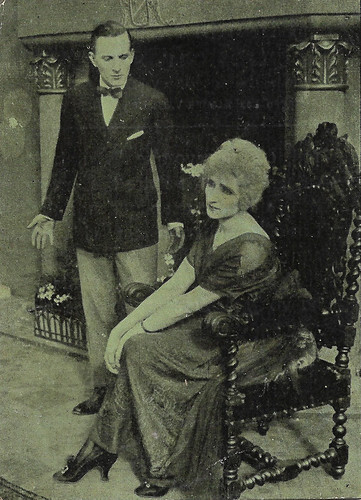
Spanish collector's card (minicard) for Chocolate Pi, Barcelona, by Edicion Union Eclair, card no. 21 of 42. Printed by Plauber, Barcelona. Card for L'Homme aux trois masques (Emille Keppens, 1920), released in Spain as 'El hombre de la tres caras'.
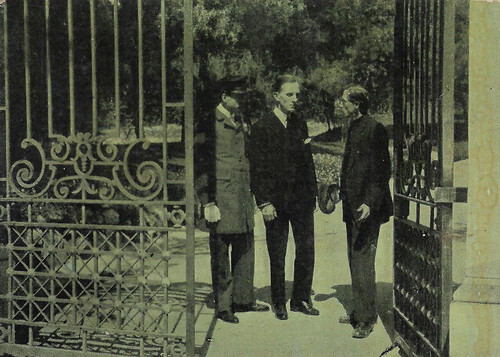
Spanish collector's card (minicard) for Chocolate Pi, Barcelona, by Edicion Union Eclair, card no. 22 of 42. Printed by Plauber, Barcelona. Card for L'Homme aux trois masques (Emille Keppens, 1920), released in Spain as 'El hombre de la tres caras'.
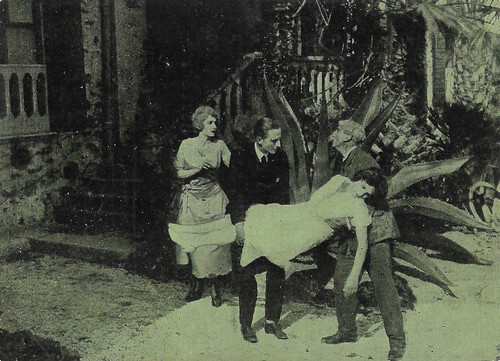
Spanish collector's card (minicard) for Chocolate Pi, Barcelona, by Edicion Union Eclair, card no. 23 of 42. Printed by Plauber, Barcelona. Card for L'Homme aux trois masques (Emille Keppens, 1920), released in Spain as 'El hombre de la tres caras'.
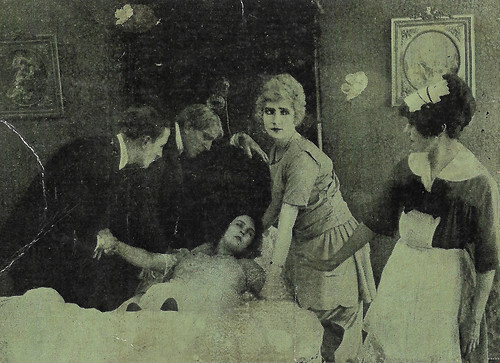
Spanish collector's card (minicard) for Chocolate Pi, Barcelona, by Edicion Union Eclair, card no. 24 of 42. Printed by Plauber, Barcelona. Card for L'Homme aux trois masques (Emille Keppens, 1920), released in Spain as 'El hombre de la tres caras'.
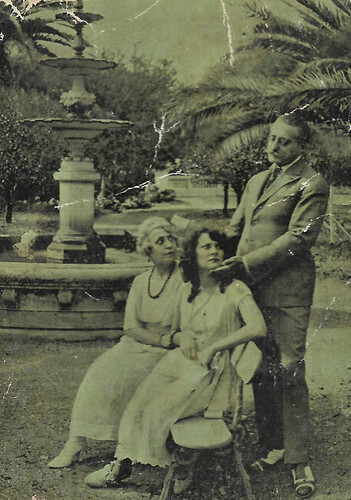
Spanish collector's card (minicard) for Chocolate Pi, Barcelona, by Edicion Union Eclair, card no. 25 of 42. Printed by Plauber, Barcelona. Card for L'Homme aux trois masques (Emille Keppens, 1920), released in Spain as 'El hombre de la tres caras'.
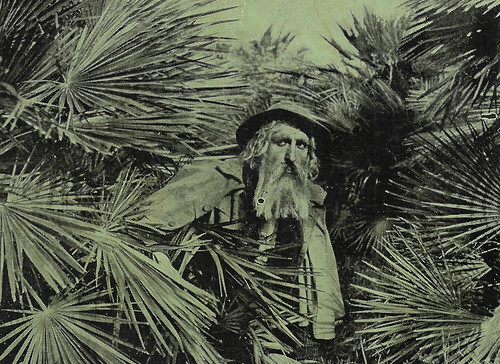
Spanish collector's card (minicard) for Chocolate Pi, Barcelona, by Edicion Union Eclair, card no. 26 of 42. Printed by Plauber, Barcelona. Card for L'Homme aux trois masques (Emille Keppens, 1920), released in Spain as 'El hombre de la tres caras'.
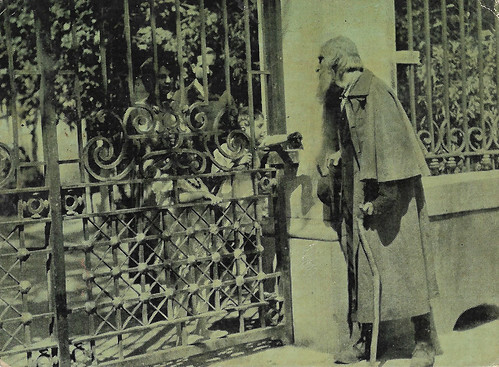
Spanish collector's card (minicard) for Chocolate Pi, Barcelona, by Edicion Union Eclair, card no. 27 of 42. Printed by Plauber, Barcelona. Card for L'Homme aux trois masques (Emille Keppens, 1920), released in Spain as 'El hombre de la tres caras'.
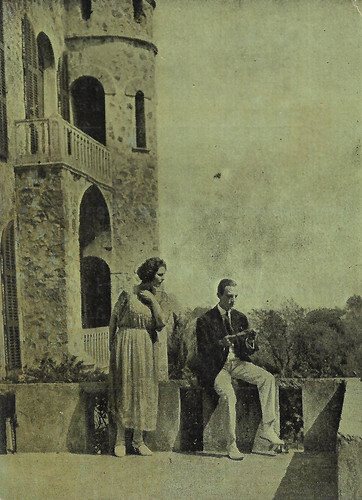
Spanish collector's card (minicard) for Chocolate Pi, Barcelona, by Edicion Union Eclair, card no. 28 of 42. Printed by Plauber, Barcelona. Card for L'Homme aux trois masques (Emille Keppens, 1920), released in Spain as 'El hombre de la tres caras'.
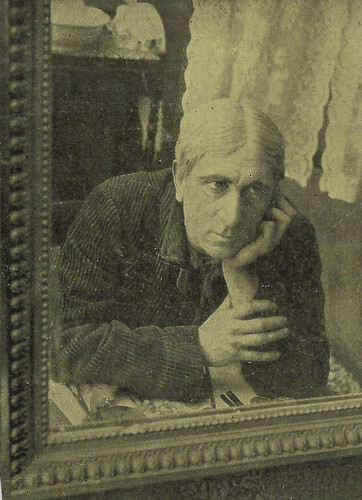
Spanish collector's card (minicard) for Chocolate Pi, Barcelona, by Edicion Union Eclair, card no. 29 of 42. Printed by Plauber, Barcelona. Card for L'Homme aux trois masques (Emille Keppens, 1920), released in Spain as 'El hombre de la tres caras'.
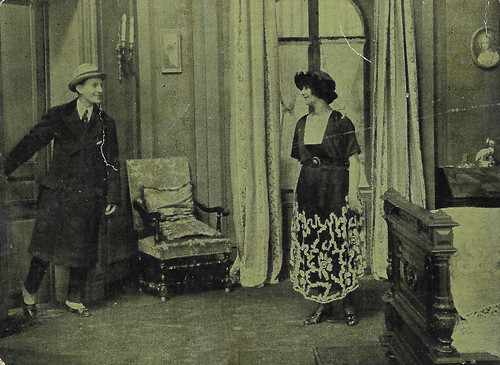
Spanish collector's card (minicard) for Chocolate Pi, Barcelona, by Edicion Union Eclair, card no. 30 of 42. Printed by Plauber, Barcelona. Card for L'Homme aux trois masques (Emille Keppens, 1920), released in Spain as 'El hombre de la tres caras'.
[image error]
Spanish collector's card (minicard) for Chocolate Pi, Barcelona, by Edicion Union Eclair, card no. 31 of 42. Printed by Plauber, Barcelona. Card for L'Homme aux trois masques (Emille Keppens, 1920), released in Spain as 'El hombre de la tres caras'.
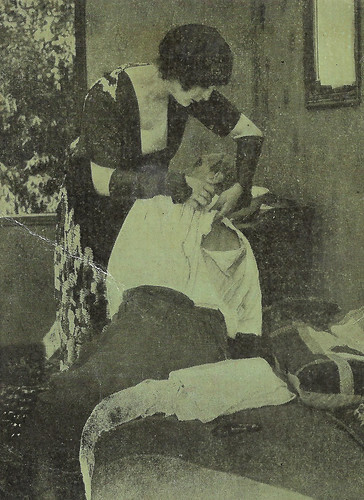
Spanish collector's card (minicard) for Chocolate Pi, Barcelona, by Edicion Union Eclair, card no. 32 of 42. Printed by Plauber, Barcelona. Card for L'Homme aux trois masques (Emille Keppens, 1920), released in Spain as 'El hombre de la tres caras'.
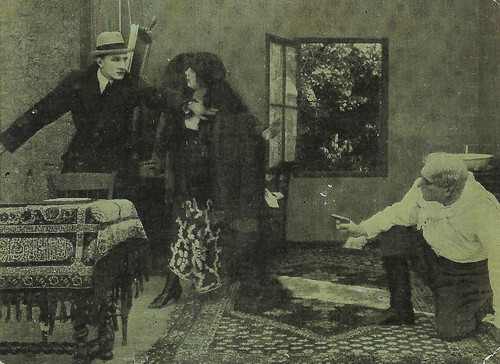
Spanish collector's card (minicard) for Chocolate Pi, Barcelona, by Edicion Union Eclair, card no. 34 of 42. Printed by Plauber, Barcelona. Card for L'Homme aux trois masques (Emille Keppens, 1920), released in Spain as 'El hombre de la tres caras'.
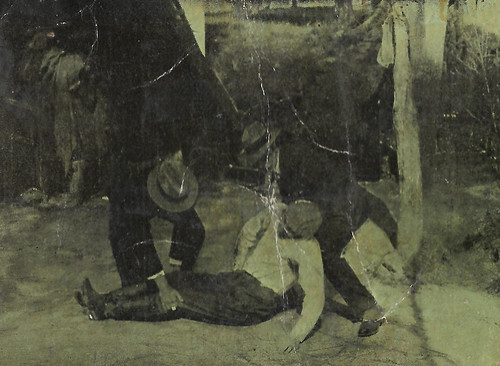
Spanish collector's card (minicard) for Chocolate Pi, Barcelona, by Edicion Union Eclair, card no. 35 of 42. Printed by Plauber, Barcelona. Card for L'Homme aux trois masques (Emille Keppens, 1920), released in Spain as 'El hombre de la tres caras'.
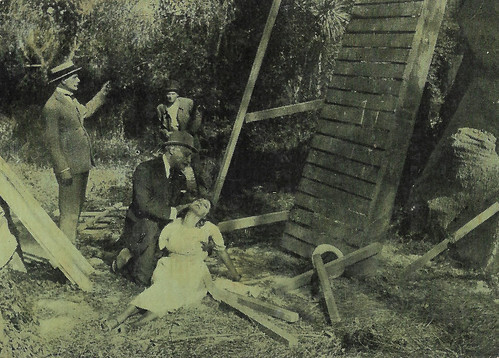
Spanish collector's card (minicard) for Chocolate Pi, Barcelona, by Edicion Union Eclair, card no. 36 of 42. Printed by Plauber, Barcelona. Card for L'Homme aux trois masques (Emille Keppens, 1920), released in Spain as 'El hombre de la tres caras'.
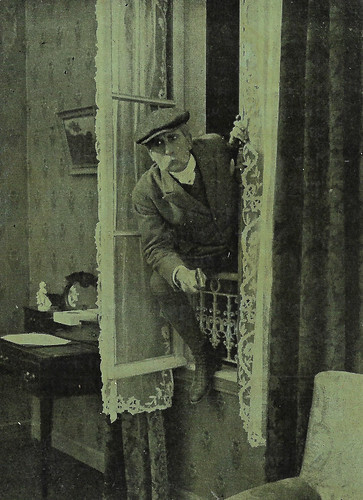
Spanish collector's card (minicard) for Chocolate Pi, Barcelona, by Edicion Union Eclair, card no. 37 of 42. Printed by Plauber, Barcelona. Card for L'Homme aux trois masques (Emille Keppens, 1920), released in Spain as 'El hombre de la tres caras'.
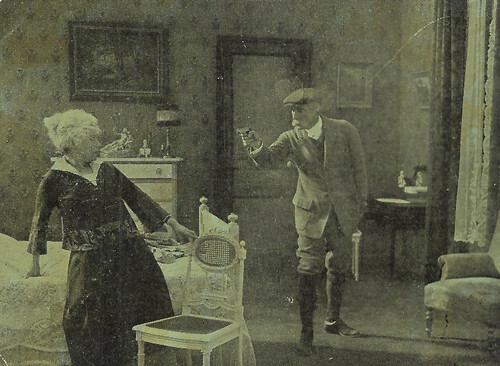
Spanish collector's card (minicard) for Chocolate Pi, Barcelona, by Edicion Union Eclair, card no. 38 of 42. Printed by Plauber, Barcelona. Card for L'Homme aux trois masques (Emille Keppens, 1920), released in Spain as 'El hombre de la tres caras'.
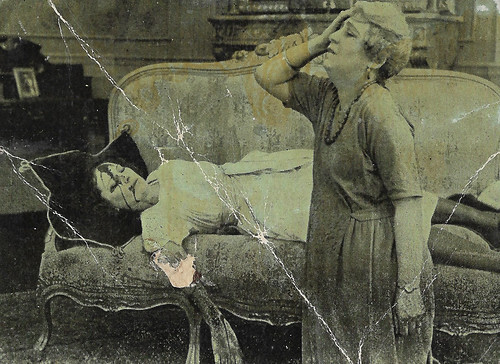
Spanish collector's card (minicard) for Chocolate Pi, Barcelona, by Edicion Union Eclair, card no. 39 of 42. Printed by Plauber, Barcelona. Card for L'Homme aux trois masques (Emille Keppens, 1920), released in Spain as 'El hombre de la tres caras'.
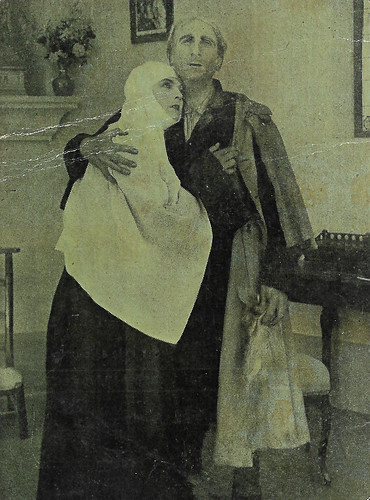
Spanish collector's card (minicard) for Chocolate Pi, Barcelona, by Edicion Union Eclair, card no. 40 of 42. Printed by Plauber, Barcelona. Card for L'Homme aux trois masques (Emille Keppens, 1920), released in Spain as 'El hombre de la tres caras'.
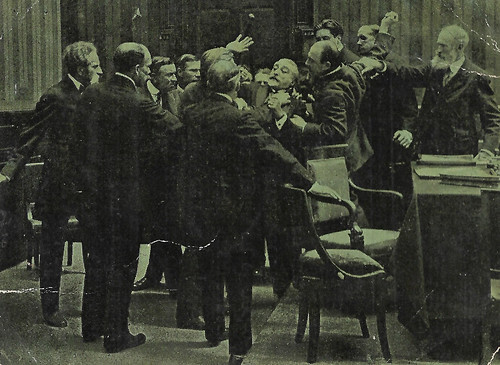
Spanish collector's card (minicard) for Chocolate Pi, Barcelona, by Edicion Union Eclair, card no. 41 of 42. Printed by Plauber, Barcelona. Card for L'Homme aux trois masques (Emille Keppens, 1920), released in Spain as 'El hombre de la tres caras'.
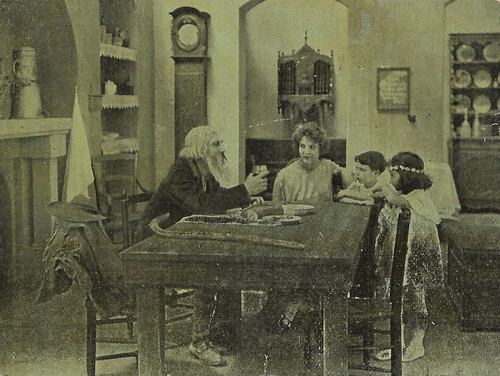
Spanish collector's card (minicard) for Chocolate Pi, Barcelona, by Edicion Union Eclair, card no. 42 of 42. Printed by Plauber, Barcelona. Card for L'Homme aux trois masques (Emille Keppens, 1920), released in Spain as 'El hombre de la tres caras'.
Sources: plot subtracted from the backs of the cards. Additional source: Cinema.encyclopedie.films.bifi.

Spanish collector's card (minicard) for Chocolate Pi, Barcelona, by Edicion Union Eclair, card no. 2 of 42. Printed by Plauber, Barcelona. Card for L'Homme aux trois masques (Emille Keppens, 1920), released in Spain as 'El hombre de la tres caras'.

Spanish collector's card (minicard) for Chocolate Pi, Barcelona, by Edicion Union Eclair, card no. 4 of 42. Printed by Plauber, Barcelona. Card for L'Homme aux trois masques (Emille Keppens, 1920), released in Spain as 'El hombre de la tres caras'.

Spanish collector's card (minicard) for Chocolate Pi, Barcelona, by Edicion Union Eclair, card no. 5 of 42. Printed by Plauber, Barcelona. Card for L'Homme aux trois masques (Emille Keppens, 1920), released in Spain as 'El hombre de la tres caras'.

Spanish collector's card (minicard) for Chocolate Pi, Barcelona, by Edicion Union Eclair, card no. 6 of 42. Printed by Plauber, Barcelona. Card for L'Homme aux trois masques (Emille Keppens, 1920), released in Spain as 'El hombre de la tres caras'.

Spanish collector's card (minicard) for Chocolate Pi, Barcelona, by Edicion Union Eclair, card no. 7 of 42. Printed by Plauber, Barcelona. Card for L'Homme aux trois masques (Emille Keppens, 1920), released in Spain as 'El hombre de la tres caras'.

Spanish collector's card (minicard) for Chocolate Pi, Barcelona, by Edicion Union Eclair, card no. 8 of 42. Printed by Plauber, Barcelona. Card for L'Homme aux trois masques (Emille Keppens, 1920), released in Spain as 'El hombre de la tres caras'.

Spanish collector's card (minicard) for Chocolate Pi, Barcelona, by Edicion Union Eclair, card no. 9 of 42. Printed by Plauber, Barcelona. Card for L'Homme aux trois masques (Emille Keppens, 1920), released in Spain as 'El hombre de la tres caras'.

Spanish collector's card (minicard) for Chocolate Pi, Barcelona, by Edicion Union Eclair, card no. 10 of 42. Printed by Plauber, Barcelona. Card for L'Homme aux trois masques (Emille Keppens, 1920), released in Spain as 'El hombre de la tres caras'.

Spanish collector's card (minicard) for Chocolate Pi, Barcelona, by Edicion Union Eclair, card no. 11 of 42. Printed by Plauber, Barcelona. Card for L'Homme aux trois masques (Emille Keppens, 1920), released in Spain as 'El hombre de la tres caras'.

Spanish collector's card (minicard) for Chocolate Pi, Barcelona, by Edicion Union Eclair, card no. 12 of 42. Printed by Plauber, Barcelona. Card for L'Homme aux trois masques (Emille Keppens, 1920), released in Spain as 'El hombre de la tres caras'.

Spanish collector's card (minicard) for Chocolate Pi, Barcelona, by Edicion Union Eclair, card no. 13 of 42. Printed by Plauber, Barcelona. Card for L'Homme aux trois masques (Emille Keppens, 1920), released in Spain as 'El hombre de la tres caras'.

Spanish collector's card (minicard) for Chocolate Pi, Barcelona, by Edicion Union Eclair, card no. 14 of 42. Printed by Plauber, Barcelona. Card for L'Homme aux trois masques (Emille Keppens, 1920), released in Spain as 'El hombre de la tres caras'.

Spanish collector's card (minicard) for Chocolate Pi, Barcelona, by Edicion Union Eclair, card no. 15 of 42. Printed by Plauber, Barcelona. Card for L'Homme aux trois masques (Emille Keppens, 1920), released in Spain as 'El hombre de la tres caras'.

Spanish collector's card (minicard) for Chocolate Pi, Barcelona, by Edicion Union Eclair, card no. 16 of 42. Printed by Plauber, Barcelona. Card for L'Homme aux trois masques (Emille Keppens, 1920), released in Spain as 'El hombre de la tres caras'.

Spanish collector's card (minicard) for Chocolate Pi, Barcelona, by Edicion Union Eclair, card no. 17 of 42. Printed by Plauber, Barcelona. Card for L'Homme aux trois masques (Emille Keppens, 1920), released in Spain as 'El hombre de la tres caras'.

Spanish collector's card (minicard) for Chocolate Pi, Barcelona, by Edicion Union Eclair, card no. 18 of 42. Printed by Plauber, Barcelona. Card for L'Homme aux trois masques (Emille Keppens, 1920), released in Spain as 'El hombre de la tres caras'.

Spanish collector's card (minicard) for Chocolate Pi, Barcelona, by Edicion Union Eclair, card no. 19 of 42. Printed by Plauber, Barcelona. Card for L'Homme aux trois masques (Emille Keppens, 1920), released in Spain as 'El hombre de la tres caras'.

Spanish collector's card (minicard) for Chocolate Pi, Barcelona, by Edicion Union Eclair, card no. 20 of 42. Printed by Plauber, Barcelona. Card for L'Homme aux trois masques (Emille Keppens, 1920), released in Spain as 'El hombre de la tres caras'.
A poor inventor in the clutches of a banker
L'Homme aux trois masques (Emille Keppens, 1920) was based on a book by Arthur Bernède, who also scripted the film. Some sources indicate René Navarre as co-director. The cinematographer was Marcel Eywinger.
Engineer Julien Marsac (André Marnay) leads a happy life with his wife Pascaline ( Elmire Vautier ) and their little daughter Huguette (Renée Mercorelli). He is however a poor inventor, in the clutches of the banker Barodin and his nephew Morant (Charles Casella). In a fight about money, Morant strangles his uncle and buys the silence of the employee Fergus (Cauvin-Fassal).
Marsac enters and thinks the banker is asleep but is immediately caught by the police who think he is the assassin. He protests that he is innocent but Morant and Fergus point to him as the culprit. While all appearances are against the poor engineer, his wife Pascaline still believes in his innocence. When the court gives him the death penalty, poor Pascaline faints. M. Morizot (Armand Dutertre), Julian's former teacher and friend, is also convinced of Julian's innocence, protects Pascaline and promises to do all he can to reveal the truth. When his execution is near, his penalty is changed to a lifetime in prison, and he is transported to Guyana.
M. Morizot is keen on unmasking Morant, but when he one day leaves Pascaline's house, he is killed by a big rock. Pascaline is now all on her own. When Julian hears about this, he has no doubt Morant is involved, and fearing for his wife and daughter, he evades. With difficulty, he manages to get back to Europe. Meanwhile, Fergus, Morant's accomplice, is dying and repenting his act he writes Pasqualina a letter. She meets him and he gives her a declaration accusing Morant of the murder.
Morant also hears of this and steals the document from the woman. A struggle follows after which Morant throws Pascaline and her daughter Huguette into the river. Yet, Fergus' loyal dog saves the girl. Morant intends to marry Ms. Sallenave, a rich heiress. Julien visits him and asks about his wife and daughter, and when the other denies seeing them, a new fight follows. Suddenly, the whole abandoned house where they are collapses, but the two enemies survive. Later on, Morant is still keen on Huguette's disappearance. The girl has been picked up by an old army officer widower and mother of little Robert Grisolles (Ellen Hélia).
Years pass. The now adults Robert (Rex Stocken) and Huguette fall in love and are united forever, but the vengeful Morant keeps having sinister intentions towards Huguette. Yet, Santa Fiore is keen on financially ruining Morant. A new opportunity for Morant is offered to avenge himself on Huguette, but again Santa Fiore alias Julien blocks his plans. Julien finally discovers his daughter and hides her at a farm. Robert gets an anonymous letter from Morant that his wife is hiding with a lover. Seeing Muguette embracing another man, and not knowing he is her father, he shoots him. She shouts he is her father, but he doesn't believe her. Tenderly, Huguette takes care of her father.
Soon Julien is back in shape and set on revenge against Morant, the cause of all this misery, by closing down Morant's banking network. On top of this, Morant's daughter Suzanne (Gina Manès) is killed by a fall in a ravine. In addition to his financial downfall, this blow makes Morant realize his hour of confession and pay-up for his crimes has come. Huguette, whose husband hasn't believed her innocence, has withdrawn into a convent, but Santa Fiore discovers the place and visits it with the two children of Huguette, and a reunion is realised with her husband, who has realized the slander of Morant and asks her for forgiveness.
Once all are reunited, Santa Fiore thinks only of revenge and orders his agent to ruin the bank of Morant. The bank is soon assaulted by Morant's shareholders who demand guarantees, which Morant cannot give. Before the police, Santa Fiore, accompanied by his family, declares pointing at Morant: This is the real murderer of banker Barodin. To the general stupefaction, Morant admits. Before he can be arrested by the police, the author of the assassination stabs himself. Engineer Marsac is rehabilitated and freed from so much bitterness. For him and his family, a new era of peace and happiness starts.

Spanish collector's card (minicard) for Chocolate Pi, Barcelona, by Edicion Union Eclair, card no. 21 of 42. Printed by Plauber, Barcelona. Card for L'Homme aux trois masques (Emille Keppens, 1920), released in Spain as 'El hombre de la tres caras'.

Spanish collector's card (minicard) for Chocolate Pi, Barcelona, by Edicion Union Eclair, card no. 22 of 42. Printed by Plauber, Barcelona. Card for L'Homme aux trois masques (Emille Keppens, 1920), released in Spain as 'El hombre de la tres caras'.

Spanish collector's card (minicard) for Chocolate Pi, Barcelona, by Edicion Union Eclair, card no. 23 of 42. Printed by Plauber, Barcelona. Card for L'Homme aux trois masques (Emille Keppens, 1920), released in Spain as 'El hombre de la tres caras'.

Spanish collector's card (minicard) for Chocolate Pi, Barcelona, by Edicion Union Eclair, card no. 24 of 42. Printed by Plauber, Barcelona. Card for L'Homme aux trois masques (Emille Keppens, 1920), released in Spain as 'El hombre de la tres caras'.

Spanish collector's card (minicard) for Chocolate Pi, Barcelona, by Edicion Union Eclair, card no. 25 of 42. Printed by Plauber, Barcelona. Card for L'Homme aux trois masques (Emille Keppens, 1920), released in Spain as 'El hombre de la tres caras'.

Spanish collector's card (minicard) for Chocolate Pi, Barcelona, by Edicion Union Eclair, card no. 26 of 42. Printed by Plauber, Barcelona. Card for L'Homme aux trois masques (Emille Keppens, 1920), released in Spain as 'El hombre de la tres caras'.

Spanish collector's card (minicard) for Chocolate Pi, Barcelona, by Edicion Union Eclair, card no. 27 of 42. Printed by Plauber, Barcelona. Card for L'Homme aux trois masques (Emille Keppens, 1920), released in Spain as 'El hombre de la tres caras'.

Spanish collector's card (minicard) for Chocolate Pi, Barcelona, by Edicion Union Eclair, card no. 28 of 42. Printed by Plauber, Barcelona. Card for L'Homme aux trois masques (Emille Keppens, 1920), released in Spain as 'El hombre de la tres caras'.

Spanish collector's card (minicard) for Chocolate Pi, Barcelona, by Edicion Union Eclair, card no. 29 of 42. Printed by Plauber, Barcelona. Card for L'Homme aux trois masques (Emille Keppens, 1920), released in Spain as 'El hombre de la tres caras'.

Spanish collector's card (minicard) for Chocolate Pi, Barcelona, by Edicion Union Eclair, card no. 30 of 42. Printed by Plauber, Barcelona. Card for L'Homme aux trois masques (Emille Keppens, 1920), released in Spain as 'El hombre de la tres caras'.
[image error]
Spanish collector's card (minicard) for Chocolate Pi, Barcelona, by Edicion Union Eclair, card no. 31 of 42. Printed by Plauber, Barcelona. Card for L'Homme aux trois masques (Emille Keppens, 1920), released in Spain as 'El hombre de la tres caras'.

Spanish collector's card (minicard) for Chocolate Pi, Barcelona, by Edicion Union Eclair, card no. 32 of 42. Printed by Plauber, Barcelona. Card for L'Homme aux trois masques (Emille Keppens, 1920), released in Spain as 'El hombre de la tres caras'.

Spanish collector's card (minicard) for Chocolate Pi, Barcelona, by Edicion Union Eclair, card no. 34 of 42. Printed by Plauber, Barcelona. Card for L'Homme aux trois masques (Emille Keppens, 1920), released in Spain as 'El hombre de la tres caras'.

Spanish collector's card (minicard) for Chocolate Pi, Barcelona, by Edicion Union Eclair, card no. 35 of 42. Printed by Plauber, Barcelona. Card for L'Homme aux trois masques (Emille Keppens, 1920), released in Spain as 'El hombre de la tres caras'.

Spanish collector's card (minicard) for Chocolate Pi, Barcelona, by Edicion Union Eclair, card no. 36 of 42. Printed by Plauber, Barcelona. Card for L'Homme aux trois masques (Emille Keppens, 1920), released in Spain as 'El hombre de la tres caras'.

Spanish collector's card (minicard) for Chocolate Pi, Barcelona, by Edicion Union Eclair, card no. 37 of 42. Printed by Plauber, Barcelona. Card for L'Homme aux trois masques (Emille Keppens, 1920), released in Spain as 'El hombre de la tres caras'.

Spanish collector's card (minicard) for Chocolate Pi, Barcelona, by Edicion Union Eclair, card no. 38 of 42. Printed by Plauber, Barcelona. Card for L'Homme aux trois masques (Emille Keppens, 1920), released in Spain as 'El hombre de la tres caras'.

Spanish collector's card (minicard) for Chocolate Pi, Barcelona, by Edicion Union Eclair, card no. 39 of 42. Printed by Plauber, Barcelona. Card for L'Homme aux trois masques (Emille Keppens, 1920), released in Spain as 'El hombre de la tres caras'.

Spanish collector's card (minicard) for Chocolate Pi, Barcelona, by Edicion Union Eclair, card no. 40 of 42. Printed by Plauber, Barcelona. Card for L'Homme aux trois masques (Emille Keppens, 1920), released in Spain as 'El hombre de la tres caras'.

Spanish collector's card (minicard) for Chocolate Pi, Barcelona, by Edicion Union Eclair, card no. 41 of 42. Printed by Plauber, Barcelona. Card for L'Homme aux trois masques (Emille Keppens, 1920), released in Spain as 'El hombre de la tres caras'.

Spanish collector's card (minicard) for Chocolate Pi, Barcelona, by Edicion Union Eclair, card no. 42 of 42. Printed by Plauber, Barcelona. Card for L'Homme aux trois masques (Emille Keppens, 1920), released in Spain as 'El hombre de la tres caras'.
Sources: plot subtracted from the backs of the cards. Additional source: Cinema.encyclopedie.films.bifi.
Published on March 08, 2023 22:00
Paul van Yperen's Blog
- Paul van Yperen's profile
- 13 followers
Paul van Yperen isn't a Goodreads Author
(yet),
but they
do have a blog,
so here are some recent posts imported from
their feed.



